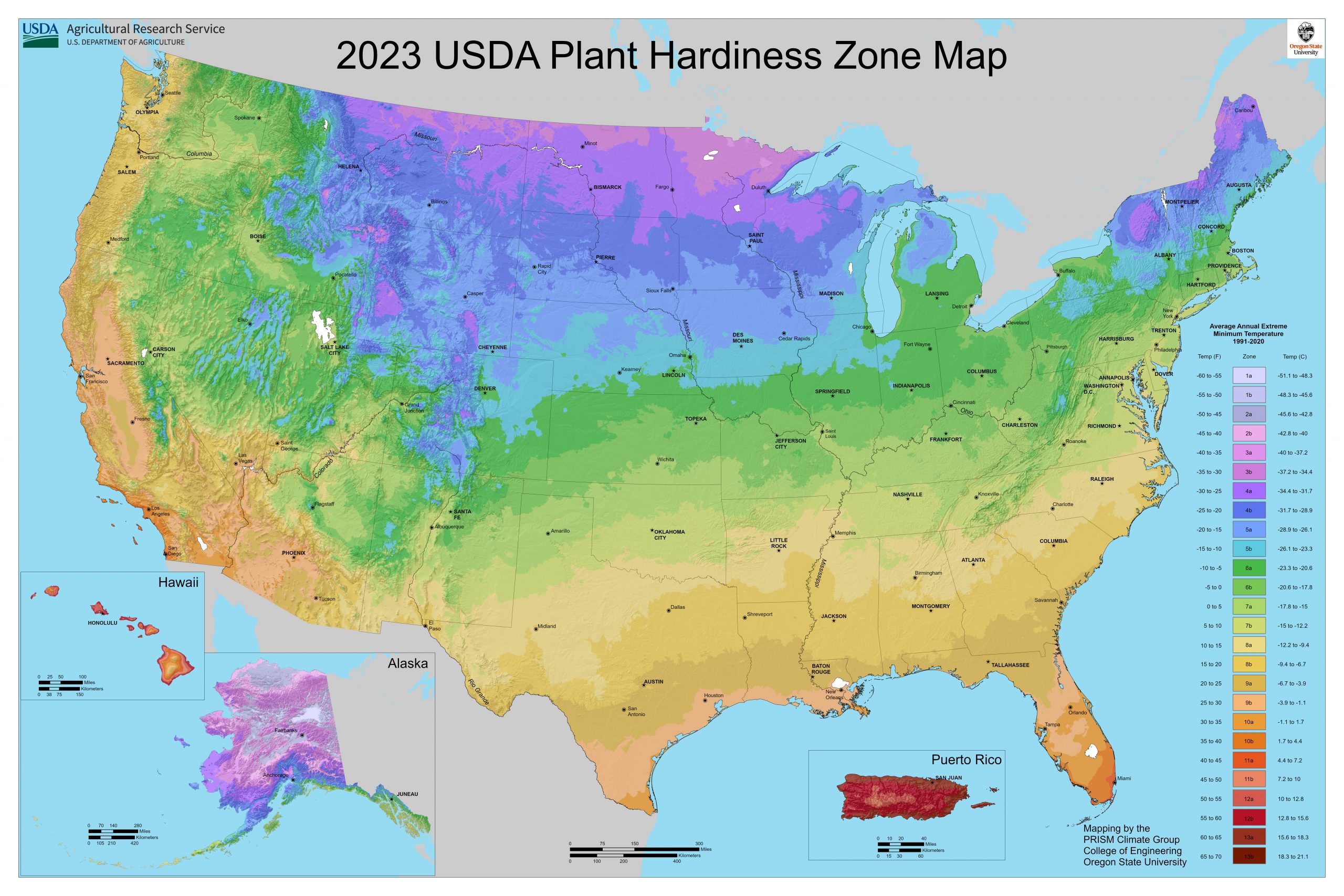HGEC Newspaper Articles
The UConn Home & Garden Center's horticultural consultants and affiliate staff write a weekly column that is submitted to The Chronicle, The Hartford Courant, and other local news outlets. Read our previous articles below.
2025
It’s Not Too Late! Plant Now for Fall Harvests
By Heather Zidack, UConn Home & Garden Education Center

Gardeners have had a broad range of experiences with their vegetable gardens this season. Some planted early in May with the warm weather, which was followed by a cold front that meant covering plants, or keeping them in pots longer than you had planned. For others, a pattern of cool, rainy spring weekends delayed planting! Cornell even sent out a reminder to residents to watch for tractors on the roads a little later this season as farmers, too, were scrambling to adjust in upstate New York. Thankfully, there is still plenty of growing season left for us to shift our practices and still have a bountiful harvest from our home gardens.
There are roughly 100 days left of the growing season until the first predicted frost date, according to the farmers’ almanac. That means you have an opportunity to still plant your dream vegetable garden! Look at the “days to maturity” to determine if planting now makes sense. Many summer crops, like zucchini, cucumbers, and even some types of winter squash have much shorter days to maturity and can be started from seed right in the warm, summer soil.
Have a type of bean, radish or leafy green you love, but can’t process bushels at a time? Plant every couple of weeks this month for a staggered harvest to enjoy your favorites for an even longer period at a more manageable volume!
Do you plan to harvest garlic this month? Be ready to follow up with a short-term crop like leafy greens, beets, carrots, or even some types of corn!
The practice of succession planting gives gardeners a chance to extend the garden season and promotes soil health by keeping your garden beds active. Rotating crops in this fashion reduces the risks of soil erosion, weed overgrowth, and nutrient depletion, when done correctly.
When setting up a succession or rotation schedule, consider what has been in the bed previously and how those plantings might interact. Determine the nutrient needs of the plants you are considering. You want to be sure you are not planting one heavy feeder right after another as this may mean you need to provide more nutritional support than you planned for. Instead, opt for plants that feed on different nutrients, or better still, plants that help to reintroduce nutrients into the soil.
Succession planting and crop rotation not only benefit the garden beds that have been put on the back burner as we’ve tried to find time between the rain and temperature swings, but it may also benefit those who have a history of battling with garden pests. Planting later in the season may help prevent or minimize damage from many single generation pests, like the Squash Vine Borer or the Four-Lined Plant Bug.
Many Cole crops (those in the brassica family) and cool season crops can be started from seed now in preparation for fall planting. However, it may be best to start these indoors instead of directly sowing in the ground. Temperatures over 85 may cause delayed germination or bolting too early once those plants pop out of the soil. Starting them indoors gives you a little more control over the temperature. Otherwise, search for heat tolerant varieties for better results.
If you want a rest from the care of vegetable gardening and harvesting, consider planting annuals. There are many varieties of marigold, cosmos, zinnia, and some other beautiful cut flower varieties that could happily take up some space and lend their services to some late season table arrangements for you!
There’s a lot to still do if you want a bountiful fall harvest, and there are a lot of considerations to make when planning what to plant next. Do your research with cooperative extension or land-grant university resources for science-backed information to guide you in your next steps. And remember, we’re here at the Home & Garden Education Center to help you make sense of it all!
The UConn Home & Garden Education Center supports UConn Extension’s mission by providing answers you can trust with research-based information and resources. For gardening questions, contact us toll-free at (877) 486-6271, visit our website at homegarden.cahnr.uconn.edu, or reach out to your local UConn Extension center at cahnr.uconn.edu/extension/locations.
This article was published in the Hartford Courant July 12, 2025
Hyped for Hydrangeas
Nick Goltz, DPM, UConn Home & Garden Education Center, UConn Plant Diagnostic Lab
When I moved to Connecticut in July of 2021, I remember driving through neighborhoods looking for somewhere I might eventually want to live and being struck by the beautifully-landscaped yards that each home seemed to showcase. I particularly remember being impressed by the tidy hedges of hydrangea, filled with lush globes of blue, pink and purple flowers. Can you think of a flower more emblematic of breezy, long summer days by New England coast than the hydrangea? I’ll wait.
Hydrangeas are a fascinating group of perennial plants with some unique quirks that make them a fun addition for the home garden. The genus is native to Asia and North America, but the species grown most commonly around the world, Hydrangea macrophylla, is native to Japan and has been bred extensively for hundreds of years, resulting in many cultivars. They are also bred with other species to help select for cold tolerance or inflorescence (flower cluster) shape.
Hydrangea macrophylla are commonly known as “bigleaf hydrangea”, but may also be called “lacecap” or “mophead” hydrangea, depending on the shape of the cultivar’s inflorescence. While many species of hydrangeas have white flowers, bigleaf hydrangeas are prized for their beautiful inflorescences that act as a natural pH indicator of the soil the plants grow in. The petals of flowers will change depending on how basic or acidic the soil is. Flowers will be blue, indigo, or deep purple in acidic soils with a pH of 5.5 or less. Plants gown in a slightly acidic soil with a pH between 5.5 and 6.5 will have a mix of purple hues. Hydrangeas grown in neutral to basic soils with a pH greater than 6.5 (especially 7 and up) will generally have fuchsia to pink-colored flowers. Many gardeners will amend the soil of their hydrangea beds from year to year to achieve the color that they hope for.
Many folks know of the color-changing capabilities of hydrangeas, but keep reading for a few tips on how to properly care for them beyond adjusting soil pH. Hydrangeas prefer moist, well-draining soil and a sheltered spot with partial shade. Some cultivars tolerate full sun well, but must be watered consistently to look their best. Hydrangeas do not grow exceptionally large and are considered “low fire risk”, so are a better choice for planting near the home.
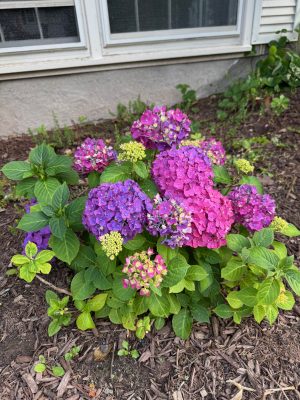
There’s a reason why coastal New England towns seem to be filled with hydrangeas while interior towns, particularly for our friends in Vermont, western Massachusetts, Maine, and New Hampshire, have fewer. Bigleaf hydrangeas can tolerate cold temperatures, but only to an extent. Depending on the cultivar, bigleaf hydrangeas grow best from zones 6 to 8. Most cultivars will survive zone 5 winters, but might not flower well without protection – harsh winter temperatures, especially when paired with low snow cover, can kill flower buds.
Flower buds form on old growth for most cultivars of bigleaf hydrangea. Because of this, many folks will accidentally prune away flower buds in winter, resulting in poor flower production come summer. For this reason, it’s important to never prune bigleaf hydrangea in fall, winter, or spring. Only prune away the bare stems from the previous year when you see that no new growth is being produced from them, or in summer when collecting flowers for the vase on your kitchen table!
If you find the twiggy winter appearance unsightly and can’t help but prune, if you struggle with deer feeding, or if you live in an area with common late spring frosts, consider planting a “reblooming” bigleaf hydrangea. There are a few cultivars, such as ‘Endless Summer’ and sports, that will produce flower buds on old growth and (usually) a second flush on new growth. Alternatively, you could plant other species of hydrangeas, such as smooth hydrangea (Hydrangea arborescens), or panicle hydrangea (Hydrangea paniculata), which tend to be a little more cold-hardy, or oakleaf hydrangea (Hydrangea quercifolia), if you’re looking for a hydrangea for an area with very hot summers.
If you have questions about growing hydrangeas, or any other gardening topic, call the UConn Home & Garden Education Center (toll-free) at (877) 486-6271. You can also email us at ladybug@uconn.edu, visit our website, www.homegarden.cahnr.uconn.edu, or visit your local UConn Cooperative Extension center.
This article was published in the Hartford Courant and The Westerly Sun July 5, 2025
Plants Enjoy Summer Too!
By Dr. Matthew Lisy, UConn Adjunct Faculty
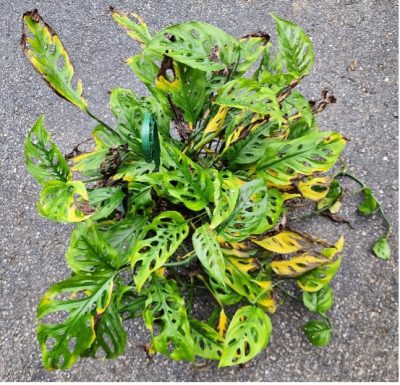
A summer vacation can be beneficial for our houseplants provided that we pay attention to some abiotic (nonliving) factors. Plants need time to adapt to new growing conditions or they can have deadly consequences. Try and make the change as gradual as possible. I usually wait until the end of May, where temperatures are consistently in the 70s for the highs, and no lower than 50s for the lows.
Our plants cannot go from dim, indoor lighting to super bright full sun outside. Any leaves subject to this will burn and die. The best way to acclimate plants to life outdoors is to place them in the shade of a large tree for about a week, and then gradually expose them to some direct sunlight. At first, start with only an hour or two of sun, and then add a bit more the following week until you transition them to full sun. This is assuming that the plants in question are ones that need full sun. Cacti and succulents can generally be transitioned to full sun (one notable exception are the forest cacti).
Most of our houseplants are actually forest-floor species or epiphytes (these grow and live on the trunks of other trees). Either way, those two groups of plants grow in the understory shade of a larger tree in nature, and do well there over the summer. Some plants I saw recently for sale were called neon philodendron. These have light green leaves (similar color to neon pothos). The light was so intense that it bleached the leaves to a pale-yellow color, and some were turning brown. The plants looked miserable, and the grower said she was going to move them to a shadier location.
I am not sure why we cannot have normal weather, but it seems we have had either too dry or too wet the last five years. When it rains consistently, it keeps our plants in a constantly moist state, which leads to root rot. I lost a few really nice philodendrons due to them being too moist in last summer’s constant rain. The ideal setting would have the plants exposed to good light while under cover. This way, the gardener can water them appropriately based on the needs of each plant. If this is not an option, repotting and adding some extra perlite to the mix will help the pot shed the excess water. Be sure to remove the saucer from the pots and hanging baskets while the plants are outside. These will hold excess water and keep the plants in a constantly moist state and favor fungal infections.
A pot or hanging basket may only have about a gallon or two of soil at best, and will dry out quickly in the heat. Depending on your soil type, it may be almost impossible to water enough. Try to avoid full sun in the hottest part of the day between noon and 2:00 p.m.
In an exposed location, wind can rapidly desiccate, windburn, or break plants. A good friend of mine with a large houseplant collection in the Midwest had almost everything he owned blown over and damaged when a tornado swept through his town last summer. Although he did not experience a direct hit, the winds were so bad it ruined many of his mature plants. I told him to look at it like an unintentional propagation event. When vining plants are grown in hanging baskets, they sometimes start to cling to the branches around them and rip in the wind.
Hopefully this article will help plants enjoy their summer vacation. It is a great time for plants to grow and be propagated. Be careful of the extremes of summer, and give the plants a gentle exposure to the outdoors.
The UConn Home & Garden Education Center supports UConn Extension’s mission by providing answers you can trust with research-based information and resources. For gardening questions, contact us toll-free at (877) 486-6271, visit our website at homegarden.cahnr.uconn.edu, or reach out to your local UConn Extension center at cahnr.uconn.edu/extension/locations.
This article was published in the Hartford Courant and The Westerly Sun June 21, 2025
Put an End to Blossom-End Rot: Water and Nutrient Management is Key
By Nora Doonan, UConn Soil Science Graduate Student, Department of Plant Science & Landscape Architecture
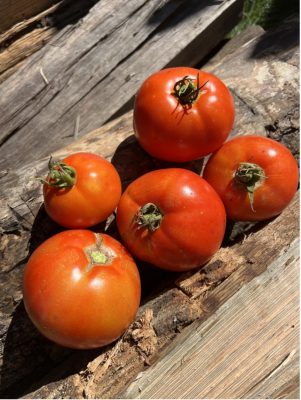
It can be frustrating to put time and energy into growing tomatoes, only to find that your tomatoes have developed blossom-end rot. Blossom-end rot is a physiological disorder that commonly affects tomato plants, characterized by a black, sunken spot on the fruit. This disorder is caused by insufficient calcium as a result of nutrient and water management challenges. Blossom-end rot can also affect peppers, eggplants, squash, and watermelons. In tomatoes, it is commonly seen on larger and elongated varieties, which can have a greater demand for calcium. Calcium is an essential plant nutrient that is required for proper growth, especially for the development of cell walls in the tomato fruit. When a fruiting tomato plant experiences calcium deficiency, the cell wall can collapse and show the appearance of blossom-end rot. Soil tests can reveal if your soil has sufficient levels of calcium and can determine if your soil pH is optimal for nutrient availability.
Oftentimes, the soil is sufficient in calcium levels, but blossom-end rot still occurs. Blossom-end rot can be closely associated with soil moisture that is too wet or too dry. The soil should never dry out completely. It is important to water regularly to ensure that plants receive 1 to 2 inches of water a week. A cycle of dryness followed by overwatering is only promoting calcium deficiency in the plant. If soil is too saturated, there may be insufficient oxygen levels in the soil that can affect the roots’ ability to take up water and nutrients.
One method of maintaining optimal soil moisture is to mulch tomato plants with an organic mulch, such as wood chips or straw, after the soil has warmed up. This will help to prevent excessive evaporation and drying of the soil. Another method is to plant tomatoes in a mound of soil that is high in organic matter or compost. Organic matter can retain soil moisture and provide adequate drainage.
There are other factors that can affect calcium uptake by the plant, such as high concentrations of ammonium, potassium, and magnesium in the soil. This can be caused by over fertilization. Specifically, over fertilizing with nitrogen can promote excessive production of leaves in the tomato plant, which can preferentially distribute calcium to the leaves rather than the fruit.
Calcium movement in the plant is dependent on transpiration, which is the loss of water to the atmosphere from plant leaves, stems, and flowers. Calcium is taken up through the roots and relies on water flow through the xylem for transport through the plant. This movement of water through the xylem is driven by the process of transpiration. Calcium is not redistributed from the leaves to the fruit. In addition, the overfertilization of ammonium, potassium, and magnesium can allow for competition in root uptake of calcium because they are all positive cations. Damages to roots, caused by fertilizer burns or cultivation, can also be a factor in impairing nutrient and water uptake. To prevent blossom-end rot through fertilization practices, apply fertilizer as recommended by a soil test and apply nitrogen fertilizers in the form of nitrate, rather than ammonium.
Any affected fruits can be removed from the plant, as they will continue to drain moisture and calcium for development from other fruits. A foliar application of calcium can be made to the leaves when the fruit is young, but it is not the most effective method, since calcium in the leaves is relatively immobile. The goal is to prevent the need for foliar application through water and nutrient management across the tomato plant growth stages. Hopefully these methods will allow you to prevent blossom-end rot starting at beginning stages of growth, so that you can enjoy a bounty of beautiful, red tomatoes.
The UConn Home & Garden Education Center supports UConn Extension’s mission by providing answers you can trust with research-based information and resources. For gardening questions, contact us toll-free at (877) 486-6271, visit our website at homegarden.cahnr.uconn.edu, or reach out to your local UConn Extension center at cahnr.uconn.edu/extension/locations.
This article was published in the Hartford Courant June 14, 2025
Put in the Work Now for Lasting Garden Beauty
By Heather Zidack, UConn Home & Garden Education Center
If you’re planning to do some landscape renovations this summer, you will often hear the suggestion of doing certain tasks “until the plant is established.” If you’ve heard this phrase and wondered what the pros mean, you’re not alone. It’s crucial to understand that the first year of growth is one of the most critical to ensure the success of trees, shrubs and perennials in the landscape.
The “establishment period” is when a newly transplanted plant pushes roots beyond the original root ball to anchor itself into the surrounding soil and adapt to its new environment. Establishment happens in as little as 2-4 weeks for your veggie starts and other annuals. However, if you are installing woody ornamentals or perennials, it is recommended to provide support for their first year in the landscape. Some species, especially fruiting plants may need longer attention to ensure establishment and landscape success.
Keeping the plants properly hydrated is going to be your first line of defense in preventing transplant shock. Using sprinkler systems for supplemental water can be problematic for trees, shrubs and perennials. These systems, especially those designed for lawns, maintain moisture in the top 1-2 inches of soil. Our non-turf plants need much more. Providing adequate water will help new plants acclimate by providing sufficient hydration, but it will also encourage the root system to expand. Roots pull moisture and nutrients from the soil but also act as an anchor to keep the plants upright. Keeping only the top few inches of soil moist will encourage roots to stay in that shallow layer instead of expanding deeper into the soil, hindering the development of that anchoring system. Additionally, watering demand tends to be more frequent with shallow root systems, as the first few inches of soil are more susceptible to drying out on sunny days. Lastly, the shallow roots need to compete with established turf for resources at a 1-2-inch depth.
While in this establishment period, the standard watering recommendation is 1-2 inches per week, depending on the species of plant. An inch of water is equivalent to 0.62 gallons per square foot of garden area. Watering the plant at this rate encourages it to stretch its roots downward into the soil. With deeper roots, plants can find moisture even during times of temporary drought deep below ground. This is a huge contribution to drought tolerance, as opposed to the common belief that the plant will just “live longer without water.”
If the forecast does not predict an inch of rain within the week, gardeners should be out checking the soil for moisture a few inches down and providing supplemental water if necessary. Always check the soil before watering, especially if you are new to gardening. Squeeze the soil in your hand. If the soil particles stick together easily, it is likely that there is enough moisture. If soil clumps fall apart between your fingers or the texture is dusty, the soil is too dry and more water is needed. If you can squeeze water out of the soil like a sponge, there is too much moisture, and you should come back and check in a day or two. Overwatering can lead to root rot and other diseases and finding the balance is a fine-tuned skill developed over time.
Monitor your new plantings for the first year and watch for signs of transplant shock, pests and disease so that you can adjust quickly and keep your plants healthy during this time. While transplant shock is a normal response to being planted in a new location, the symptoms can be startling to gardeners. Remember that the UConn Home & Garden Education Center is here to help you determine if you are looking at transplant shock, disease, or possible pest damage. It’s easier to catch and treat issues earlier than it is to react at the end of the season. If you’re vigilant, we can help you find your way to solutions much more quickly!
Staking should only be done as a temporary measure for young trees where the environment or the species of tree requires extra support. In most cases, trees should be perfectly capable of supporting themselves. Exposure to the elements, like the occasional strong breeze, can help to strengthen them as they adjust. However, temporary staking can help take some of the stress off the young trees if they are establishing in harsher environments. While there are many situations that may be appropriate, consider staking newly planted trees when they are in open areas, have high wind exposure, or are in an area that risks mechanical or physical damage. Staking may also be appropriate if the root ball is significantly smaller in relation to the tree’s size, or if the tree has a top-heavy canopy.
Once your plants are well anchored into your landscape, they will be able to find water and nutrients on their own while standing tall in the face of our New England climate. Putting in the attention and care to help plants establish in their first year or two in the landscape will reward you with many years of enjoyment to come.
The UConn Home & Garden Education Center supports UConn Extension’s mission by providing answers you can trust with research-based information and resources. For gardening questions, contact us toll-free at (877) 486-6271, visit our website at homegarden.cahnr.uconn.edu, or reach out to your local UConn Extension center at cahnr.uconn.edu/extension/locations.
This article was published in the Hartford Courant June 7, 2025
Spring Showers Bring Flooded Gardens
By Amelia Martin, UConn Plant Science Graduate Student
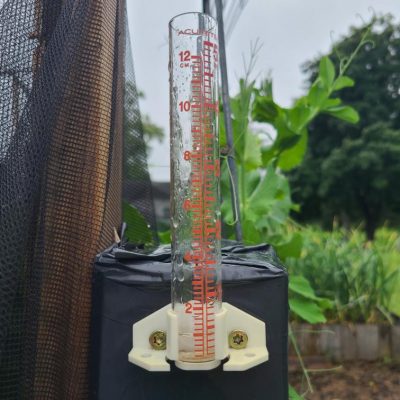
You may have noticed the heavy rains and chilly temperatures last week’s nor ’easter brought to Connecticut. Maybe you were one of many who checked their back window to see their gardens had flooded and their plants are looking worse for the wear. If this sounds familiar and you are curious what garden flooding means for your plants and want to know how to protect them- you found the right article!
A flooded garden is not a unique problem, especially during periods of heavy rainfall, but there are some factors that may contribute to the severity of flooding. Having minimal or poor drainage can amplify the problem, especially if planting in garden boxes with closed bottoms. Soil compaction can contribute to flooding if you are planting directly in the ground. Compacted soil can happen if there has been too much tillage, if wheels or machinery have been over the area, or even from excess foot traffic. Lastly, the layout and landscaping of a yard can contribute to flooding as well. If you placed your garden at the bottom of a hill or there are minimal drainage angles surrounding your garden, water may be pooling up faster than it can drain.
To prevent flooding, check your gutters and make sure they are free from debris and directed to a drain or storm barrel. Put down gravel and mulch to help prevent surface flooding. Avoid cutting your grass too short to maintain strong roots which help to absorb water. Maintain healthy soil to allow for the best water absorption. Dig out a shallow drainage channel if you have the space for it. Consider switching to raised beds with drainage rather than in-ground gardens in easily flooded areas. Try adding native plants to your garden. Native plants have deep roots which helps them absorb excess water and prevent runoff. While handling these issues would be preventative measures, let’s talk about what to do if your garden has already flooded.
Assess the drainage situation and take note of where the water is pooling the most. If flooding is unusual in your garden- there may be something blocking the normal drainage route, which may be a quick fix. If not, knowing where water is likely to pool may help in future garden planning, or help you determine where to make improvements.
Stay off your garden beds. If you step on your soil while it is saturated, it will compact it, ruining the soil’s tilth. Instead, if you need to access your garden beds consider putting a wooden board down to walk on to distribute your weight better.
Re-fertilize your plants. Heavy rain can wash away nutrients out of the soil through a process called leaching. Check the forecast to make sure no more extreme weather is immediately approaching before fertilizing- or you may have to do it again.
Add supports to your plants. The wind and rain may have led to plants falling over. Add in some additional supports to get them upright again and give them a better chance for the next time heavy rain comes.
While having a flooded garden may be a bummer, there are some gardening activities that are actually easier to do in saturated soil! Once the rain stops and the ground is still wet, use this time to weed. The soft ground will make weeds especially easy to pull up- just try not to step on the garden beds. After a rain or a flood, re-mulching is always a good idea. The rain might wash away some previously placed mulch, use this as an opportunity to locate any spots barren of mulch and in need of a re-fill. After a couple days when the soil is soft but not sodden, the ground will be the perfect consistency to dig and put stakes.
Lastly, check for any young plants that didn’t survive the water or any seeds that haven’t come up. Take this as an opportunity to plant new seeds, as seeds do better in already moist soil where they have less chance of being displaced when watered.
At the end of the day, while having a flooded garden may not be the best for your plants, it is not the end of the world. There are a handful of preventative measures that can be taken ranging from backyard renovations to quick fixes- it is about finding what works best for you and your garden.
The UConn Home & Garden Education Center supports UConn Extension’s mission by providing answers you can trust with research-based information and resources. For gardening questions, contact us toll-free at (877) 486-6271, visit our website at homegarden.cahnr.uconn.edu, or reach out to your local UConn Extension center at cahnr.uconn.edu/extension/locations.
This article was published in the Hartford Courant May 31, 2025
Why Are Seeds Sprouting in My Tomato?!
Nick Goltz, DPM, UConn Home & Garden Education Center, UConn Plant Diagnostic Lab
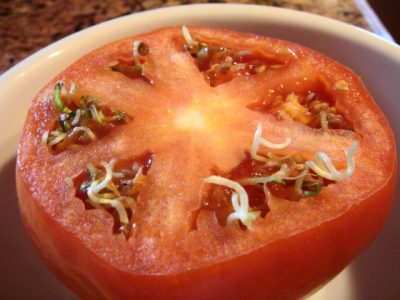
UConn Home and Garden Education Center alum Carol Quish wrote a short blog post about vivipary in 2014 that, over a decade later, is still one of our most-read pieces. Why are folks still interested to read this post after so much time? Because seeing seed vivipary in a tomato you’re about to eat is just so darn weird. To better discuss and understand vivipary however, we should start with a little refresher on seed biology.
Reflecting back on 4th period science class with Mr. So-and-so, you’ll recall that producing a seed is both a distribution and reproduction strategy for plants. Generally, a seed is composed of a developing young plant called an embryo and a nutritious tissue to support the embryo called an endosperm, both of which are encapsulated within a hard seed coat. When an embryo is triggered to begin growing and breaks through the seed coat, many people consider this the stage of germination.
A seed will typically be in a state of dormancy while within the fruit and for a period after fruit harvest and dispersal. This strategy of undergoing dormancy is usually advantageous to the seed so it does not germinate and begin growing under adverse conditions, such as the beginning of winter or before being eaten by a hungry critter. A delicate combination of environmental cues and plant hormones maintain – and break – seed dormancy. When temperature, light, moisture, and other environmental conditions are right for that seed, hormones like gibberellin (GA) and abscisic acid (ABA) will shift in balance and germination will occur. Dormancy is typically maintained when levels of ABA are higher than levels of GA, and is broken when levels of GA are higher than levels of ABA.
When germination occurs while the seed is still within or attached to tissue of the parent plant, this is considered vivipary. Appropriately, the word “vivipary” is Latin for “live birth”. Vivipary is an essential strategy for some plants, such as mangrove trees, to increase likelihood of reaching a safe place to grow. For most plants however, vivipary is considered a physiological disorder or otherwise undesirable outcome as it decreases likelihood for successful establishment and growth, post-germination. Some highly-domesticated plants, like tomatoes, peppers, strawberries, wheat, and corn, are more prone to vivipary than others.
Seed germination within an overripe tomato. Photo credit: J. Copes.
While there isn’t uniform consensus on what combination of factors trigger vivipary, promoting high ABA levels in seeds while they’re still in the parent plant will certainly lower the odds. While there is nothing that can be done to change the genetics of the tomato on your counter, you can take steps to minimize the environmental triggers that would decrease ABA levels. Minimizing free moisture, preventing excessively cool temperatures, and drying, consuming, or processing the seed before the fruit bearing it become overripe are important strategies.
For tomatoes specifically, be sure to harvest them before they are fully ripe! Overripe tomatoes are much more likely to experience vivipary. For the same reason, whether buying or growing your own vine-ripened tomatoes, it’s important to consume them quickly. Furthermore, be sure to store your tomatoes at room temperature and not in the fridge. Not only will they be more likely to have a mealy texture when you eat them, but low temperatures may also increase the likelihood of vivipary.
The next time you happen to take a bite of a tomato filled with seeds that have experienced vivipary, don’t fret! The taste and texture may not be what you were expecting, but they’re perfectly harmless. That said, a better destination for a viviparous tomato may be your garden bed rather than your caprese salad! Seeds that have germinated within the fruit will still grow and eventually produce fruit like any other tomato seedling.
If you have questions about growing tomatoes, or any other gardening topic, call the UConn Home & Garden Education Center (toll-free) at (877) 486-6271. You can also email us at ladybug@uconn.edu, visit our website, www.homegarden.cahnr.uconn.edu, or visit your local UConn Cooperative Extension center.
This article was published in the Hartford Courant and The Westerly Sun May 24, 2025
Set Your Lawn Free
By Dawn Pettinelli, UConn Home & Garden Education Center
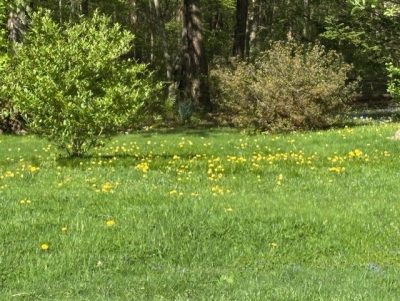
For many, the sight of a lush green lawn brings about the desire to cast off one’s shoes and stroll through the sun-warmed grass feeling the soft verdant carpet below. Lawns, or at least grassy areas, are a ubiquitous part of almost every home outside city limits. While admittedly that perfect lawn is a source of curb appeal and homeowner pride, in recent years considerable attention has been given to the ecological and environmental costs of maintaining turf that is the envy of the neighborhood.
Managed turf grass areas, including golf courses and park areas cover about 8 percent (400 square miles) of the land area in Connecticut. That perfect lawn typically requires supplemental irrigation, fertilizer, regular mowing and often pesticide applications. Water could be better used for drinking, other domestic uses and just left in natural systems. Excess nutrients as well as pesticides can be found in ground and surface waters causing both human health as well as ecosystem problems. While some are turning to electric mowers and blowers, gas-powered equipment dependent more on fossil fuels, are most prevalent (at least in my neighborhood) contributing to climate change.
So what is a residential lawn owner to do? The authors of Redesigning the American Lawn were among the first to coin the term “freedom lawn.” So, what is a freedom lawn? Basically, anything that is green is allowed to grow. That would include dandelions, self-heal, violets, bluets, buttercups, clover and wild strawberries to list a few of those so-called “low growing broad-leaved plants”. By my definition, weeds are plants growing in the wrong place, so the plants are weeds no longer when accepted as part of the lawn.
One of the greatest reasons for encouraging a variety of plants to inhabit turf areas is that the world is facing a critical loss of biodiversity. There are significant declines in beneficial insect, native plant and bird populations, along with other living organisms. While that lush green lawn offers aesthetic pleasure to some, it does little to provide habitat or food for creatures other than problematic ones like grubs or chinch bugs.
A mixed grass- herbaceous plant lawn will contain flowering plants for pollinators and other beneficials. Various plant species have varying root systems. Some have deep taproots that break up compacted soil and bring up minerals. Others have more fibrous root systems that are continuously turning over added organic matter to the soil. A variety of plants along with their root exudates and associated microbes can help aggregate the soil, improving air and water passage. Porosity plus water holding capacity can be increased as well as lessening the potential for topsoil erosion. A healthy plant community usually portends a healthy soil.
Leaning into a freedom or pollinator lawn does not mean digging up one’s entire lawn and reseeding it although that is one option. Two seed mixes that I have seen advertised are Flawn and Fleur de Lawn. Both contain a mixture of fescues, microclover and the latter, some other flowering species. Probably greatest success with these seed mixes would be achieved starting with bare soil.
One can start encouraging biodiversity and pollinator plants by discontinuing the use of herbicides and allowing some flowering plants to move in. Often, they can be mowed before they set seed. When reseeding bare spots, use more drought tolerant fescues or native grasses like little bluestem to reduce the need for irrigation, once established. Higher mowing heights up to 3 or 4 inches will encourage deeper rooting of all plants making them more resilient during periods of drought.
Learn about the benefits of some of the low-growing broad-leaved plants that want to call your lawn home. Clovers add nitrogen to the soil reducing the amount of fertilizer necessary. Violets are host plants for the endangered regal fritillary. Dandelion greens are a great source of vitamins A and C. It is true that many of these plants are not native, but neither are the cool season turf grasses normally found in lawns.
In many yards, keeping part of it in lawn is essential for children’s play and sports activities, pet areas and entertaining. Take a tour of your yard and determine where a lawn makes sense and where it might be more appropriate for woody plants, ornamental beds or even a vegetable garden. Steep slopes or perpetually shaded areas may be best for groundcovers. Areas where water frequently collects after heavy rains might be more suitable for a rain garden.
However small, every effort to encourage biodiversity, provide for our beneficials and improve soil health is a step in the right direction. Rethinking your lawn areas might be a good place to start.
For information on lawns or any other gardening topic, call the UConn Home & Garden Education Center (toll-free) at (877) 486-6271 or email us at ladybug@uconn.edu or visit our website, www.homegarden.cahnr.uconn.edu.
This article was published in the Hartford Courant May 18, 2025
Spring Landscape and Garden Issues in 2025
By Pamm Cooper, UConn Home & Garden Education Center This spring has been a dramatic one as ornamental trees and shrubs are putting on quite a colorful floral display. Many deciduous ornamentals including redbuds, forsythia, crabapples, fruit trees, quince azaleas and many others were not adversely affected by last summer’s drought and the cold, windy winter and frozen soils that followed. A lesser noticed but significant drama is the negative effect these same environmental conditions had on ornamental and native evergreens.
Rhododendrons and ‘Green Giant’ arborvitae seemed to suffer the most damage followed by cherry laurels and hollies. Last year’s drought conditions that extended into late fall combined with very windy winter conditions and frozen soils were tough for some evergreens. Winter desiccation injury on broadleaved and needled evergreens causes foliage browning when plants cannot take up the water needed to keep foliage healthy. Damage to many rhododendrons and some azaleas could be seen during the winter and is still evident this spring. Buds may provide new leaves by June if branches are still alive.
In contrast, 'Green Giant’ arborvitaes suddenly showed symptoms after warm weather began this spring. This was evident especially in trees on windy sites. Needles are brown or off color and time will tell if they are able to recover. If branch tips are flexible and show new buds, growth may resume. Prune any dead branches that show no signs of recovery.
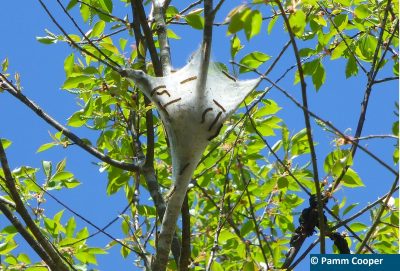
Eastern tent caterpillars have hatched from overwintering egg masses on native black cherries. Silken nests are evident located in crotches of these trees. Caterpillars feed outside the tents at night and hide in them during the day. There is only one generation, and feeding is generally finished by late June. Trees have time to leaf out again to remain healthy during the growing season. Birds like cuckoos and vireos will rip tents apart to feed on the caterpillars.
If you have Oriental lilies, be alert for the lily leaf beetle. This bright red insect can severely defoliate these lilies. Adults overwinter in soil close to the plants they were feeding on the previous season. They appear as soon as lilies begin new growth above the ground. Leaf undersides should be checked for eggs and larvae and crushed when found. Leaves can be treated if needed with a product that larvae will ingest as they feed on the treated leaves. Never spray flowers with any insect control product and always follow directions as written on the product label.
Snowball aphid feeding damage is noticeable on the new leaves of European cranberry bush and snowball viburnums. As the aphids feed on the new leaves and twigs, leaves curl and twigs twist in response to aphid feeding on the sap. Aphids can be found by uncurling the leaves. Treatment is difficult as they are not out in the open where contact control products can reach them. Feeding should end within two months of egg hatch. These aphids overwinter as eggs laid on the branches of host viburnums.
Viburnum leaf beetles, Pyrrhalta viburni, are another significant pest of ornamental and native viburnums. They’re active soon after viburnums leaf out. Damage will be seen as larval populations grow and they skeletonize leaves. Some viburnums may suffer complete defoliation. This pest prefers arrowwood, European cranberry bush or American cranberry bush viburnums. Try switching to resistant varieties such as V. plicatum and Korean spicebush viburnum V. calesii if leaf beetles are a chronic pest.
If anyone has small St John’s wort shrubs or certain weigela cultivars that seem to be dead, wait and see if new growth resumes as it gets warmer and sunnier. The smaller St. Johns’ wort shrubs die back in fall, leaving brown stems with withered fruit. Prune these back almost to the ground as basal growth appears. Some weigela cultivars are just slowly getting started, while others are already full of leaves. Do not give up these plants but wait and see what happens in May.
As always, our UConn Home and Garden Education Center office staff welcomes any questions gardeners may have concerning landscape and garden plants problems. Across the New England region, people are having much the same problems as we are having in Connecticut from the winter weather, but we can hope that plant recovery be swift and complete. Enjoy the growing season and stay alert- scout for pests and other problems before they get out of hand.
The UConn Home & Garden Education Center supports UConn Extension’s mission by providing answers you can trust with research-based information and resources. For gardening questions, contact us toll-free at (877) 486-6271, visit our website at homegarden.cahnr.uconn.edu, or reach out to your local UConn Extension center at cahnr.uconn.edu/extension/locations.
This article was published in the Hartford Courant May 10, 2025
A Gardener’s Guide to Planting by Hardiness Zones
By Marie Woodward, UConn Home & Garden Education Center

If you are wondering whether that shrub, flower, or tree that you saw in a magazine or catalog will grow well in your garden, using a hardiness zone map is your best bet to ensure success.
A hardiness zone map is a tool that divides a geographical area into distinct zones based on average annual minimum winter temperatures. These maps are used by gardeners and farmers around the world to determine which plants are most likely to thrive in a particular region. Each country has its own hardiness map that correlates to their climate. In the United States, the USDA publishes a hardiness zone map, which covers all fifty states and includes Puerto Rico, Guam, American Samoa, and the U.S. Virgin Islands. It uses climate data collected over many years from weather stations throughout a specific region. Then the data is analyzed to determine average minimum winter temperatures from different areas.
The concept of hardiness zones was first introduced in 1927 by Dr. Alfred Rehder. Rehder worked at Harvard's Arnold Arboretum as a botanical taxonomist. He wanted to address the challenges gardeners and growers faced in selecting plants suited to their local climate. Prior to Rehder’s map, there was no standardized system for categorizing plants based on their ability to survive winter temperatures. His hand-drawn map featured eight hardiness zones and was based on the lowest winter temperatures recorded in various regions across the country. Rehder aimed to provide a practical tool for gardeners and growers. His map made it easier for them to choose plants with the best chances of survival in their region, ultimately contributing to more successful gardens and agricultural endeavors. Rehder’s innovative approach recognized the importance of adapting agricultural practices to local climates. In the 1960s, the USDA adopted and adapted Rehder's concept, creating the first official USDA Plant Hardiness Zone Map.
Since its initial release, the USDA Plant Hardiness Zone Map has been updated several times to reflect changes in climate and the availability of more accurate data. The latest update of the USDA hardiness map was released in November 2023, jointly developed by the USDA's Agricultural Research Service (ARS) and Oregon State University's PRISM Climate Group. This update incorporates data from 1991 to 2020, covering a broader range of weather stations than previous versions. One of the key findings from this update is that the contiguous United States has become approximately 2.5 degrees Fahrenheit warmer on average compared to the previous map. As a result, around half of the country has shifted into the next warmer half zone, while the other half has remained unchanged. The updated map still consists of 13 zones, but now offers more detailed information on temperature ranges within each zone, including 10-degree zones and 5-degree half zones. Connecticut has two hardiness zones each of which is divided into half zones; (6a,6b); (7a,7b), to better reflect the temperatures in the state over the past few decades.
The importance of hardiness zones lies in their ability to help gardeners and farmers choose plants that will thrive in their specific region. By selecting plants appropriate for their zone, growers can reduce the risk of frost damage and increase their chances of a successful growing season. However, due to unexpected temperatures outside the average range, there is no guarantee that a plant won’t suffer but it does reduce the risk of plant damage. In addition to gardeners, researchers use hardiness zones to study the spread of insects and exotic weeds, while the USDA Risk Management Agency uses the map to help determine crop insurance rates for commercial growers.
While the USDA Plant Hardiness Zone Map is an invaluable tool, it is important to note that it is not the only factor gardeners and farmers should consider when selecting plants. Other factors, such as soil type, precipitation, and local microclimates, can also impact plant growth and survival. Gardeners should use the map as a starting point and supplement it with local knowledge and research to make the best plant selections for their specific needs.
The development of the USDA Plant Hardiness Zone Map is a testament to the importance of adapting agricultural practices to local climates. Since its inception nearly a century ago, the map has evolved to reflect changes in climate and incorporate more accurate data. Today, the map remains an essential resource for gardeners and researchers alike, helping them to better understand and navigate the complexities of plant growth in the diverse regions of the United States. Knowing a plant’s hardiness zone when selecting that shrub, tree or flower will help you grow the garden of your dreams.
The UConn Home & Garden Education Center supports UConn Extension’s mission by providing answers you can trust with research-based information and resources. For gardening questions, contact us toll-free at (877) 486-6271, visit our website at homegarden.cahnr.uconn.edu, or reach out to your local UConn Extension center at cahnr.uconn.edu/extension/locations.
This article was published in the Hartford Courant May 3 2025
Celebrate Arbor Day!
By Dawn Pettinelli, UConn Home & Garden Education Center

Arbor Day is celebrated in Connecticut on April 25th. Since it is a day traditionally set aside for the planting of trees, perhaps you might consider adding one to your home landscape. If you haven’t the need for another arboreal specimen, then plan on giving your existing trees a little TLC.
Trees have a lot to offer. They provide us with cool shade on hot summer days, brighten our spring season with lovely blossoms, add color to the fall landscape and winter interest throughout cold, dreary days. Trees provide food, nesting sites and shelter for many animals, especially birds. They help reduce noise pollution, trap particulate air pollutants, and can alter the microclimate surrounding them.
Most importantly, trees supply plenty of oxygen for us to breathe. Each year, an acre of trees produces enough oxygen to keep 18 people alive. They also sequester carbon dioxide. Trees convert atmospheric carbon dioxide into plant matter as they photosynthesize. This has important consequences worldwide. As more and more of our forested land is being cleared, less carbon dioxide can be stored in trees and more is available to increase the atmospheric carbon dioxide levels which, in turn, can contribute to global warming.
While we can’t stop global deforestation, we can make a difference in our own backyards by planting more trees or making sure that the trees already present receive the conditions they need to thrive.
When selecting a tree for your landscape, do consider factors like its ultimate height and spread, susceptibility to insect and disease problems, flowering, fruiting and fall foliage potential, rate of growth and site requirements. Review gardening books, consult with nurserymen and maybe visit an arboretum to view mature specimens.
Trees are purchased either as dormant stock through mail order sources, containerized, or balled-and-burlapped (B & B). Dormant trees generally arrive in the spring or fall and should be soaked for a couple of hours and planted immediately. If you can’t get them in the ground right away, they can be stored in a cool place for a few days out of direct sunlight. Make sure them are kept moist.
Containerized stock can be planted throughout the growing season although cooler spring or fall is best. Hard to transplant species are best purchased this way as there is less disruption to their root system. If potbound, make several vertical cuts about one-quarter inch deep around the root ball before planting.
Purchasing B & B trees is fine for younger specimens, but often larger trees have a good portion of their roots removed in this process. This can lead to poor survival. For greatest success, choose small to medium sized trees.
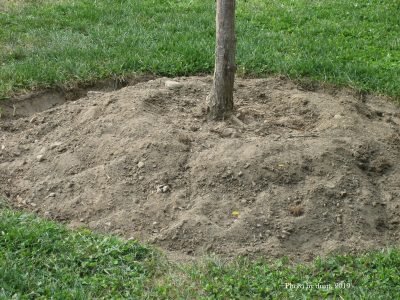
Holes for planting only need be as deep as the root system. The key is to make them at least 2 feet wider than the root ball. Especially in heavy or compacted soils, be sure to
loosen as much soil around the planting area as possible so roots can grow freely. The majority of roots are found in the upper 3 feet of soil.
Amendments such as peat moss or fertilizer are not necessary to add to the backfill. However, if the soil pH or phosphorus levels are low, ground limestone and bonemeal can be mixed into the backfill.
Add water to the hole before planting and let it drain. Next, position the root ball. Remove plastic mesh and cords. Burlap can be cut away as much as possible. Fill in the hole about half way. Gently firm the soil around the root ball. Don’t stomp on it or you will compact the soil. Water thoroughly and when the water drains, finish filling the hole. Make a well around the tree with soil and water once more. Apply a 2 to 3 inch layer of mulch keeping it away from the trunk. Newly planted trees need a thorough soaking each week throughout the first growing season either from natural precipitation or from you.
If you have questions about trees or any other gardening topic, call the UCONN Home & Garden Education Center (toll-free) at (877) 486-6271 or email us at ladybug@uconn.edu or visit our website, www.homegarden.cahnr.uconn.edu.
This article was published in the Hartford Courant Apr. 26 2025
Unbeanlievable: Here’s a Vegetable That Produces All Season Long
Abigayle Ward, Soil Science Graduate Student
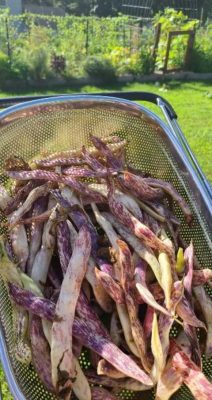
Full of fiber, packed with protein, and great to grow, beans have been a staple in the diet of humans for thousands of years. Native edible beans can be found on every continent but Antarctica, although many of the beans we eat today are domesticated varieties that originated in South America, Europe, and Asia. Fabaceae, the bean family, is one of the largest families of plants in the world, with over 20,000 species described. As legumes, beans can convert nitrogen in the atmosphere into nitrogen useable by other plants, making them very useful to integrate into crop rotation for savvy home gardeners who want to save a little money on nitrogen fertilizer. In fact, excessive nitrogen fertilization of legumes can inhibit the natural nitrogen-fixation process, so use only a low-strength nitrogen fertilizer if absolutely necessary. Legumes can even be used as cover crops in the winter to prevent soil erosion and provide a boost to your soil health all winter long. You can direct-seed beans and still get production all season, meaning Connecticut gardeners can get beans in the ground now.
Fava beans (Vicia faba) are grown all around the world, very adaptable to many climates, and are generally very easy to grow. They are cold-tolerant and can be grown all the way down to USDA Hardiness Zone 3. In Connecticut, for the best results, you should plant fava bean seeds in the early spring in a place that gets full sun and doesn’t stay too moist. They will take about three months to begin producing beans but will continue producing throughout the season and into the fall. Some frost-resistant varieties will even survive temperatures below freezing, and since they self-pollinate, bees are not necessary for the production of pods. Fava beans do not require trellises, but some larger varieties may benefit from cages or trellises for additional support. In the summer, pollinators love the flowers, and understandably so – bean flowers not only signal the coming produce but are also eye-catching. Many varieties have white and dark red flowers. Some varieties have pink flowers. Bean pods can be harvested and eaten whole if they are young and tender. It is important to note that some people may have an adverse reaction to consuming fava beans, a metabolic disorder called favism. Favism causes anemia in response to the inhalation of the plant’s pollen or consumption of the beans. Be sure to check with your doctor before trying these beans for the first time.
For “summery” beans that are native to central and south America, you can try planting kidney, cranberry, appaloosa, or navy beans, all in the genus Phaseolus. Perhaps the delight of beans in the Phaseolus genera is their diversity in appearance. Appaloosa beans are especially whimsical, with white, brown, and reddish mottling. They strongly resemble the horse for which they are named. Some of these species behave like pole beans, meaning they will need to be trellised, while others behave like bushes, meaning they should not need to be trellised. The seed packet should indicate whether they will need to be trellised. As with fava beans, be sure to water Phaseolus when the soil seems dry, taking care to avoid watering the leaves. Excessive leaf wetness may increase the likelihood for fungi to grow and cause disease.
No matter what bean you try growing, pests and disease are ever-present. Aphids, bean beetles, and European corn borer are all possible bean pests. Beans are susceptible to diseases like powdery mildew, Fusarium wilt, and bean rust. Selecting disease and pest-resistant varieties will reduce the risk of yield loss. Like most legumes, the ideal soil pH for growing beans is 6-7. Since native Connecticut soil typically has a pH closer to 5.5, be sure to send a soil sample to the UConn Soil and Nutrient Analysis Lab to test the pH (and nutrients!) of your soil before planting to ensure you get accurate recommendations for any amendments your garden may need to allow beans to thrive!
The UConn Home & Garden Education Center supports UConn Extension’s mission by providing answers you can trust with research-based information and resources. For gardening questions, contact us toll-free at (877) 486-6271, visit our website at homegarden.cahnr.uconn.edu, or reach out to your local UConn Extension center at cahnr.uconn.edu/extension/locations.
This article was published in the Hartford Courant Apr. 19 2025
Rocky Start for Rhododendron’s This Spring
By Heather Zidack, UConn Home & Garden Education Center
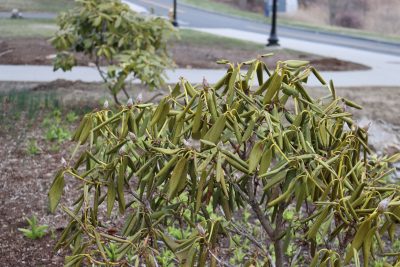
Rhododendrons are looking rough this spring. You’ve probably seen it in your yard or in your neighborhood. The UConn Home & Garden Education Center has been seeing an increase in the number of calls regarding injury or damage to rhododendrons. In most cases, we are finding these reports to be winter injury. This is an environmental type of damage, caused by a perfect storm of conditions that we have seen throughout the state. So, let’s take a closer look into why this is happening.
Plants lose water through their leaves. During active growth, that water is constantly replenished from the roots. When the temperatures drop and the ground freezes in the winter, available water becomes limited. Plants have adapted to this in many ways. Dormancy is triggered by multiple factors, but water conservation is certainly one of those. Deciduous trees shed their leaves completely. Evergreens have developed various leaf adaptations to help with survival, too.
As broadleaf evergreens, rhododendrons have developed a waxy coat on their leaves to help prevent water loss. They also have a physiological mechanism to help defend themselves further. Just as you’d clasp your hands together on a cold winter day to shield them from the elements, rhododendron leaves curl themselves into cigar-shaped cylinders. The leading theory is that this happens to protect the leaves from further water loss. This natural defense mechanism has grabbed our attention this spring, since our weather patterns have lent a hand in amplifying a natural phenomenon.
At the end of last summer, CT started to see a moderate drought in much of the state. These conditions have persisted through this spring. Water availability was limited as plants went into the winter and remained limited throughout the season. Add in frozen soil and harsh winter winds and the environmental stress increased even more. When water is unavailable to the roots – through either freezing or drought conditions, plants lose their ability to return water to the living tissues. This drying out, referred to as desiccation, leads to winter injury or winter kill depending on the severity of damage. While we are finally seeing rain, these plants need time to recover and may not be ready to unfurl just yet.
Many have noted that some plants are faring better than others even within the same bed. This is also normal to some extent. It can be easy to forget that plants are living things in our landscapes. There is going to be variance in their ability to withstand environmental pressures and their recovery rates.
If you are seeing this in your rhododendrons, be patient this spring and monitor over the next month or so. With an increase of rain in the forecast, the extra hydration should help plants recover - or at least push out new growth. These shrubs will shed any leaves that are damaged beyond repair on their own. Do not prune or fertilize shrubs until the end of May to avoid further injury. If we go a week without rain, consider watering your shrubs to help speed up recovery – but only water if the soil feels dry to the touch! If by mid-late May you are seeing absolutely no improvement, we start to consider other factors that may contribute to the plant’s health. For now, they just need a little more time.
The UConn Home & Garden Education Center supports UConn Extension’s mission by providing answers you can trust with research-based information and resources. For gardening questions, contact us toll-free at (877) 486-6271, visit our website at homegarden.cahnr.uconn.edu, or reach out to your local UConn Extension center at cahnr.uconn.edu/extension/locations.
This article was published in the Hartford Courant Apr. 12 2025
What’s That Smell? CT Dairy Farmers Hard at Work
By Abigayle Ward – Soil Science Graduate Student, UConn Department of Plant Science & Landscape Architecture

As temperatures warm up, perhaps you feel inclined to open windows to let some fresh air into your home or to feel the breeze on your morning commute. But then it hits you: The pungent aroma of freshly-spread manure. The few weeks that the smell persists serve as a reminder of the agricultural roots of Connecticut. Dairy farming began during the American colonial period in the 1600s, and milk remains one of the most important agricultural products in Connecticut. Some dairy farms have been in continuous operation for over 10 generations.
A single cow can produce around 100 pounds – about 18 gallons – of manure per day. Connecticut is home to nearly 19,000 dairy cows, so you do the math – that’s a lot of manure!
Typically, farmers spread manure on their crop fields twice per year: Once in the early spring, and again after corn harvest, usually in late fall. Manure is rich in nutrients, which helps grow the crops farmers use to keep happy cows throughout the year. Manure is also an excellent source of organic matter, which enriches the soil with carbon, provides nutrients to support healthy soil microbiomes, and gives our sandy Connecticut soils structure, which is essential for happy crops and high yields.
Many Connecticut dairy farmers are also on the forefront of research and development. In Coventry, Hytone Farm uses a brand-new anaerobic digester to harness the power of microorganisms to break down thousands of gallons of manure and food waste every day. Biogasses, such as methane, are collected and can be used to generate electricity. The solids, called “digestates”, can be used as fertilizer, animal bedding, or even as building materials. Freund’s Farm in East Canaan has been turning digestates into compostable, nutrient-rich CowPots, which can be buried directly in your garden and will biodegrade over time. Running since 1997, Freund’s is home to one of the first anaerobic digesters in New England. Collins Powder Hill Farm – home of the Collins Creamery – makes and sells compost from leaves and manure. All these practices help these local farms, and many others, increase carbon sequestration, reduce greenhouse gas emissions, and yes, reduce the smell of manure.
For home gardeners who wish to harness the power of manure, applying a commercially produced manure compost is the safest route. While applying raw manure is safe for crops that will not be consumed by humans, composted manure is recommended for application in gardens where human food is being grown. The composting process heats up the manure to temperatures that kill pathogens, such as E. coli, which could make you sick. Furthermore, composted manure should be odorless – getting your garden many of the benefits without the smell!
While the smell may be a mild inconvenience now, it is a sign that our dairy farmers are hard at work, continuing a tradition older than our country and serving our communities. You can support our state’s dairy farmers by purchasing locally-produced dairy products, adding some composted manure to your garden, and – of course – waving to the tractor drivers!
The UConn Home & Garden Education Center supports UConn Extension’s mission by providing answers you can trust with research-based information and resources. For gardening questions, contact us toll-free at (877) 486-6271, visit our website at homegarden.cahnr.uconn.edu, or reach out to your local UConn Extension center at cahnr.uconn.edu/extension/locations.
This article was published in the Hartford Courant Apr. 5 2025
Potted Plant Paradise
By Dr. Matthew Lisy, UConn Adjunct Faculty
UConn Home & Garden Education Center
Finally, spring is here! It will soon be time to repot all our houseplants as soon as the cold weather completely stops. Many of the plants purchased over the winter, as well as the ones sitting around for years should be repotted. This does not imply that the pot size needs to be increased. Many times, the plant can be left in the same size pot. If it is rootbound, and the plant is known to get large, it’s good to go one pot size up. Increasing the pot size when it is not needed just leads to root rot as the soil will not dry out properly. Alternatively, if the plant is getting big, another option is to divide it into numerous smaller plants, each requiring a smaller pot.
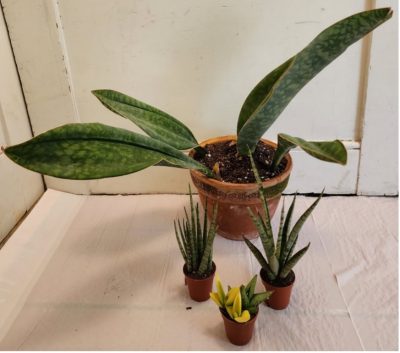
Many people think that if the pot size does not need to increase, then there is no need to repot. This could not be further from the truth. The plant is in a fixed medium. The soilless mix will quickly run out of nutrients, even with regular fertilization. Also, salts tend to build up in the soil, which harms the plant over the long run. This is a natural consequence of plants in pots. Soil can also get compacted too much over time and interfere with proper aeration of the root zone. Tease away the loose soil from the root ball being careful not to break the roots. Add the new soil and watch the plant grow!
This is also a great time to change out the pot. Most of our houseplants come in plastic pots. These are usually not very attractive. Plastic pots are good for plants that like to be kept moist. I prefer a clay pot in most cases. This allows the soil to breathe and makes it harder to over water. What I do not care for or recommend are the automatic watering pots. I have found that these have a tendency to keep the soil too moist, and do not allow for a drying out period between waterings. Stores use them as they require no maintenance from their staff, and the plants cannot wither and die due to lack of water. Long term, these types of pots lead to root rot.
Different plants have different soil needs. Cacti and succulents like it dry and fast draining. Orchids like it airy and chunky. Most houseplants prefer a mix that holds moisture but drains. Try and match the plant to the right soil type. There are great commercial mixes available for purchase, and prices on these have come down some lately. Take some time to research the proper soil type for each plant. Many of the plants take a typical houseplant mix, but some require additional drainage. In this case, add perlite and/or sand. To enable to soil to hold moisture for a longer period of time, add some vermiculite.
In all honesty, almost any soil can work for almost any plant provided that the watering is controlled. Most of the time, houseplants get overwatered which leads to fungal problems. People want to water at some magical interval, like every Friday, for example. In reality, the weather greatly influences how quickly or slowly our plants dry out. Sometimes they need water sooner, and sometimes they do not need water at all. Let the plants determine the watering schedule. If all these suggestions are followed, our plants will be living in a potted paradise, as will we!
The UConn Home & Garden Education Center supports UConn Extension’s mission by providing answers you can trust with research-based information and resources. For gardening questions, contact us toll-free at (877) 486-6271, visit our website at homegarden.cahnr.uconn.edu, or reach out to your local UConn Extension center at cahnr.uconn.edu/extension/locations.
Ready! Get Set! Spring Into Action!
By Dawn Pettinelli, UConn Home & Garden Education Center
Climbing temperatures and longer days signal springtime! Time to pull out the rakes and wheelbarrow from the shed and get out in the yard. Take a stroll through the lawn areas and gardens and note what tidying up needs to be done. Pick up fallen twigs and rake up areas where leaves accumulated over the winter.
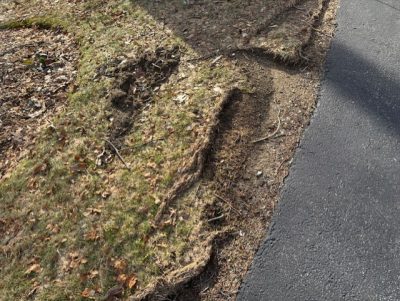
While we did not have a severe winter, there was some necessary snow and ice removal around driveways and walks. Often the lawn next to these areas has gotten ripped up or compacted and is in need of repair. Rake up the damaged sections and add topsoil if needed to level out the area. Then scratch up the surface and put down some grass seed. Usually at this time of year, little irrigation is necessary but be prepared to lightly water if dry, sunny conditions prevail. Another option is to line your driveway with tough groundcovers or pollinator friendly flowers although this can be challenging if drivers routinely miscalculate their parking abilities.
Speaking of lawns, check to see that your lawnmower and weedwhacker are in working order. Wait until closer to the beginning of April when lawns actually start to green up before applying limestone or fertilizer. They can be purchased now, however, so you’re ready to go when grass starts growing and the ground is dry enough to walk on. Crabgrass controls can be put down about the time the forsythia is in full bloom.
Next take a good look at your woody plants – your trees and shrubs. Some of us experienced pretty icy conditions over the winter that caused a fair amount of breakage. Remove any cracked or damage branches. Cut back to a bud, stem or the ground depending on where the damage occurred. Now before the plants leaf out is a great time to prune. After removing dead and damaged stems, cut out any crossing or rubbing ones, those that are too crowded, and then prune for desired height and shape. Keep in mind the plant’s mature size as you prune. Better to select a plant that fits its space than to continue hacking it to the size you desire. This is also a perfect time to prune fruit trees such as apples and pears, and also blueberry bushes.
By now your vegetable garden should be all planned out and seeds purchased, or at least ordered, as well as onion sets or plants, seed potatoes and sweet potato slips. Tomato and pepper seeds can be started in soilless media indoors. I prefer to plant 2 seeds of tomatoes in each cell of a 4 pack and 2 seeds of peppers in each cell of a 6 pack, because the peppers take longer to germinate and grow slower than tomatoes. Seeds are set about a quarter inch deep in the moistened media and kept about 70 degrees F under fluorescent lights. After the seeds germinate and the seedlings grow their first set of true leaves, the weaker of the two plants, if both seeds germinate, is removed.
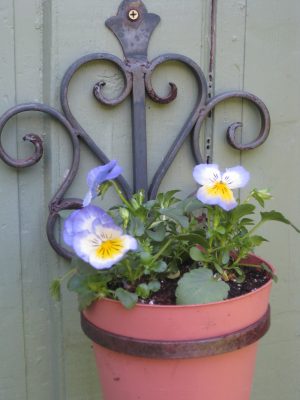
Cool season vegetable seeds should be collected or purchased for early plantings. These include peas, radishes, lettuce, spring turnips, spinach, chard and many Asian greens. A few warm days might have us chomping at the bit but wait until the soil temperature reaches 45 degrees F. How would you determine soil temperature? Using a soil thermometer, insert it into the soil where you want to plant your seeds about 1 to 2 inches deep and take a reading in the morning and then again around 2 pm. Shade the thermometer if in direct sun. Average the two readings and plant when there are a few days of at least 45 degrees F and the weather forecast is favorable.
Many of us are not cleaning up perennial gardens in the fall so that beneficial insects can overwinter in debris. You can start going in now and cutting down stems and tidying up. Fall bloomers like asters and mums can be divided. Limestone can be added if necessary but wait to fertilize when new growth appears.
The warmer weather puts a smile on our faces and we can share the joy of spring by planting pansies with their abundant blossoms and cheery faces. One can never have enough pansies, or at least, I feel that way. Get out and welcome spring, spruce up your lawn and gardens and be thankful that winter is over!
For questions on these or other garden chores or on other gardening topics, feel free to contact us, toll-free, at the UConn Home & Garden Education Center at (877) 486-6271, visit our website at www.homegarden.cahnr.uconn.edu or contact your local Cooperative Extension Center.
This article was published in the Hartford Courant Mar. 22 2025
Have You Tested Your Well Lately?
By Alec Janis M.S. – Connecticut Institute of Water Resources

In 1718, in what is now Franklin, Connecticut, a well was dug as an all-purpose public source of water for the community. In about 1755, the people began to complain about the water’s quality, saying it stained clothes and remained tainted until 1794, when an earthquake shook the town. After the earthquake, it was found that the well had been restored to its original quality. Although this is a more extreme example, the quality of your well water can change at any time, which means that just because it was safe to drink when it was installed, that may not be the case today.
The Connecticut Department of Public Health recommends that all residents test their wells every two to five years. If you’re struggling to remember the last time you tested your well, you’re not alone. We estimate that 96% of Connecticut well owners do not follow these guidelines.
So how does your well work? When it rains, some water is absorbed by the plants in the landscape, but they can’t uptake all that water. After water travels past the plant roots, it continues until it reaches an area where all the spaces in the soil have been saturated. This is known as the water table. Think of the soil like a sponge; as you add water, the water fills all the holes and space inside until it’s completely soaked through. If you have a shallow well, your water is being pulled directly from this water table.
If you have a drilled well, your water comes from much further underground. Below the saturated layer of soil, there’s solid stone called bedrock. Throughout the bedrock, there are small cracks, called fractures, where water moves. You can see an example of this when passing a rocky cliff face along the highway that seems to be randomly covered in ice. The ice you see has formed from water that has made its way through soil on top of the ledge, into the fractures in the stone and eventually drips out of small cracks where it freezes in the cold air. A drilled well is a bored hole in the bedrock, intersecting many fractures. Instead of following the original path, water now pours out of the fractures and pools in the newly formed hole.
Now that we know how water travels, let’s consider everything the water is interacting with on its way down. Consider the animal waste on your lawn from a pet or a passing deer, the fertilizers or pesticides you may use on your lawn, or even the de-icing salts you put on walkways during the winter. Precipitation, in the form of rain or snow, pulls everything underground. However, not all of this will end up directly in your well water. The dirt acts as a filter stopping some contaminants while letting others through. Depending on the chemical make-up, certain compounds will remain in the soil while others will break down and continue to travel through.
When this water reaches the bedrock, it will continue to pick up and lose different chemicals. This process will slowly erode these cracks, causing the paths to change over time. As the stone erodes, metals and minerals will be picked up with the traveling water and occasionally end up in your drilled well.
This is why it is important to routinely test your well water quality every few years. As water erodes fractures in the bedrock, new cracks and pathways form, changing the contaminants that are entering your well. We currently don’t have a simple method to track how groundwater is moving, so testing is the best way to understand what’s happening in your well.
To get your well tested visit a local or lab participate in the UConn Extension well testing program. We are hosting a collection event at the UConn Extension - Middlesex County Extension Center (1066 Saybrook Rd, Haddam, CT 06438) on May 3rd from 10:00am – 1:00pm. These tests test for coliform bacteria, lead, arsenic, uranium, nitrates, sodium, chloride, fluoride, pH, hardness, sulfate, turbidity, iron, and manganese. These tests, normally valued at $350, are being offered for a reduced cost of $200.
We will mail a sample kit to participants who have signed up in advance of the collection event. Sample kits will also be available at the collection event on May 3rd as well as at the Old Saybrook Environmental Fair (Old Saybrook Middle School, 60 Sheffield St, Old Saybrook, CT 06475) on April 26th.
Participants can sign up online at https://s.uconn.edu/haddam-well-testing. The deadline to be mailed a sample kit is April 25th.
If participants cannot make the day above, we offer a walk in service year-round where participants can bring their water sample to the UConn main campus Monday through Thursday from 8 am – 5 pm. For more information on how to sign up, visit https://ctiwr.uconn.edu/walk-in/.
We support UConn Extension’s mission by providing answers you can trust with research-based information and resources. For home gardening questions, contact the UConn Home & Garden Education Center at homegarden.cahnr.uconn.edu, or reach out to your local UConn Extension center at cahnr.uconn.edu/extension/locations. For more information about the CT Institute of Water Resources and Well testing services, visit https://ctiwr.uconn.edu/
This article was published in the Hartford Courant Mar. 15 2025 and printed in The Chronicle in the same week
Narcissi and the Reflections of Spring
By Abigayle Ward – Soil Science Graduate Student, UConn Department of Plant Science & Landscape Architecture

According to an ancient Greek myth, all those who had fallen in love with the young man Narcissus were met with contemptuous rejection. On a hunting trip, Narcissus stopped to drink from a pond and became enamored with his own reflection. Cursed to never experience a requited love of his own, he stared at himself until his death, and his place was taken by a flower.
While it remains disputed whether the character was named after the flower or vice versa, the enduring significance of the narcissus as a harbinger of spring is uncontested. With a native range spanning throughout most of Europe, northern Africa, and parts of Asia, legends describing this culturally significant early-season perennial have been told since antiquity. In China, daffodils are carefully grown to bloom for the Lunar New Year, which began this year on January 29th. Their Mandarin name, shuixianhua, literally translates as “immortal water flower”, attesting to their resilience throughout the early season cold.
The Royal Horticultural Society in the United Kingdom describes 13 different types of narcissi based primarily on morphological appearance and when they bloom. Some have long trumpets, while others have multiple flowers to one stem. Others have small trumpets and many petals, called ‘double daffodils’, while others still have few petals dwarfed by large, bowl-shaped trumpets. Daffodils also come in many interesting color combinations – while most of us are familiar with the classic yellow petals and orange trumpets, they also come with white petals, white trumpets, and some even have shades of salmon pink. As one of the earliest-blooming flowers in your garden, they add a lovely splash of color to an otherwise brown landscape. In beds, they go well with red or pink tulips. By themselves, daffodils make good borders, particularly if different color combinations are intermixed to create visual intrigue.
While it is too late now to plant daffodil bulbs with the guarantee of blooms, they can still be safely planted. If you have some bulbs and want to give them a try, be sure to plant them in a sunny spot with well-drained soil at least 6 to 8 inches below the surface. They may sprout, but not form a flower. Do not fear: Daffodils are quite resilient and will likely flower the next spring. If you want to wait, the ideal time to plant daffodils for blooms in the spring is November.
If you find an already-blooming daffodil at your local garden center, it can be planted in the ground any time after the blooms themselves have faded. Both the bulbs and the foliage are frost-hardy well into sub-zero temperatures, making them well-suited for growing in the unpredictable winter weather of Connecticut.
After the flowers have bloomed, you may wish to cut the flower stems and bring them indoors for some bright colors. If you leave the flowers on the plants, be sure to deadhead them as soon as the flowers begin to wilt. If daffodils are allowed to go to seed, the plant will divert precious nutrients and energy away from the bulb. Once the plant has finished flowering, only the foliage remains. While it is tempting to remove the foliage, the leaves are collecting energy and creating food for the bulb via photosynthesis. If the leaves are removed too early, the daffodil may not flower the following spring. Some gardeners like to tie up the leaves in rubber bands or braid them to keep them out of the way, although it is generally best practice to leave them alone until they turn brown by themselves. Damage to the leaves could introduce pathogens or attract pests, which could impact the ability of the plant to flower next year.
With proper care, daffodil bulbs can multiply, ensuring many blooms come back year after year. As we move forward into the season of renewal for ourselves and our gardens, consider planting some daffodils to add a bit of sunshine to your home landscape.
The UConn Home & Garden Education Center supports UConn Extension’s mission by providing answers you can trust with research-based information and resources. For questions about spring bulbs like daffodils or other gardening questions, contact us toll-free at (877) 486-6271, visit our website at homegarden.cahnr.uconn.edu, or reach out to your local UConn Extension center at cahnr.uconn.edu/extension/locations.
This article was published in the Hartford Courant Mar. 8 2025
Yes, You Can Grow Orchids!
By Dawn Pettinelli, UConn Home and Garden Education Center
Some favorite booths at the CT Flower and Garden Show this past weekend were the ones filled with orchids. Orchids are becoming more popular as houseplants and many folks are finding that they can be grown successfully in the home without elaborate care or special equipment. If you’re in a traveling mind, check out the Orchid Exhibit at the New England Botanic Garden in Boylston, MA that runs through March 23, 2025.
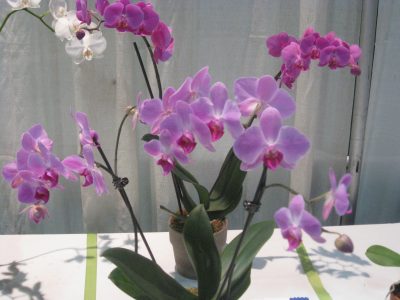
Orchids are grouped into two general divisions. Epiphytic orchids naturally grow on trees in the tropics. Trees are used for support. Water and nutrients come from rain, bird droppings and organic debris collecting around the roots. Terrestrial types will grow in a highly organic soil. While epiphytic orchids may tolerate or even enjoy a dry, dormant period, terrestrial species, in general, need to be kept moist throughout the year.
Two styles of growth are exhibited by orchids. Monopodial orchids grow in an upright direction from the central stem on which aerial roots and flowers develop. Sympodial orchids generate new growth from the base of the plant. As the new stems mature and bloom, younger shoots once again are produced and the cycle is continued.
The orchid family is organized into several genera (each called a genus) which may contain from one to many species. Much hybridization has occurred and the names can be baffling to a novice. For instance, hybrids resulting as a cross between Cattleya mossiae and C. warscewiczii are labeled Cattleya x Enid, the ‘x’ indicating the plant is a hybrid.
Some of the easiest orchids for beginners are phalenopsis, paphiopedilum, epidendron, oncidium and cattleya. Not every member of each genera can be successfully grown in the home so be sure to check with your source. Almost all colors are available and blossom size may range from very tiny to several inches in diameter.
The basic requirements for orchids are good ventilation, 40 to 50 percent humidity, light, proper watering and a well-draining potting mix usually composed of fir bark. Often osmunda fiber, tree fern and/or perlite are added to the fir bark.
Specific cultural requirements vary as to the species. Some tolerate higher light levels than others. Many varieties of the orchids listed above prefer 55 to 60 degree F nights and 65 to 68 degree F days although cattlyas, epidendrons and oncidiums like it about 10 degrees warmer. If growing on a windowsill, put the varieties that like it cooler closer to the window. Make sure leaves do not touch the glass.
Ways to increase humidity include grouping plants together, placing on gravel lined trays filled with water, frequent misting or use of a humidifier. Plants should not sit in water and the foliage, if misted, should be dry by evening. Don’t keep plants too close together as good air circulation helps prevent diseases.
Watering is perhaps the trickiest part of growing orchids. There is not accurate rule for when to water because it depends on the size of the container, the type of growing medium, temperature and light conditions. Obviously, plants will have to be watered more often in hot, dry weather and less during cool, damp periods. When watering, soak the potting material thoroughly. Do not water again until the medium feels dry to the touch. If in doubt, do not water.
Since fir bark contains virtually no nutrients, plants have to be fertilized on a regular basis. Some recommend fertilizing at every third watering with a half strength orchid fertilizer. It is best to place plants in the sink and water until it drains from the pot, not putting the plant back in its saucer until it is thoroughly drained. Special orchid pots are available with enlarged drainage holes. Fertilizers should just be applied when plants are actively growing.
Orchids are a plant you have to experiment with but once you’ve experienced success, you will find that as a hobby, they can be quite contagious. Those seeking more orchid information might want to check out the Connecticut Orchid Society (www.ctorchids.org) or the American Orchid Society (www.aos.org).
If you have questions on growing orchids or any home or garden topic, contact the UConn Home and Garden Education Center, toll-free, at 877.486.6271 or visit us at www.homegarden.cahnr.uconn.edu or call your local Cooperative Extension Center.
This article was published in the Hartford Courant Mar. 1, 2025
The Challenges of Boxwood: Pests, Diseases, and Alternatives
By Marie Woodward, UConn Home & Garden Education Center
Boxwood, a classic choice for formal gardens and hedges, has faced increasing threats in recent years. As gardeners grapple with these challenges, it is crucial to understand the issues at hand and explore alternative plants for our landscapes.
Boxwood Blight is an aggressive fungal disease that affects various Boxwood species and causes rapid defoliation and potential plant death. First identified in the United Kingdom in the mid-1990s, this disease has since spread across North America. Early symptoms include stem cankers, sunken lesions, and eventual dieback. To mitigate the risk of Boxwood Blight, choose resistant cultivars, practice good garden hygiene, and monitor your plants for early signs of infection.
The Box Tree Moth is an invasive pest native to Asia that feeds on Boxwood plants. Since its arrival in North America, this moth has wreaked havoc on Boxwood populations, leading to defoliation and plant stress. Symptoms of infestation include see-through plants, "stick shrubs," and stem cankers. Regular monitoring and integrated pest management strategies are essential for controlling this destructive insect.
As Boxwood plants continue to face challenges from pests and diseases, it is wise to consider alternative options for our gardens. Ilex crenata (Japanese Holly) is a versatile, broadleaf evergreen that can be shaped into hedges or topiaries. Its small, glossy leaves provide a neat appearance, and its adaptability to various soil types and sun exposure makes it a low-maintenance choice.
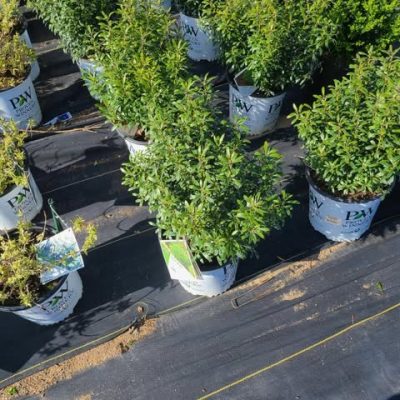
Euonymus japonicus (Japanese Euonymus), an evergreen shrub with small, glossy leaves and tolerance for a range of growing conditions is another possible substitution. Its compact growth habit and easy maintenance make it an excellent choice for hedges or screens.
Ilex glabra (Inkberry), is a slow-growing evergreen native to North America, featuring dark green leaves and red berries in the fall. Its low, spreading habit makes it ideal for low hedges or mass plantings.
Privets (Ligustrum), are fast-growing, low-maintenance evergreen shrubs with small, glossy leaves. They can be used for hedges, screens, or as stand-alone specimens. However, keep in mind that three cultivars, border privet, (Ligustrum obtusifolium Sieb. & Zucc), California privet, (Ligustrum ovalifolium Hassk.) and European privet (Ligustrum vulgare L.) are listed on UConn’s invasive plant database. If you decide to plant privets, look for seedless cultivars such as Golden Ticket privet (Ligustrum x vicaryi "KCLX1") at your local nursery.
The Boxwood Blight and Box Tree Moth present ongoing challenges for gardeners and landscapers. By understanding these threats and adopting appropriate management strategies, we can mitigate the damage they cause. Additionally, exploring alternative plants can help create more resilient and sustainable gardens in the face of these challenges. With careful planning and thoughtful plant selection, our landscapes can continue to thrive in the face of adversity.
The UConn Home & Garden Education Center supports UConn Extension’s mission by providing answers you can trust with research-based information and resources. For questions about your boxwoods or other gardening questions, contact us toll-free at (877) 486-6271, visit our website at homegarden.cahnr.uconn.edu, or reach out to your local UConn Extension center at cahnr.uconn.edu/extension/locations.
This article was published in the Hartford Courant Feb. 22, 2025
It was been updated from its original publishing on Feb. 27, 2025
Shine a Light – But Which One?
By Emily Leahy, UConn Home & Garden Education Center
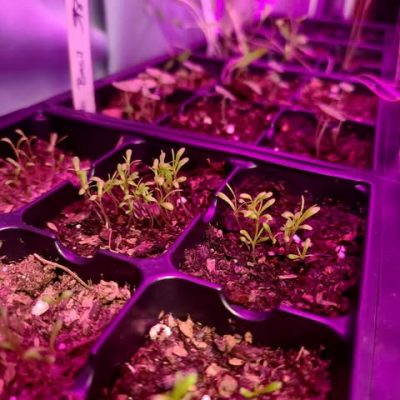
The dead of winter brings a longing to spend time outside in the garden again. While this may not be possible yet, it is easy to craft your own growing space indoors. The elements of the outdoors that allow plants to thrive – light, warmth, and water – can all be brought indoors with a little creativity and the right resources.
Some steps remain unchanged. Still, refer to the plant’s label for guidance on choosing a proper container, water and nutrient needs, as well as temperature preferences. Guidelines on how much light the plant should receive can also be found on the label – but how can this be applied indoors?
One of the more challenging aspects to simulate, indoors, is an adequate amount of light. When outside, plants rely on the sun for light needed to carry out photosynthesis. This chemical reaction produces sugars which are used as energy in processes essential for the growth and maintenance of a healthy plant. While plants can still receive sunlight indoors through rays shining through windows, this often cannot act as an equitable substitute for unobstructed sunlight outdoors. This is where supplemental light sources in the form of grow lights come into play. Grow lights are specially designed with the purpose of emitting a wider spectrum of light wavelengths to enable photosynthesis. But with so many options available, how can you choose which is the best option?
Generally, there are two types of grow lights – bulbs and fixtures. Bulbs can be placed into existing light fixtures like lamps or overhead lighting. However, this can be unsuitable as it is difficult to control the distance from the plant and angle at which the light shines. Grow light fixtures are separate systems which can provide multiple plants with light simultaneously, offering a more even distribution. With proper setup, they can be positioned at an advantageous angle to provide plants with their preferred amount of light.
Next comes the question of which kind of light is appropriate for your plant – incandescent, fluorescent, or LED? It is important to determine beforehand the level of light which your plant prefers – high, medium, or low. Incandescent lights, while costing the least, are also the least efficient. 90% of their energy is released in the form of heat, while only 10% is light itself. While this makes them good contenders for low-light plants, they also require caution as they can provide plants with an overwhelming amount of heat.
Fluorescent lights are well-suited for plants requiring low to medium light. They emit the full spectrum of light, essential for promoting growth as they mimic natural sunlight. Most often they are seen as strips or tubes of light that can be affixed above plants, but they can also be purchased in bulb form. LED lights emit the full spectrum of light as well, while simultaneously emitting less heat than other bulb types. Yielding a high overall efficiency, LEDs can be customized with different colors/wavelengths of light to provide certain advantages for some plants. For example, blue lights promote vegetative growth, while red lights do the same for flowering and fruit growth.

After choosing the most suitable kind of grow light for your plant, there are a variety of other tips helpful to consider. The type of plant not only determines the proper type of light to use, but also how much light should be provided. Supplying light 24 hours a day is not ideal as it can overwhelm the plant – remember the objective is to mimic the light conditions of the outdoors. Therefore, plants will require some hours of darkness each day.
Seedlings generally prefer 14-16 hours of light per day, as they necessitate the most encouragement for growth. 12 hours of light is suitable for herbs and other greens, while houseplants fall between the range of 6-12 hours per day – be sure to refer to the product label for any specifications on light preferences.
In terms of setup, lights should be angled to ensure a direct stream of emittance onto the plant in order to receive its full benefits. It is best to affix lights about 12 inches from the plant, although adjustments can be made as you see fit. Some indoor gardening systems are available that can be customized to fit specifications according to the type of plant being grown. It is also important to purchase lights that are rated to withstand humidity and moisture if they are being kept in a greenhouse-like environment.
Be sure to always refer to your plant’s label for its specific preferences for light and other growing conditions. With the help of grow lights, you can wait out the winter by bringing a little bit of the outdoors, indoors!
The UConn Home & Garden Education Center contributes to the Cooperative Extension mission of the University of Connecticut by connecting the public with research and resources provided by the University. For your gardening questions, feel free to contact us, toll-free, at the UConn Home & Garden Education Center - (877) 486-6271, visit our website at https://homegarden.cahnr.uconn.edu/, or contact your local Cooperative Extension center https://cahnr.uconn.edu/extension/locations/.
This article was published in the Hartford Courant Feb. 15, 2025
Soil and Plant Tests for Managing Nitrogen Fertilization
By Haiying Tao, Ph.D., UConn Home & Garden Education Center
Nitrogen (N) is often the most limiting nutrient in growing plants. When deficient, plant yields and quality are reduced. However, excessive nitrogen applications could cause concerns in water quality and greenhouse gas emissions. Managing nitrogen is a very difficult task for farmers and gardeners because nitrogen exists in many different forms in the soil and can be lost from soil via many pathways. In addition, different forms nitrogen can be transformed from one form to another. The weather, especially rainfall and temperature, can impact these processes. Heavy rainfall can lead to significant nitrogen leaching and runoff.
Fortunately, there are strategies that can be used to help us manage nitrogen for optimum plant yield and quality, while minimizing nitrogen loss. Most home gardeners benefit from the standard nutrient analysis when testing their soil. Recommendations and questions regarding additional sampling, interpretation, and fertilization recommendations for specific tests and crops mentioned below should be referred to the University of Connecticut Soil Nutrient Analysis Laboratory.
Predict nitrogen requirement and preplant soil tests
Testing soil for nitrate and ammonium forms of nitrogen as well as soil organic matter (SOM) can help you predict soil nitrogen supply during the growing season. SOM can provide substantial amounts of nitrogen via mineralization, which is a process where soil microorganisms convert organic forms of nitrogen to the plant available forms of ammonium and nitrates.
Typically, for every 1% of SOM in the top 6 inches of soil, approximately 20 to 40 lbs of nitrogen per acre can become available via the mineralization process. If you can predict the nitrogen requirement of the desired crop, the amount of nitrogen that needs to be applied can then be estimated using the differences between demand and supply. Note that for SOM testing, 6-inch soil sampling depth is typically recommended.
Pre-sidedress Soil Nitrogen Test (PSNT)
The Pre-sidedress soil nitrate-nitrogen test (PSNT) can be used for corn and vegetable crops such as tomatoes, peppers, fall planted cabbage, etc. Soil sampling and testing for PSNT takes place in June or early July, typically when corn plants are 6 inches to 1 foot tall. At this time of the year, the heavy rainfall season has passed, soil is at its optimum moisture and temperature condition for mineralization, and crops, like corn, begin to increase nitrogen uptake exponentially.
Soil samples should be collected at 1 foot depth. The samples should be packed with icepacks during shipping to the soil testing labs. Typically, if PSNT is higher than 25 ppm, nitrogen fertilization is unlikely needed. Crops that have shallower root systems may require a slightly higher PSNT level because they do not have extensive root systems to take up nutrients from a large volume of soil.
End-of-Season Cornstalk Nitrate Test (CSNT) for Corn

The end-of-season corn stalk nitrate-N test (CSNT) is a post-harvest plant tissue test for corn that can evaluate nitrogen uptake and availability during the crop’s growing season. This test is appropriate for corn produced under both rain-fed and irrigated conditions. Although the test is too late to guide current crop fertilization, the post-harvest evaluation can estimate N sufficiency levels during the corn growing season and provide a valuable tool for fine-tuning future nitrogen management strategies.
Approximately one week prior to or after harvest, 15 random cornstalk samples for every 10 to 15 acres should be collected to form a composited sample. Each cornstalk sample should be collected by cutting an 8-inch section between 6 and 14 inches above the ground. Remove the leaves and sheaths, place the samples in a paper bag, and immediately send the samples to a laboratory for CSNT testing. Avoid taking samples from severely damaged plants. Typically, a CSNT higher than 2000 ppm suggests excessive nitrogen was available during the crop growing season.
We recommend that farmers regularly conduct CSNT to evaluate N sufficiency levels in their cornfields and fine-tune their N management strategies in subsequent growing seasons. Farmers should begin their fine-tuning by reducing fertilizer N applications in cornfields where CSNT results were in the excessive category or even eliminating fertilizer N applications if the CSNT is exceptionally high in the heavily manure fields. Notice that the CSNT could be high in drought years, this is another reason that it is best to test CSNT every year to accurately assess the nitrogen management practices.
If you have further questions about the different types of soil tests available to farmers and home gardeners, please contact the UConn Soil Nutrient Analysis Laboratory at 860-486-6270 or at https://soiltesting.cahnr.uconn.edu/. The UConn Home & Garden Education Center contributes to the Cooperative Extension mission of the University of Connecticut by connecting the public with research and resources provided by the University. For your gardening questions, feel free to contact us, toll-free, at the UConn Home & Garden Education Center (877) 486-6271, visit our website at https://homegarden.cahnr.uconn.edu/, or contact your local Cooperative Extension center https://cahnr.uconn.edu/extension/locations/.
This article was published in the Hartford Courant Feb. 8, 2025
Tissue Cultured Houseplants
By Dr. Matthew Lisy, UConn Adjunct Faculty
UConn Home & Garden Education Center
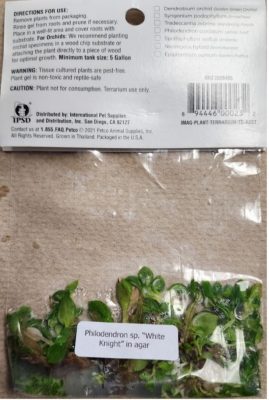
Ever wonder how new varieties of houseplants are produced so quickly? Tissue Culture is most likely responsible for this. Many people think this is new technology, but it has been donesuccessfully since the 1950s. Recently, I was surprised to see tissue cultured houseplants available in a big box pet store.
If plant breeders had to wait for a plant to clone itself the natural way, the supply of rare houseplants would be extremely limited. This would cause the consumer to have to pay an exorbitant price, and the demand would far exceed the supply. Tissue culture allows for a short cut.
Plant cells exhibit totipotency, or the ability to regrow a whole new plant from a single cell. While our cells differentiate and stay that way, plant cells can dedifferentiate and then grow into a whole new plant. This is why plant propagators can take a small piece of a plant leaf, and grow it into a whole new plant with roots, stems, leaves, and any other tissues the plant needs.
The plants I found were in a very small package almost the size of a cell phone. There was some nutrient agar in the bottom, and a bunch of little, tiny plants. Some of the plant packets had rotting plants, but I selected two nice and green healthy ones – Philodendron sp. ‘Pink Princess,’ and Philodendron sp. ‘White Knight.’ In order for tissue culture to be successful, the cutting used needs to be completely sterilized, or fungus and bacteria will ruin the culture. The agar provides all the moisture and nutrients the growing plants need. Although operations can vary, once baby plantlets are observed, they are generally moved to a larger growing medium under sterile conditions. When big enough to handle, the plants are potted up and grown on like any other plant would be. The plants I bought were extremely tiny, with leaves, stems, and very small roots. I left them in the bags they came in for a few weeks, and put them under LED grow lightsto increase their size.
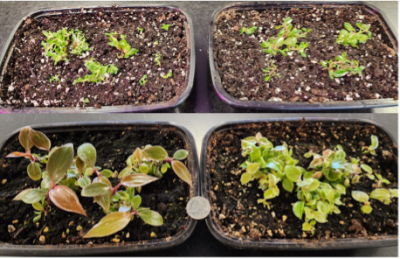
Once the plants looked big enough to handle, I placed them into soilless growing medium. It’s a good idea to keep them moist under a plant dome to avoid dehydration. I would regularly mist the enclosure to keep the humidity high. The plants have done extremely well. When I started to notice some fungus on the surface of my soil, I quickly increased the air flow which dried it upimmediately. I still have the plants in the dome, but with all the vents wide open. The plants have grown much bigger and are looking great. Once the plants get to the point where they could use their own pot, I will separate the biggest ones out and leave the little ones to grow on for a while. Once they start growing after transplanting, I fertilized every time I watered.
The disadvantage of buying tissue cultured plants when they are young is that it takes a long time for them to reach a respectable size. It is also difficult to see what they actually look like and can be difficult to separate the baby plants. There are, however, many advantages. Plants are very cheap, numerous, and free from pests and diseases. The grower also gets a special sense of accomplishment when the plants are raised from little plantlets to full grown adults!
For your gardening questions, feel free to contact us, toll-free, at the UConn Home & Garden Education Center at (877) 486-6271, visit our website at www.ladybug.uconn.edu or contact your local Cooperative Extension center.
This article was published in the Hartford Courant Feb. 1, 2025
Reducing Lawn Areas to Enhance Property
By Pamm Cooper, UConn Home & Garden Education Center
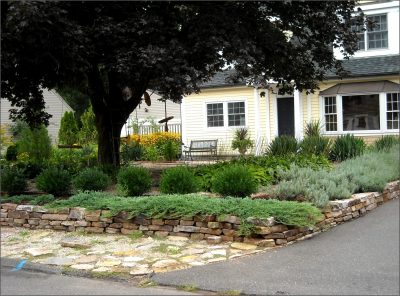
The trend in North America of having a lawn surrounding a house is not a world-wide one. As a matter of fact, it’s only since the 1940s that American lawns took a turn toward a neat, manicured, park- like atmosphere. Almost every house that is built today features a lawn and some type of decorative plantings. Shrubs are planted along the foundations of houses, and often an ornamental tree or two are strategically planted to accent the landscape. It creates the idea of a little park surrounding every home, accented with walls, decks or a patio according to individual preference.
Sometimes it is desirable to reduce lawn areas, especially when an acceptable turf grass stand cannot be maintained without a great deal of expense or work. A lawn is not like a garden that can be tilled over and started anew when things turn out poorly. A lawn is intended to be a permanent part of the landscape. Problem areas that chronically fail to produce the desired dense stand of turf grass may need to be converted into something else. The idea should be to look at the home landscape as a property, and not necessarily as a lawn.
The best way to begin determining what may look better on your property may be to take a drive around your area and see what other people have done. This is especially helpful when dealing with shade problems where grass can’t be grown so that it fills in properly. Sometimes homeowners have limbed up trees, like oaks or maples, to allow enough sun to grow a suitable stand of grass. Some people have given up and may have tried some other type of planting. As an example, Flowering Dogwoods are native trees which do best planted beneath taller trees with no grass or other plant within three feet of their trunk. Sometimes you see ground covers planted around the bases of trees, filling in up to the point where grass can form an acceptable dense stand.
There are some properties that have no lawn areas at all. Instead, perennial flowers, ornamental grasses, shrubs, and walkways are incorporated sometimes with a grass walkway. Almost any plants and trees can be selected if they are suitable for our climate zone and soil type. Keep in mind, though, that there may be quite a bit of maintenance involved in any landscape planting. Even low maintenance plants may need to be pruned or divided periodically.
Modified mowing is another way to reduce lawn area. This works especially well where there is a large area that can be left uncut for most of the year. In spring, before letting the grass grow, a wildflower mix suitable for the site can be scattered in. Or the grass can just be left alone and mowed down in the spring or fall to keep it tidy and prevent trees from getting established. Often the uncut area is contoured to enhance a driveway or other feature.
A lawn can drastically affect one’s enjoyment of one’s home landscape. Turf can be looked at as more of a “floor of a garden,” rather than as the focus of the property. If having a great looking lawn is out of reach, consider alternatives that can enhance both the visual appearance of your home and the overall enjoyment of being at home. Where a lawn constantly struggles, do not hesitate to consider planting something else. It will help lessen the load of things to worry about.
For questions about lawns, lawn alternatives or other gardening questions, feel free to contact us, toll-free, at the UConn Home & Garden Education Center at (877) 486-6271, visit our website at www.homegarden.cahnr.uconn.edu or contact your local Cooperative Extension center.
This article was published in the Hartford Courant Jan. 25, 2025
All-America Selection Winners for 2025
by Dawn Pettinelli, UConn Home & Garden Education Center
Each winter the All-America Selection winners are announced. This non-profit organization has established trial gardens throughout the United States and even as far north as Canada. New varieties, species or strains of annuals, vegetables and bedding plants are grown and judged on their performance. Those chosen as winners are outstanding plants and deserve a trial in your gardens as well.
This year’s national winners include 3 vegetables and 5 flowers. ‘Green Lightening’ is a very attractive, striped pattypan squash that tastes as good as it looks. The 5-inch or so fruits weigh in at 1 to 2 pounds and are ready to pick about 50 days after planting from seed. Judges marveled at the abundant yields on these 2 feet high, bushy plants.

Kohlrabi ‘Konstance’ exudes a vibrant purple color as well as a sweet, crunchy texture. A curious but easy to grow and tasty addition to the vegetable garden, this kohlrabi matures at just 42 days from seed. Upright plants, about a foot high, produce round, purple 4 to 5-inch ‘bulbs’ that can be eaten fresh or served roasted or sauteed. Fruits are crack-resistant and plants resistant to several diseases.
Sweet pepper ‘Pick-N-Pop Yellow’ produces adorable, snack-size, extra sweet mini peppers. The pointed, conical fruits are about 4 inches long springing from compact 2-foot-tall plants. The prolific harvest begins about 65 days after transplanting. This variety shows great resistance to bacterial leaf spot.
One can never have too many dahlias and this year’s AAS winner, ‘Black Forest Ruby’ is a gem that can be started from seed. Since this variety is an octoploid (having 8 times the normal chromosome number) there is much variability in flower shape (ranging from single to double), plant height and structure. Most will be upright about 2 feet high with jet black foliage and ruby-red flowers. You can save tubers from the best-looking plants.
Dianthus ‘Interspecific Capitan™ Magnifica’ with its impressive bicolor pink and white frilly blooms looks as good in the garden as it does in a vase. Plus, the more you cut, the more blooms appear. Summer heat tolerance was impressive with the 2-inch flower heads also standing up to rain and cold. Plants range from 1 to 1 ½ feet tall and bloom all summer. Look for these vegetatively propagated plants at your local garden center.
Sunny sites will positively shimmy when planted with marigold Mango Tango. This rich red and primrose yellow bicolor blooms all summer long even without deadheading. Reaching only 8 to 10 inches in height makes it perfect for edging garden beds, containers or window boxes. Seeds can be started indoors and plants set out after the danger of frost has passed. Fertilize and water regularly for bountiful blooms.
Can there be too many petunias? ‘Petunia Shake™ Raspberry’ will convince you that there’s always room for one more. The fantastic flowers are reminiscent of a blended raspberry milkshake swirled with lemon-lime green sorbet. The 5 to 8 inch mounded plants can do front of the border duty, serve as groundcovers or billow over hanging baskets. Plants will bloom about 70 days from seed and hold up to heat and rain.

I’ve never thought of snapdragons as fragrant, yet ‘DoubleShot™ Yellow Red Heart’ is said to have an amazing candy-like scent. Aside from this unusual trait, Yellow Red Heart promises to delight with vibrant yellow blossoms with a red throat that start early and continue through to a heavy frost. This snapdragon reaches about 20 inches in height with semi-double 1 to 1 ½ inch blooms produces all season long and able to tolerate light frosts.
Four regional 2025 Ornamental Winners well suited to the Northeast, include one petunia and 3 nasturtiums. If you’re looking for a vibrant pink petunia great for bedding and containers, try ‘Dekko™ Maxx™ Pink’. The vibrant pink 1 to 1 ½ inch starry blooms are produced all season long and hold up well to rain and heat.
Nasturtiums are top performers in garden beds and containers and are noted for their hummingbird attraction and edible leaves and flowers. New colors in the Baby series of nasturtiums to try out this year might be ‘Baby Gold’, ‘Baby Red’ and ‘Baby Yellow’. All can be grown from seed and start blooming about 50 days after sowing. Two-inch blooms cover compact 12-inch-high mounded plants. Colors are intense and plants stand up to drought, heat, cold, rain and wind. Considering our fluctuating summer weather, these are sure to do well both in the garden and in containers.
Check out these and past AAS winners. They were chosen because of their remarkable characteristics and they are sure to be winners in your yard too.
For your gardening questions, feel free to contact us, toll-free, at the UConn Home & Garden Education Center at (877) 486-6271, visit our website at www.homegarden.cahnr.uconn.edu or contact your local Cooperative Extension center.
This article was published in the Hartford Courant Jan. 18, 2025
Heirloom vs Hybrid – An Age-Old Garden Debate
By Heather Zidack, UConn Home & Garden Education Center
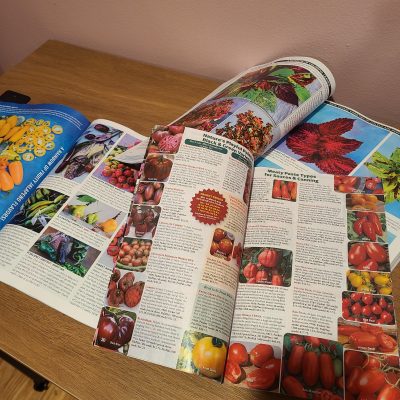
Temperatures are dropping, the holidays are over, and gardeners are starting to look towards the next growing season with excitement. Many gardeners swear by the tried-and-true heirloom varieties, while others are drawn to the disease resistance or increased vigor of hybrids. The debate over which is “best” can get heated between gardeners. Do you know the differences?
Pollination is a key factor. Successful pollination occurs when pollen meets the sticky central part of a flower, known as the stigma. Fertilized seeds develop in the ovary, which will then form into fruit. Over the span of thousands of years, tasty fruit has proven to be a good way to help with seed dispersal in the environment. And taste, along with many other traits, have helped humans decide what plants to cultivate.
Hybrid seeds, also commonly referred to as “F1” or “F1 hybrids,” have been developed through selective breeding. To create an F1 hybrid, breeders have selected parent plants with desirable traits and pollinated them under controlled conditions. While it sounds easy enough, lineages can be tricky. It can be time consuming for plant breeders and some will spend years of their career trying to achieve a specific outcome.
F1 hybrids are often praised for their environmental resilience and higher yields, among other traits. They may be less reliable for seed savers, though, as the offspring of the F1 hybrids are not guaranteed to come back with the same traits as the original plant from your first season, a term we call “true to seed.”
Hybrid seed should not be confused with GMO or genetically modified seeds. Hybrid seed is a product of breeding and selection and does not undergo the laboratory interventions that are needed for genetic modification. Currently, there is only one GMO product available to home gardeners, known as “The Purple Tomato.” All other GMO seed is only available commercially and farmers using these products must sign agreements that lay out the terms of use for the seed purchased.
You may find the term “open pollinated” in your search for seed. These seeds are created without direct human intervention. They have stable genetics and produce predictable traits in their offspring year after year, since they are naturally pollinated. This is great news for those gardeners who enjoy saving their own seed.
It is best to plant open pollinated varieties of similar species away from each other to avoid random cross-pollination. Alternatively, gardeners cand hand pollinate a few flowers and keep them covered. For this, I recommend mesh party favor bags that allow for the fruit to expand. Allow the fruit to develop and harvest them specifically for their seed.
Heirloom seeds are open pollinated plants that have been passed down usually over generations. Often, there is a local history or cultural significance that comes with them. You can find interesting physical traits and some beneficial resistances from heirloom seeds. Since they are open pollinated, their genetics are more likely to be stable and produce true to seed offspring for seed savers, as well.
At the end of the day, I always advise gardeners to look beyond the title and really assess what is going to meet your needs and make your experience most enjoyable. If you love to tell a story with your garden, and enjoy saving your seeds year after year, an heirloom variety might be the perfect fit! On the other hand, if you bring home a packet of tomato seeds that have been bred for small space gardening, and you plan to buy new seeds every year, then enjoy that tomato to its fullest! There are many gardens out there with a beautiful blend of both.
If you have questions about seed selection, or for other gardening questions, contact the UCONN Home & Garden Education Center, toll-free, at (877) 486-6271, visit their web site at www.homegarden.cahnr.uconn.edu or contact your local Cooperative Extension Center.
This article was published in the Hartford Courant Jan. 11, 2025
2024
Plant Hazards to Avoid this Holiday Season
By Nick Goltz, DPM, UConn Home & Garden Education Center, UConn Plant Diagnostic Lab

Using low-heat LED lights is a great way to reduce fire risk while keeping things festive. The stewards of this tree toko the extra step of installing a rope fence to discourage visitors from damaging the tree or lights. (Photo taken by Nick Goltz)
With the holidays upon us, many of us are focusing, with good reason, on last-minute gifts, travelling, reconnecting with loved ones, and all the joy and stress that will inevitably come with it. With all the hustle and bustle of the season, it can be easy to overlook some of the safety hazards that also come about this time each year, especially those involving the holiday plants that we rarely give a second thought.
On countless desks, coffee tables, and, in warmer climes, doorsteps, you are likely to encounter at least a dozen poinsettias this December. Poinsettias (Euphorbia pulcherrima) are some of the most conspicuous and popular plants associated with the holiday season here in the US. They are often thought to be highly poisonous if ingested. While ingestion may cause some mouth and skin irritation and gastrointestinal upset, sometimes with some associated vomiting or diarrhea in small animals, poinsettias are vastly “overhyped” with their supposed toxicity.
There is no documented case of human fatality associated with poinsettia ingestion, and most calls to poison control lines for ingestion report no adverse symptoms whatsoever. Medical intervention is usually unnecessary for people or pets that ingest the plant, except for those with allergic reactions to related plants (particularly those with latex sensitivity). For more information on poinsettias and their fascinating history, see Heather Zidack’s column from mid-November, “Poinsettias: The Story of a Holiday Treasure”. While poinsettias may be overblown with regard to their supposed toxicity, other common plants one might see around the holidays, including amaryllis and mistletoe, are quite toxic to humans and pets if ingested.
What we call “amaryllis” in most stores and garden centers is likely not the true South African amaryllis (Amaryllis belladonna), but rather a related South American plant in the genus Hippeastrum, which has been cultivated more extensively and has a greater number of cultivars on the market. Both are bulbous tropical plants that bloom in winter in the northern hemisphere, and both are poisonous if ingested. The bulb, commonly sold waxed or bare in stores around the holidays to be used as a table centerpiece or hostess gift, is especially toxic and should be kept away from pets and children. If you’re curious to learn more about the history and cultivation of this holiday plant, check out Dr. Matt Lisy’s recent blog post, “Amazing Amaryllis” on the UConn Home & Garden Center’s very own Ladybug Blog (https://uconnladybug.wordpress.com/).
Though in antiquity it represented fertility and offered protection from evil, mistletoe (usually Viscum album, European mistletoe and Phoradendron leucarpum, American mistletoe) has been associated with Christmas since some point in the late 1700’s. Though lovers may steal a kiss or two beneath the mistletoe this Christmas, be sure the mistletoe can’t be stolen by children or pets as you decorate for your holiday party! Although European mistletoe is more toxic than American mistletoe, both plants are dangerous if ingested, particularly by pets and children, who may be attracted to the small white berries that have a high concentration of toxin. If you know someone that accidentally ingests a plant not known to be edible, be sure to contact the poison control hotline by calling 1-800-222-1222 or by visiting https://www.poison.org. For pets, contact the ASPCA poison control hotline by calling 1-888-426-4435 or by visiting https://www.aspca.org/pet-care/animal-poison-control. Conveniently, they have a poisonous plants list on this site that you can reference as you shop at your local nursery or garden center.
Though thankfully Christmas trees (typically fir, pine, or spruce) are not known to be toxic to pets if ingested, the sharp needles can cause injury if ingested and the trees themselves can pose other hazards if not maintained with care! If you have a pet that likes to chew through wires (there is a scene in a famous Christmas movie that likely comes to mind), be sure to keep those out of reach, or perhaps opt for battery-powered illuminating ornaments. For their safety and yours, cats and birds should always be discouraged from climbing or flying into your tree!
Finally, though we all can appreciate rustic and vintage holiday décor, another strategy to reduce the risk of fire this holiday season is to upgrade your string lights to low-heat LEDs. Whatever type of string light you use, unplug it before you go to bed to help reduce fire risk. If you use a live tree, be sure to keep it watered as dehydrated trees are more likely to catch fire.
With these tips in mind, the Plant and Soil Health team at UConn wishes you and your loved ones a safe, joyous, and restorative holiday season! For questions regarding winter plant safety or for any other gardening questions throughout the year, contact the UConn Home & Garden Education Center for free advice by calling (877) 486-6271, toll-free, visit our web site at www.homegarden.cahnr.uconn.edu/, or contact your local Cooperative Extension Center.
This is For the Birds!
By Dawn Pettinelli, UConn Home & Garden Education Center
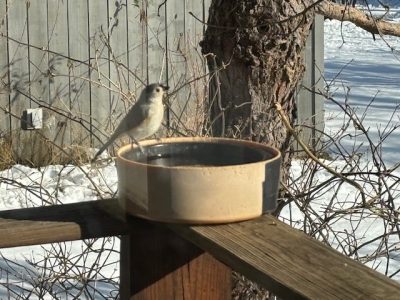
As December brings frigid temperatures and snowy landscapes to Connecticut, our feathered friends face unique challenges in finding the resources they need to survive. Shorter days and frozen ground make food and water scarcer, while icy winds and snow create harsh conditions for shelter. By providing birds with seed, water, and shelter, you may be making a significant difference in their survival and well-being during this often challenging season.
Winter robs many birds of their natural food sources like insects, berries, and seeds. While it is true that birds can survive without our subsidies, supplemental feeding can provide extra energy that birds need to maintain their body heat. In December, focus on offering high-calorie foods that cater to a variety of species common to Connecticut, such as chickadees, cardinals, juncos, and woodpeckers.
Many types of bird feeders are available including hopper and platform feeders, tubes, and suet cages. Whichever you choose, it should be one that can be washed out every week or so. Uneaten seed pieces and other debris can mold plus there is the chance of contagions whenever living creatures congregate.
Feeding the birds is a popular activity and there are many types of seeds, seed mixes and other foods available for purchase. Black-oil sunflower seeds are a favorite of many birds, thanks to their high-fat content and thin shells, which are easy to crack. You can buy shelled seeds to minimize the pile of shells that accumulates under the feeder. Smaller white safflower seeds are included in many seed mixes and are reputed to be a favorite of cardinals. Thistle or Niger seeds are a sought-after treat for finches and other small birds. I have only tried using a thistle sock once and found it got soggy, and the seeds froze so maybe a specialized tube feeder would be the way to go if offering this food source.
Unshelled peanuts are a great fuel for birds supplying both protein and fat. They are also a sure way to attract squirrels. I have been buying unsalted, dry roasted peanuts and put a few handfuls on my porch railing each morning when I put out the water bowl for the birds. There’s a regular assortment of birds who eagerly await their morning breakfast and the peanuts are gobbled up by titmice, chickadees, flickers, downy woodpeckers and blue jays before the squirrel even has a chance to make it to the porch from the woods.
A good seed mix for the feeder should contain a variety of food items including black-oil sunflower seed, cracked corn, safflower, peanut chips, white prose millet, and maybe some sunflower hearts and dried fruit. Like most things in life, you get what you pay for, and cheaper mixes often contain that red milo and other fillers that birds in our area are not partial to. If you notice piles of uneaten seeds under your feeders, try switching to another seed mix.
Many bird species, but especially insect eaters, really love suet. Packed with fat, suet provides essential energy and attracts woodpeckers, nuthatches, blue jays and I’ve even had crows in queue for their turn at the suet feeder. Opt for suet mixed with seeds, berries, nuts or mealworms for added nutrition.
Place feeders in somewhat sheltered areas to protect birds from the winds but make sure that they are not located near where predators can hide. Refill regularly, as food is quickly consumed in cold weather. Be on the lookout for bears. Typically, they are not a problem from mid-December through mid-March but if a bear finds your feeder, bring it in and cease feeding.
During a typical, cold winter water is a rare and precious resource. While snow can provide hydration, many birds prefer liquid water for drinking and bathing. Maintaining a water source in freezing temperatures can be a lifesaver. I opt for a Solar Sipper that I have had for years. It is just a bowl inside a bowl with a cover that has a hole in the top. It keeps the water from freezing down into the 20s, especially on a sunny day. I just bring it in at night, wash it and put out clean water in the morning. Heated birdbaths are another more hi-tech option.
December’s freezing temperatures and strong winds make safe shelter essential for birds. They need places to roost, stay warm, and avoid predators. Encourage birds to stay in your yard by planting native trees, shrubs, and evergreens. Dense conifers like spruce, hemlock, and pine provide excellent cover from snow and wind. Additionally, leaving leaf piles or brush heaps in your yard creates ground-level shelter for birds like sparrows and juncos. Refrain from cutting back seedheads from coneflowers, coreopsis, goldenrods, sunflowers and native grasses to provide natural seed sources.
Providing food, water, and shelter not only supports birds during the toughest months but also brings joy to your home. Watching vibrant cardinals against the snow or hearing the cheerful calls of chickadees can brighten even the coldest day. By creating a welcoming space for birds in your backyard, you contribute to their survival and get to enjoy the beauty of nature during winter’s quiet, cold days.
For your gardening questions, feel free to contact us, toll-free, at the UConn Home & Garden Education Center at (877) 486-6271, visit our website at www.homegarden.cahnr.uconn.edu or contact your local Cooperative Extension center.
‘Tis the Season for Holiday Plants
By Dr. Matthew Lisy, UConn Adjunct Faculty
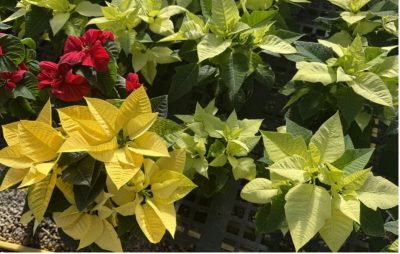
Once again, the winter holiday season is upon us! I am sure I have said this before, but I never cease to be amazed at the seemingly endless varieties of holiday plants available. This year, I planned on not buying any holiday plants, but one trip to two local greenhouses changed my mind immediately. If one plant could exemplify the season, it would be the Poinsettia. Although red and white Poinsettias have been the standard for many years, there are a lot of really neat colors available if you look hard enough. One of my all-time favorites is orange. I used to grow this variety when it first came out, and could never stock enough of them. In the old days, you needed to set it next to a red one to tell the difference, but fast forward many years, and the orange is now much more intense and can stand alone in all its glory.
If I had to pick just one favorite Poinsettia, it would be the yellow. It just looks so unusual and unlike anything else. I first saw it years ago in small quantities in a big box store, but now they are much more common. The regular white has a slight yellow tint to it, but there is a super bright white that looks as pure as freshly fallen snow. Another new favorite is called “Christmas Mouse,” and has rounded leaves that resemble mouse ears in contrast to the normal pointed ones. Of course, there are also Poinsettias that are actually spray painted with a plant-safe paint. These plants usually also have glitter sprinkled onto them. Even though these are artificial looking, they are beautiful works of art in their own right.
There are new varieties of cyclamen around too. These are characterized by interestingly shaped flowers that are more open. Some of the varieties even have the flowers turned upright. The colors are amazing and range from dark maroon reds to almost neon pink. Another plant I am really excited to see this year is the Amaryllis. These have been around an extremely long time, but what changed is the number of places carrying many different varieties for sale. I like when I can just buy the bulb and pot it up on my own. This is less expensive and allows me to buy more varieties. There are even some places selling the bulbs with a type of paint coating on them which is said to eliminates the need for watering. I prefer a bulb in a pot as I think it looks more natural, but that is a matter of opinion. What I have seen a lot less of this year is the Christmas Cactus. While they are still around, their numbers are not nearly as plentiful as in the past. The Amaryllis and Christmas cactus are the two plants you can keep long term. They each have special care routines that you will need to follow to get them to bloom again the following year. The Christmas cacti need a certain lighting (or darkness) period, and the Amaryllis need a dry dormant period.
Wherever you are going for the holidays, I suggest bringing one of these festive plants to the host as a gift. There is nothing more cheerful than a brightly colored plant during the dark days of winter. On that note, why not buy some for yourself and enjoy them all season? Either way, I suggest you make the most of things with a nice new plant variety that you never had before. There certainly are plenty from which to choose!
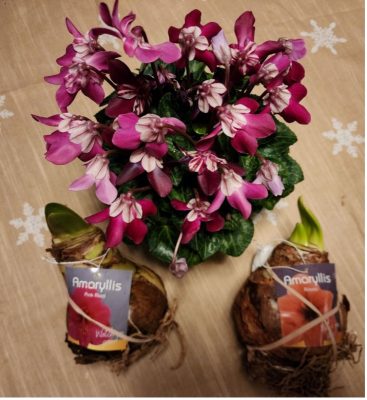
For your gardening questions, feel free to contact us, toll-free, at the UConn Home & Garden Education Center at (877) 486-6271, visit our website at www.ladybug.uconn.edu or contact your local Cooperative Extension center.
Holiday Gifts for Gardeners
By Dawn Pettinelli, UConn Home & Garden Education Center
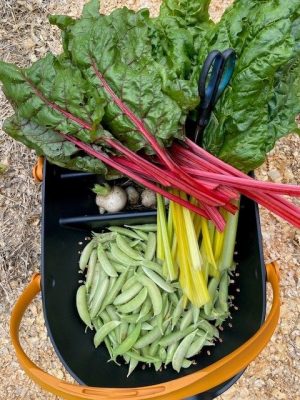
Let the holiday shopping begin! Compared to many family members and friends, buying a gift for the gardener in your life is a breeze. Lots of great possibilities and there’s always the option of a gift certificate to their favorite local garden center. These are just some of my personal suggestions.
With long, dark days settling in, reading is a great winter sport. I’m partial to whodunnits and might curl up with The Garden Party by Marty Wingate or The Garden Club Murder by Amy Patricia Meade. For non-fiction readers, especially those longing for greater self-sustainability, perhaps Small-Scale Homesteading by Michelle Bruhn and Stephanie Thurow might be an informative resource when just starting out. With all the calls we get about vegetable problems, two books by Susan Mulvihill; The Vegetable Garden Pest Handbook and The Vegetable Garden Problem Solver offer up lots of great photographs and least toxic controls for a myriad of insects, diseases and other pest problems. Of course, you can also call us at the Center for assistance.
Gardening magazines still offer excellent articles, advice and inspiration. A subscription to the Connecticut Gardener should be in every CT gardener’s mailbox or inbox. Fine Gardening is also CT based and fills our head with amazing plant information and truly inspiring gardens. I’ll also admit to a subscription to both Horticulture and The American Gardener.
Working in the garden often brings me to my knees and when that up close and personal, I find there are 2 tools always in my bucket. First is a Cobra head weeder, crafted in Wisconsin last I looked. This curved-headed tool can be used for weeding, thinning, making seed rows, digging in little seedlings and whatever other use you can come up with; a multi-tasking tool that is long-lasting and affordable. My deluxe soil knife features a smooth, sharp side and a serrated side with inch measurements, useful when planting. I find it does a nice job dispatching both annoying roots and jumping worms. When deployed on the ground, those larger, oval-shaped kneelers are tough and functional.
In my most recent issue of The American Gardener, there is a Craftsman 54-inch wood-handle action hoe that I would like to try so I can weed standing up. It works with a manual push-pull action but might be just the thing us older gardeners need.
While I have 2 different types of pruners that are great for stems from about a half to one inch in diameter, I can use help on the opposite extremes. Last year my sister got me a hand-held mini-chainsaw and it is wonderful for removing 1 to 3 inch or so stems or branches. It’s really made pruning much easier. On the other end of the spectrum, a pair of horticultural scissors with long blades treated to resist rust would be great for harvesting or deadheading cut flowers as well as indoor houseplant grooming.
For years, I have placed picked vegetables, whether peppers, carrots or chard into those attractive wicker baskets. Recently, I was given one of those garden trugs made out of recycled plastic that had holes on the bottom so I could gather up my harvest and then hose the soil off in the same container. There are several trugs on the market including those made of wood and wire mesh. They do make cleaning your vegetables a lot easier than doing it at the kitchen sink.
Gardeners go through gloves and despite what the ads say, if a pair lasts me a season, I’m lucky. They are always needed and appreciated, and you can’t go wrong gifting these to a gardener. For those with a lot of roses, consider purchasing a pair of rose gauntlets so their arms won’t get all scratched up when pruning.
Indoor gardeners might appreciate watering cans with long spouts that dispense water slowly, attractive cache pots, houseplant fertilizers, cork plant coasters or misters. Bird lovers may enjoy feeders, bird baths, bird houses or seed and suet for their fine-feathered friends.
There are many types of garden ornaments to present to your plant loving friends and family. Plus, tis the season for holiday plants – poinsettias, holiday cacti, amaryllis, frosty ferns are just a few of the selections that your gardener recipient might enjoy. With all these choices, the gardener on your gift list is sure to be pleased.
For your gardening questions, feel free to contact us, toll-free, at the UConn Home & Garden Education Center at (877) 486-6271, visit our website at www.homegarden.cahnr.uconn.edu or contact your local Cooperative Extension center.
Poinsettias: The Story of a Holiday Treasure
Poinsettias: The Story of a Holiday Treasure
By Heather Zidack, UConn Home & Garden Education Center
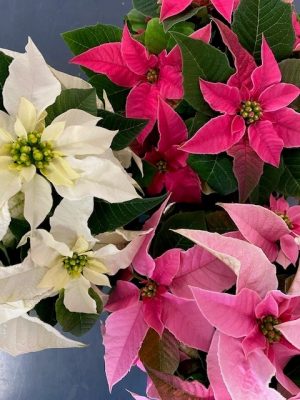
It just isn’t the holiday season without a poinsettia. We adorn homes, churches, and other public spaces with them at this time of year. Their bold color and striking presence are hard to miss. With a story as spectacular as their seasonal color, the poinsettia is a plant to be treasured.
Poinsettias have a rich history and culture. While we associate them with the coldest time of year here in the Northeast, they actually come from a much warmer climate! Known as Cuetlaxochitl in their native region of Mexico, they were cultivated and used by indigenous peoples for medicines, dyes, and decorations. In Aztec culture, the Cuetlaxochitl held cultural significance as a symbol of purity and were also used to symbolize a new life earned by warriors who had died in battle. The Mayans called this plant k'alul wits. Many traditional uses for k’alul wits are still practiced by the Téenek people in southeastern Mexico, today.
Their association with the Christmas holiday started when Franciscan monks in Mexico began to use their bright red and green foliage to decorate nativity scenes. It became known as la flor de Nochebuena, translating to “the Christmas Eve flower.” It was brought to the United States by Joel Roberts Poinsett, the first U.S. minister to Mexico, in 1825. Poinsett was a man of many talents, having a career in politics, a passion for science, and an enthusiasm for agriculture. Through continuous plant breeding and developments, there are now hundreds of varieties of poinsettia.
Contrary to popular belief, poinsettia flowers are small and barely noticeable. The insignificant yellow flowers are surrounded by stunning, colorful bracts. Bracts are not flower petals, but rather, specialized leaves. The bracts of a poinsettia change color when daylight hours begin to shorten. Breeders have developed poinsettias that have bracts of various shapes, textures, and colors. Some are variegated or have speckles of color on them. These cultivated varieties (cultivars) are quite different from the straight species, Euphorbia pulcherrima, in its native environment, where it can grow over 10 feet tall, is semi-evergreen, and can sometimes grow a bit scraggly.
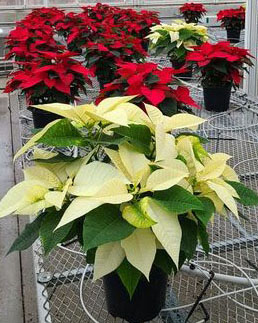
Greenhouses start poinsettia production as early as July. Tiny plugs get put into their pots while we’re all still soaking up the summer sun. (It makes sense when you remember that they’re originally from Mexico!) They grow as little green plants through the rest of summer and autumn. The fall equinox will naturally trigger these plants to change color, however, growers can manipulate their greenhouses to create ideal darkness/brightness to help time the coloring of their plants for holiday sales.
If you’ve got a green thumb and are trying to get a previous years’ poinsettia to “reflower,” simulating this dark period with an opaque container, paper bag, or moving the plant into a closet or dark location for 14-16 hours a day can do the trick! Make sure they’re receiving 8 hours of bright, direct light, and not a ray more! After about 4 weeks of these conditions, most poinsettias can go back to their life with your other houseplants, as normal, and you should see a change in color.
Shopping for a new poinsettia as a gift or decoration this year? Always shop for a plant that is brightly colored and has tight (tiny yellow) flowers that aren't already going by. Select a plant that has evenly moist soil, and a nice shape that doesn’t appear to have been crowded for too long. Here in Connecticut, make sure that your florist, grocer, or grower packages the poinsettia for you to help protect it from cold winds while transporting it to and from your car. When you get it home keep it away from entryways, drafts, fireplaces, or heating vents, and keep it in a room that is between 60° and 70°F. Water your poinsettia when the soil begins to dry out in the pot and enjoy the holiday season.
Whether you’re reviving an old poinsettia, shopping for a new one, or deciding that artificial is the best choice for your home this year, take the time to recognize the special journey these plants have taken to become such a treasure and staple in our holiday celebrations. There truly isn’t anything quite like it!
For questions about caring for your poinsettias or for other gardening queries, contact the UCONN Home & Garden Education Center, toll-free, at (877) 486-6271, visit their web site at www.homegarden.cahnr.uconn.edu, or contact your local Cooperative Extension Center.
Berry Good Pick for Winter Interest
By Dawn Pettinelli, UConn Home & Garden Education Center
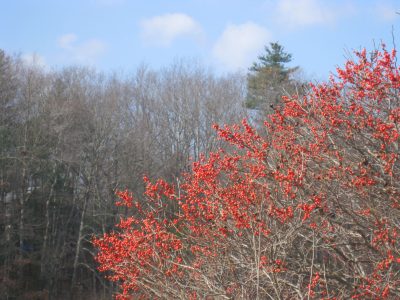
Looking for a splash of color in your yard amid winter’s dreary landscape? Check out one or more of the many winterberry (Ilex verticillata) cultivars. This deciduous member of the holly family sports bright, shiny red berries from early fall through late winter. Branches may be cut and used in holiday arrangements.
Winterberry can be found growing throughout eastern North America from Canada down along the east coast and west to Texas. Look for the brilliant red berries when driving past marshy areas in particular. While winterberry will grow in well-drained soil, it is a great candidate for areas that stay moist and aren’t particularly well drained. These plants naturally occur in forested wetlands as well as along the banks of streams, ponds or other water sources.
There are several factors to consider when selecting a winterberry bush for your yard. One of the most important is the mature size of the plant. Cultivars are available that vary from dwarf, 4-foot, compact plants to 15-foot, more rangy specimens. ‘Red Sprite’ and ‘Berry Poppins’ are two red-berried, compact cultivars. ‘Winter Red’ and ‘Sparkleberry’ typically top 10 feet. Check out suggested cultivars for Connecticut with the UConn Plant Database (https://plantdatabase.uconn.edu/). While initially slow growing, winterberries may eventually form clumps through suckering and depending on the cultivars, may form dense stands if allowed.
The berries on most cultivars are a brilliant red. There are, however, some that have gold or orange fruits. ‘Goldfinch’ boasts golden yellow berries while both ‘Aurantiaca’ and ‘Afterglow’ offer delightful orangey fruit.
Do realize that plants are dioecious, meaning that individual plants may be male or female. Only the female plants produce berries. The male plants supply the pollen to fertilize the female’s flowers so that berries are produced. One male plant can fertilize at least 10 females if located within 50 feet or closer. Look at tags so a compatible male cultivar is chosen. Appropriate pollinators should be listed on nursery tags.
Unless plants are in bloom or have berries, it is not possible to tell males from females, but they should be marked on their tags at the nursery. When in bloom, the female flowers have tiny green immature berries in the center while the males have fluffy, yellow, pollen-bearing anthers. Occasionally the female flowers have non-pollen bearing anthers, probably effective is luring pollinators to fertilize their flowers. Although not common in Connecticut, one native species of cellophane bee, Colletes banksi, is a specialized pollinator of winterberry.
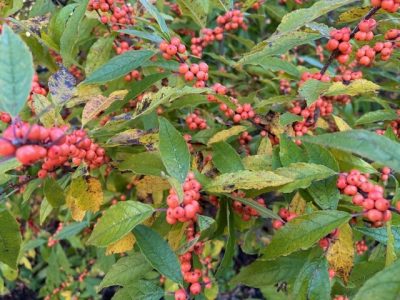
Winterberries do best in full sun to partial shade. The shadier the site they are grown in, the fewer blossoms and berries they will produce. Being native New Englanders, they prefer acidic soils rich in organic matter. If your soil pH is between 5 to 6.5, plants should happily grow. Once plants are established, only minimal fertilization is usually required. For the first few years, about a cup of a complete organic or synthetic fertilizer could be lightly worked into the soil surrounding the plant each spring.
Plants can be used in foundation plantings, as a hedge, in rain gardens and when setting up areas attractive to wildlife. Not only are pollinators attracted to the flowers but over 48 species of birds feed on the berries, typically after they soften following periods of freezing and thawing.
Pruning can be tricky and is best kept to a minimum so selecting the right sized cultivar for your particular site is crucial. Winterberries have an upright growth habit but may sucker. They bloom on old wood meaning the flower buds that open in the spring were formed last fall. If grown as a multi-stemmed shrub, a few stems can be removed if plants seem crowded.
Complaints about little or no berry production may be due to lack of a male pollinator, too much shade, young plants that have not established a good root system, improper pruning or excessively dry conditions. In general, winterberries are rewarding, easy to grow shrubs that make quite the impact when little else in the landscape stands out.
For questions about selecting or growing winterberries or for other gardening queries, contact the UCONN Home & Garden Education Center, toll-free, at (877) 486-6271, visit their web site at www.homegarden.cahnr.uconn.edu or contact your local Cooperative Extension Center.
The Fall Invasion of the Asian Lady Beetle
By Marie Woodward, UConn Home & Garden Education Center

As the leaves change color and the weather turns colder, many people look forward to the beauty and coziness of autumn. However, one uninvited guest often accompanies the season: the Asian lady beetle. This insect, scientifically known as Harmonia axyridis, can be a nuisance to homeowners as it seeks shelter in warm buildings during the fall months.
The Asian lady beetle is native to eastern Asia but was introduced to the United States and other parts of the world in the early 20th century as a biological control agent for aphids and other pests. While they are highly effective at controlling these pests in the gardens and crops, their rapid spread and tendency to congregate in large numbers have caused problems for homeowners.
These beetles are easily recognizable by their orange to reddish-brown coloration, small black spots on their wing covers, and distinctive M-shaped marking behind their head. Their size ranges from 5-8mm in length. They have six short legs and two antennae.
During the fall, the Asian lady beetle seeks protected locations to spend the winter. They gather in large groups, often on the sunny side of buildings, before ultimately finding their way into homes and other structures through cracks and gaps. It is not uncommon to find them gathered in attics, wall voids, or other quiet, undisturbed areas.
Once inside, these beetles can become a nuisance due to their sheer numbers and tendency to release a yellowish, foul-smelling liquid when disturbed. This liquid can stain walls, fabrics, and other surfaces, and may cause allergic reactions in some individuals. Additionally, some people find the beetles’ scent unpleasant or even nauseating.
Prevention is key to avoiding an Asian lady beetle infestation. Sealing entry points, such as cracks around windows, doors and utility openings, can significantly reduce the likelihood of an invasion. Additionally, keeping exterior lights off at night and planting trees or shrubs away from the house can reduce the attractiveness of your home to these insects.
If beetles have already found their way inside, using a vacuum cleaner is the best means of removal. However, be sure to dispose of the vacuum bag or empty the canister outdoors immediately to prevent the beetles from returning back into your home. Alternatively, insect light traps or sticky traps can help capture and remove beetles.
It’s essential to remember that while the Asian lady beetle can be a nuisance, it is not a significant threat to your home or your health. Taking proactive measures to prevent their entry and managing their presence can significantly reduce the annoyance caused by these uninvited guests.
As the fall season arrives, keep in mind the potential for Asian lady beetles to seek shelter in your home. By understanding their behavior and implementing preventive measures, you can enjoy the beauty and warmth of autumn without the invasion of these pesky insects.
If you have questions about Asian lady beetles or other gardening topics, contact the UConn Home & Garden Education at (877) 486-6271 or www.homegarden.cahnr,uconn.edu or your local Cooperative Extension Center.
Do You Dig Dahlias?
By Dawn Pettinelli, UConn Home & Garden Education Center
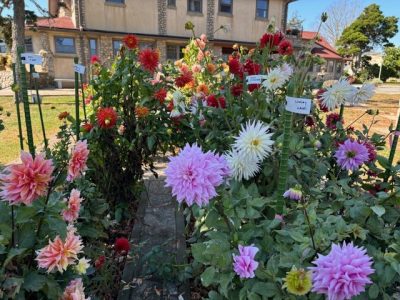
A couple of weeks ago, I was fortunate to visit the spectacular dahlia gardens on Enders Island in Mystic. For those unfamiliar with this retreat, an 11-acre seaside estate was donated to the Society Edmund by Mrs. Alys E. Enders in 1954. This Roman Catholic religious community offers ministry, retreats and respite to many. The grounds are open to all for contemplation or just unbound appreciation of nature and horticultural beauty.
Gardeners will delight in the gorgeous, well laid out garden rooms but especially be entranced by the vast array of dahlias. The gardens at Enders Island are filled with over 300 varieties of prize-winning dahlias in all colors (except blue), shapes and sizes imaginable. A Dahlia Preservation Trust was established to preserve the dahlia collection that is rated as one of the largest in New England.
Any of us growing dahlias while appreciating their cheery, attractive blossoms lasting long into the fall, do realize they are not winter hardy, even with milder winters attributed to climate change. Dahlias are native to Central America. In fact, they are Mexico’s national flower. Those wishing to save the tuberous roots for replanting next year, must dig them up and store them over the winter.
Ideally, gardeners should wait until a frost blackens the foliage. Then, if possible, wait a week so any carbohydrates left in the above ground tissue can make their way to the roots to enable good sprouting next spring when the tuberous roots are replanted. This has been a particularly confusing fall to both plants and gardeners. Frosts have hit some areas but often not severe enough to affect all plants and dahlias in more protected sites are still blooming their heads off, a trait most appreciated by pollinators such as bees.
On the other hand, it is November. Time to reign in gardening activities and begin preparations for the holidays. What’s a gardener to do?
Since my plants were losing bottom leaves to disease and looking a little ragged, I just decided it was time to dig them and move the tuberous roots into the cellar. Before digging any dahlias, be sure to note their names. If tags were not written out when planting, make them out now if color and flower type are important.
Cut back stems to 2 or 3 inches and carefully dig the tubers starting at least 8 inches away from crowns so tubers do not get sliced or speared. Use a spade or pitchfork but dig in carefully. This year the soil is so dry that it was not necessary to leave the tuberous roots in the sun for a few hours so the soil clinging to them could dry and be shaken off. Every one I dug up was dry enough so that practically no soil clung to the roots. Each was placed in a separate container with repurposed labels.
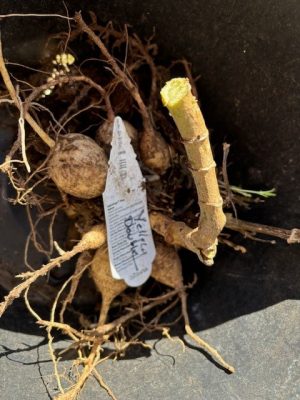
Perusing through online sources, many suggest washing tubers off with a hose and letting them dry before storing. I have let them dry out in wet falls and shaken dried soil from them before storing but have never hosed them off. Maybe follow the approach that makes most sense to you. If any remaining soil is washed off, the tuberous roots should most likely be stored in lightly moistened peat moss or other slightly damp organic material, so they will not desiccate over the winter. For me, leaving a bit of soil around the roots that are stored in pots in the cellar over winter helps to keep tubers from shriveling with only a sparse sprinkle of water once or twice a month.
When happy, dahlias will multiply but it is probably best to leave the whole clump together and separate it before planting next spring when multiple buds or eyes can be seen. Keep the tuberous roots at 45 to 55 degrees F and check every 2 to 3 weeks for signs of decay or desiccation.
For an early start, the tuberous roots can be set into beds usually by late April unless unseasonably cold weather is predicted. If you have questions about overwintering dahlias or for other gardening questions, contact the UCONN Home & Garden Education Center, toll-free, at (877) 486-6271, visit their web site at www.homegarden.cahnr.uconn.edu or contact your local Cooperative Extension Center.
Helping Plants During the September-October Drought
By Pamm Cooper, UConn Home & Garden Education Center

Here at the UConn Home and Garden Center we have been getting questions about lawn and garden issues that have been particularly widespread in the state. Whether in the landscape or the garden, there is always something going on, good or bad, and keeping up with pests or cultural issues can be challenging. Because of the extended late season drought conditions this year, plants may be showing signs of stress. There are some basic things homeowners can do to help plants go into winter as healthy as possible.
Plants in temperate climates, like we have in New England, are normally manufacturing food to enable carbohydrate storage for new growth that will occur next spring. To do this, plants need both sunlight and water, and our extended drought conditions have limited most plants to enter survival mode, and carb storage is a second priority. The best way to help your plants is to water deeply any that still have green leaves. People with wells may need to determine if this is a priority for them. We can hope for a warm winter or insulating snow cover to help any plants with shallow roots survive until warm weather returns.
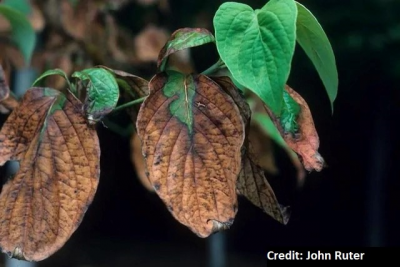
One sign of drought stress in woody broadleaf plants is leaf edges that curl upward. This is a good clue as to the beginning of water stress. Make sure to water these plants deeply, to ensure roots will be able to pick up the water. Usually the next day, leaves will start to uncurl if adequate water is applied. If drought stress continues, leaves may turn brown at the edges and early leaf drop may occur.
Evergreens, even established ones, can benefit from regular watering as long as the soil is not frozen and drought conditions remain. Evergreen foliage, whether needles or leaves, photosynthesize all year, and it is important that soil is not dry. Normally, we have snow that melts on and off, and if soils are not frozen, roots will be able to take up water and photosynthesis can still take place.
Perennials of certain species may be doing fine in this drought. Yarrows, some ox-eyed daisy cultivars, obedient plants, goldenrods, mountain mints and Agastache may be showing no signs of stress. Still, if any have green leaves at this point, consider watering them if dry and warm conditions continue.
This weekend I planted a small shrub, and I had to dig about fourteen inches down to accommodate the root mass. I have to say that I was surprised that the soil, not particularly one that dries out often, was powdery to the bottom of the hole. If you are planting anything now, make sure to water the soil thoroughly as you fill in the area around the roots, then water again when done. This is especially needed for small trees and shrubs but do the same for perennials.
Next year, woody plants that were impacted by drought this year may be more susceptible to certain diseases like verticillium wilt, Nectria canker and evergreens to Rhizosphaera needlecast. Be vigilant and scout for any signs or symptoms of these diseases.
Lawns that did not receive any rainfall or supplemental watering during the past two months may be dormant and crunchy at this time. It may not be clear if the grass will recover when temperatures cool and adequate water is applied. Some grass species may be dead, but it may not be clear until next spring when they fail to green up. There still may be time to apply supplemental irrigation, and with warm temperatures, grass may or may not green up, but at least the crowns may be kept alive to generate new leaves next spring. If any lawn areas were seeded in late summer, water new grass as needed. If it is wilting, water it for sure.
Be alert to what is happening in your own backyard, for the sooner you discover any problems the better. Contact us at the University of Connecticut Home and Garden Education Center for advice on lawns, landscapes, and other gardening subjects. Here's hoping for some needed rainfall and cooler temperatures to help our plants recover from the trying drought of 2024.
Penn State Extension has a good article on long-term effects of drought stress- https://extension.psu.edu/the-long-term-impact-of-drought-on-trees-and-shrubs
If you have questions about caring for plants during a drought, or if you have other gardening questions, feel free to contact us, toll-free, at the UConn Home & Garden Education Center at (877) 486-6271, visit our website at www.homegarden.cahnr.uconn.edu or contact your local Cooperative Extension center.
Gorgeous Grasses
By Dawn Pettinelli, UConn Home & Garden Education Center
Autumn shines a spotlight on ornamental grasses. With their rustling blades and fluffy seedheads they are star performers in late season gardens going head-to-head with asters, mums, Montauk daisies and boltonias. Plus, they are great in fresh or dried cut flower arrangements.
The huge selection of grass species available is great for gardens but makes selecting difficult. Heights range from a few inches to more than 6 feet; colors from deep green to chartreuse, burgundy to black. Solid or variegated? Would a clump former, spreader, or self-seeder best fit your needs? Are seed heads important for fall and winter interest? Is this grass planted as an ornamental feature in your garden bed or landscape or are you looking for natives to support pollinators and perhaps serve as food for birds and others? Answers to these questions may guide you in grass selection.
Two favorite non-natives grown for their ornamental value are cultivars of Miscanthus and Pennisetum. While the miscanthus species has been listed as potentially invasive in CT, a number of attractive cultivars are available for purchase and can be striking if well positioned in the garden. Two outstanding selections are ‘Gracillimus’ and ‘Zebrinus’. The first has shimmering silver veined green leaves growing in graceful mounds. Reddish flower plumes emerge in fall changing to a light silvery hue. Plants are clump formers but can reach 6 feet or more in height.
‘Zebrinus’ is more commonly known as zebra grass for its definitive yellow and dark green striped foliage. This plant gets big over time. Mine is now 6 feet across and probably 10 feet high. I wrap a rope around it in the late summer to keep it upright through fall rains and winds. Stalks have been used quite effectively as a substitute for cornstalks around the lamppost.
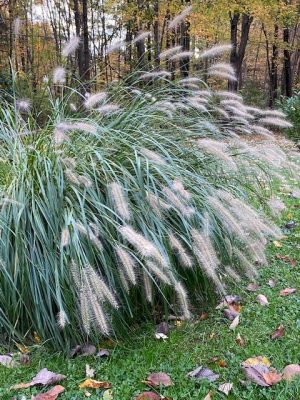
My Pennisetum alopecuroides was grown from seed probably 20 years ago. These plants are absolutely gorgeous in the fall. Despite the many bottlebrush seed heads, I’ve never found a seedling. The fine, arching foliage resemble flowing water hence the common name, fountain grass. Cultivars of this graceful, flowing grass range from 18 inch ‘Piglet’ to 5 foot ‘Fox Trot’.
Native grasses are soaring in popularity and much easier to find at garden centers than they used to be. One switchgrass (Panicum virgatum) cultivar, ‘Heavy Metal’, is quite popular for its upright, striking blue-green foliage. If happy, it can reach 4 to 5 feet in height. The wheat-colored seed plumes are attractive to us during the gloomy winter months but also as a food source to a number of bird species.
Little bluestem (Schizachyrium scoparium) is a favorite also of humans and wildlife, including both birds and butterflies. This upright native grass is pretty ubiquitous along roadsides and in fields and meadows. New growth begins a clean blue green but, by the end of the growing season shifts to deep bronze and chestnut hues. This is a tough plant content in sandy soils and reaching about 2 feet in height. The silvery seed tuffs are retained for most of the winter. Little bluestem combines well with a number of perennial wildlings like rudbeckia, pearly everlasting, goldenrod and species of asters.
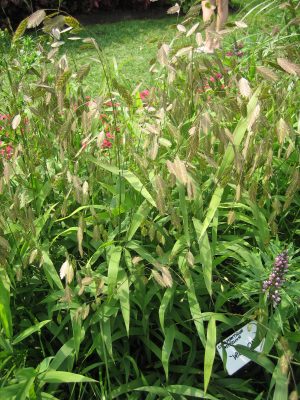
Also commonly found along roadsides, purple lovegrass (Eragrostis spectabilis) grows on sites from full sun to part shade. This is a very well-behaved grass in the Poa (bluegrass) family. It is native to eastern and central U.S. and produces those airy pink seedheads you might admire as you drive.
Northern sea oats (Chasmanthium latifolium) has very distinctive, but attractive seedheads. Native to the eastern and southern parts of the U.S., it is hardy from zone 5 to 8. Northern sea oats is a clump former with showy panicles of flowers in late summer that mature into wide, drooping seedheads. This grass likes moist but well-drained soils and is a larval plant for several species of butterflies as well as serving as a food source for several mammal and bird species.
Other native grasses worth investigating include side oats grama (Bouteloua curtipendula), big bluestem (Andropogon geradii) and prairie dropseed (Sporabolus heterolepsis). Check out both native and exotic ornamental grass offerings for their varied textures, colors, forms and flowers.
For more information on growing ornamental grasses or selection or for other gardening questions, contact the UCONN Home & Garden Education Center, toll-free, at (877) 486-6271, visit their web site at www.homegarden.cahnr.uconn.edu or contact your local Cooperative Extension Center.
I Want My Mum: A Fall Classic Through the Ages
By Abigayle Ward, UConn Department of Plant Science & Landscape Architecture Graduate Student
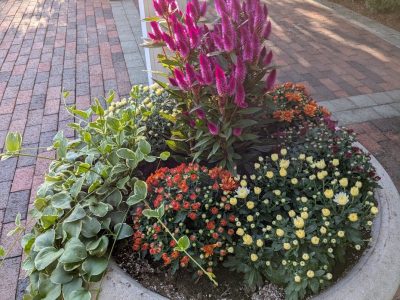
With the arrival of fall, one popular bloom brings the brilliant colors of forest foliage to our doorstep: With flower colors coming in purple, red, orange, yellow, and more, chrysanthemums, or more simply, mums, have been a favorite for centuries. First domesticated in China over 3,000 years ago, mum roots, seedlings, and flower pedals were used as herbal remedies in traditional Chinese medicine.
For nearly 2,000 years, mums have been the symbol of fall in Chinese culture: The Double Ninth Festival, celebrated on the ninth day of the ninth lunar month, celebrates harvest, ancestors, and the beauty of autumn, with mums taking center stage as both decorations, accessories, and a floral wine.
First introduced to Europeans in the 1600s, mums quickly became a fall favorite. By the mid-1800s, the Victorians had written extensive literature on the interpretation and meaning of the color of each bloom. While some colors have carried the same meaning for thousands of years – such as white blooms symbolizing mourning – others took on entirely different meanings. While in China, a red mum represents fortune and luck, a Victorian would interpret this as a declaration of love.
Luckily, it seems many home gardeners in the United States nowadays are more concerned with the aesthetic appeal of their blooms than the meanings, so major misunderstandings are avoided. With several thousand cultivars available, mums come in many color combinations and growth habits. The National Chrysanthemum Society of the USA recognizes 13 different flower classes, ranging from 6-inch diameter flower balls with many layers of florets to smaller, 2-inch diameter flowers with only a single layer of a few petals. Some mums bloom early, in August, while others will bloom in October.
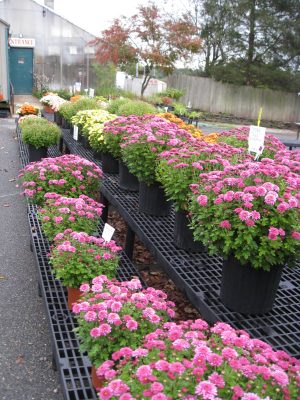
Further, some mums are annuals regardless of USDA hardiness zone, while others are perennials in zones 5-9. While so-called “florist mums” or “pot mums” are generally grown as annuals and will not survive winter frost, “garden mums” can survive winter frost if planted early enough in the growing season. If you wish to purchase a garden mum, but the mums are unmarked, a good way to tell the difference between florist and garden mums is to check for stolons near the base of the plant. Stolons, also known as “runners”, are shoots that grow out from the base of the mother plant. A daughter plant may have roots growing from the end of a stolon. If you want to purchase a perennial mum, check around the base of the stem for stolons – they will most likely be quite short but are a good sign that the plants may overwinter successfully. Alternatively, if you want to be sure you grow a permanent mum installation that comes back year-after-year, you can start some varieties of hardy garden mums from seed in late winter prior to planting out in spring. Get any mums you want to try overwintering in the ground as soon as possible. You can plant mums next year in spring or summertime to give them plenty of sunny weather to grow hearty root systems prior to the first winter frost of 2025. Mulch around your fall planted mums to help insulate their roots from frost.
Both annual and perennial mums benefit from at least 6 hours of direct sunlight per day. In Connecticut, a sunny spot to the south of your home would be ideal. Water mums thoroughly once the topsoil is dry but try not to wet the leaves or the flowers. Water left on the leaves or flowers can make mums prone to fungal diseases, which can make them unsightly or even kill them in severe cases. Towards the end of the season, especially between October and November, consider leaving the blooms on as long as possible to allow late-season pollinators to collect nectar.
Whether planted in a permanent flower garden or kept in a pot on the porch for fall, mums are an excellent addition of rich fall colors to any home gardener’s flower collection. Consider picking some up this season at your local garden center or plan on purchasing plants or seeds next year.
If you have a question on caring for your mums or for other gardening questions, contact the UCONN Home & Garden Education Center, toll-free, at (877) 486-6271, visit their web site at www.homegarden.cahnr.uconn.edu or contact your local Cooperative Extension Center.
Coax Bulbs into Bloom for Late Winter Color
By Dawn Pettinelli, UConn Home & Garden Education Center
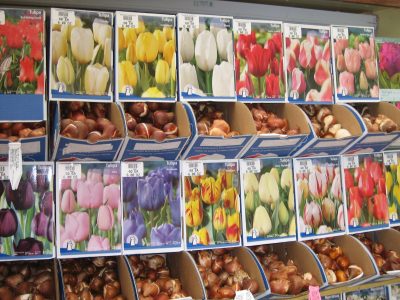
Autumn adorns us with vibrant leaves, whispering grasses, warm colorful mums, colorful cucurbits and sun-bleached cornstalks. Time spent cleaning up the gardens and yard now will be appreciated come spring. A favorite fall task is selecting and planting bulbs for spring color, accent and scent. When doing so, purchase a few extras to force into bloom.
The word, forcing, is rather harsh. I’d like to think of it more as coaxing or gentle persuasion. What we’re really doing is subjecting the potted bulbs to a shorter simulated winter so they will burst forth into bloom weeks earlier than if planted in our gardens.
Many species of bulbs can be forced. Hyacinths, tulips and daffodils are most popular. When visiting your local garden center to purchase bulbs, look for varieties that say ‘Good for Forcing’. Most hyacinths force well. Tulips and daffodils range greatly in size and bloom time. Usually the smaller, earlier, shorter varieties can be brought into early bloom most successfully.
Minor bulbs such as crocuses, snowdrops, scilla, Siberian squills, chionodoxa, netted iris and wood hyacinths are also great choices for forcing. As a general rule of thumb, these smaller bulbs need a minimum of 8 to 10 weeks of chilling versus the 12 to 14 weeks the larger bulbs may require.
Select pots with adequate drainage. Typically, 6-to-8-inch bulb pans or azalea pots are used. This type of pot is wider than deep. Look at the size of your bulbs first as one generally wants pots twice as deep as the height of the bulbs. Realistically any size pot could be used as long as it has adequate drainage.
Use a soilless, commercial potting media and moisten it with warm water so that it is damp but not saturated before potting up your bulbs. For a 6-inch bulb pan, plan on fitting in 3 hyacinths, 3 to 5 daffodils or 5 to 7 tulips, depending on the size of the bulb, or 10 to 12 minor bulbs. Yes they will be a bit crowded but it’s only temporary and they will give you a better show.
Fill the pot about halfway or so with the potting mix and set in the bulbs so that the minor bulbs will be slightly below the soil line but the larger bulbs have their noses sticking out of it. Give the pots a good watering but let them drain so no water is running out.
Then place them in a dark place with temperatures ranging from 33 to about 34 degrees F. Often a shed or unheated garage works well. Some folks may have a cold section of cellar, perhaps in the bulkhead. I find that placing them in an old aluminum trash can in the garden shed works well as mice can’t get in the can to nibble on them. Others have dug trenches in the garden in which the pots are placed and covered with leaves. Apartment dwellers could place the pots in a plastic bag in the refrigerator if room permits.
Pots should be checked every 2 to 3 weeks to see if watering is necessary and to check for root growth. Bulbs will be ready to move inside once white roots are evidenced through drainage holes and shoots begin to emerge from the bulbs. When these two growth signs are noticed, pots can be brought into bright, indirect light when the temperatures stay from 50 to 60 degrees F. It usually takes 3 to 4 weeks from when bulbs are brought inside until when they bloom.
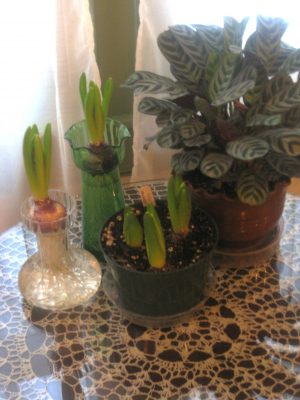
At this time, they would appreciate a light fertilizer application. A typical houseplant fertilizer at rates listed on the package would suffice. Turn the pots regularly so the plants do not lean towards the light. Once you see the flower stalks form, the bulbs can be brought into warmer temperatures where their blossoms can be enjoyed. Keep in mind that the higher the temperature, the quicker blossoms will both open and fade. If possible, keep them cool or at least move the pots into cooler areas at night.
In some cases, the bulbs fail to bloom and this may be due to storing bulbs before or after purchasing at too high a temperature, not long enough chilling temperatures, lack of adequate moisture, or bringing the forced bulbs into high temperatures too quickly. Most of the time success is achieved and enjoying the sights and scents of spring flowering bulbs inside our homes in late winter is quite a reward for not a great deal of effort.
If you have questions about forcing bulbs or any other gardening questions, feel free to contact us, toll-free, at the UConn Home & Garden Education Center at (877) 486-6271, visit our website at www.homegarden.cahnr.uconn.edu
Is Early Leaf Drop an Indicator of Tree Health?
By Nick Goltz, DPM, UConn Home & Garden Education Center, Plant Diagnostic Lab
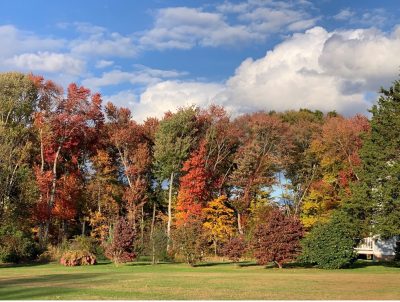
The autumnal equinox, one of two times of the year at which day and night are equal in length, just passed on Sunday the 22nd. While this point marks the astrological start of fall, many of the trees lining the roads on my drive to work (and in many of our clients’ yards) seem to want to get a head start on the season. Since late August, we’ve been getting calls from folks across Connecticut asking why the leaves on their trees are changing color and falling early. You may even be thinking, “Hey, a few of my trees are dropping their leaves early too. Is that something that can indicate how healthy they are?” In a word, maybe!
First, let me share the good news that, for most trees, premature color change and leaf drop doesn’t mean that they are in any immediate danger. Plants, much like humans and other animals, respond to stress differently depending on their environment and the kind of year they’ve been having. Just like we might see a little hair loss after a particularly stressful few months, trees may drop their leaves early as a response to stress. Identifying what is causing the stress however, is important when deciding if concern is warranted.
What type of stressors might be causing this early color change and leaf drop? For most trees, the answer is water. Connecticut and several other states in New England had a series of heavy rain events and flash flooding throughout the summer. While we’ve had hardly any rain in the land of steady habits for several weeks now, for many trees, the damage has already been done and symptoms are just appearing now. Saturated soils deprived plant roots of oxygen, damaging them and making them more susceptible to disease. Plants in especially low-lying areas, caught in floodwaters, or grown in poorly-draining clay soils likely experienced the most damage and earliest leaf drop. Some plants may have even perished outright from the damage. Besides water, excessive heat and the increased prevalence of fungal and bacterial diseases, as well as some insect pests, may have also contributed to the stress our plants are letting us know about now.
So, how can you know if the early color change or leaf drop is an issue for your favorite tree or just its way of complaining about a stressful summer? When and where the leaf change and drop is occurring can help you determine if the damage is likely a normal stress response or due to something more sinister.
Consider when the color change and leaf drop first began. In this instance, seeing some leaves begin to change in the last week of August is less concerning than seeing them change at the end of June. Plants that have their leaves change color and drop in midsummer or earlier are most likely dealing with a disease or pest issue, rather than a stress response. I recommend you get advice for these plants by contacting the UConn Home & Garden Education Center and remove them from your garden if they are unlikely to recover.
Also, consider what part(s) of the canopy was affected. Conifers such as white pine drop their leaves (we usually call them needles) in response to stress too, but you will typically see this take place on the interior of the plant – the older needles that aren’t capturing much sun anymore. Branches on deciduous trees, such as oak, that are in shady spots tend to drop their leaves early too, and this is normal.
Branches in full sun that lose their leaves very early, while others on the tree remain fine, are a bit suspicious. Mark these branches with tape or string and monitor them carefully as the plant produces its first leaves or flowers in the spring. If these marked branches do not produce leaves or flowers with the rest of the tree, get advice (again, by contacting the folks at the UConn HGEC)! The best option is usually to cut them close to the main trunk, then disinfect your pruning tools.
If you’re concerned about the health of your tree, including as a result of a potential disease or pest issue, practice good fall habits to give your trees the best foot forward next spring! Clean as much leaf litter as possible and remove it from the base of trees that dropped their leaves early. If you suspect the plant is diseased or has pests, throw away these leaves or burn them before composting. For example, many plant pathogenic fungi can survive the winter on fallen leaves and reinfect healthy plant tissue the following spring. It’s also a good idea to minimize added stress for your plants. Try not to expose them to herbicides, deicing salts, fertilizers, or other chemicals until they’re looking strong again.
If you aren’t sure how to proceed with your fall cleanup or if you’d simply like a second opinion on your favorite tree, get free horticultural consultation from the UConn Home & Garden Education Center by emailing ladybug@uconn.edu or by calling (877) 486-6271.
Time to Fertilize Your Lawn
By Dawn Pettinelli, UConn Home & Garden Education Center
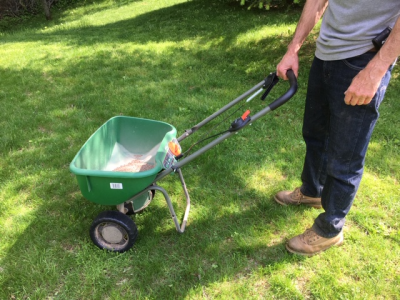
While September brings with it shorter days, we still have plenty of opportunities to attend to those fall yard and garden chores. Among them is applying fertilizer to lawns. Keep in mind that for the most part, our lawns consist of cool season grasses. In a more typical year, turfgrass growth slows down during dry, hot summer weather. Up until the past few weeks, this summer had seen enough rainfall to keep lawns green and growing.
Turf plants take up nutrients as they grow and these need to be occasionally replenished. September through mid-October is a perfect time to do so as the cooler temperatures stimulate shoot and root growth and hopefully, some gentle fall rains will help the nutrients infiltrate the soil and reach the roots.
So, what kind and how much fertilizer does one need? Of course, the best way to determine that is with a soil test (www.soiltesting.cahnr.uconn.edu) but without a soil test, follow the directions on the fertilizer package. Whether one chooses a natural/organic or a synthetic fertilizer is up to the individual. A 2024 National Lawn Fertilizer Study by Axiom, found that 95% of respondents said it was important to apply fertilizers that are safe for children, pets and the environment. Somewhat ironically, despite safety concerns, 67% have used fertilizers that contain weed killers or insecticides. In most cases, applications of any kind of pesticide, whether it be an herbicide, insecticide or fungicide are not necessary at this time of year.
Most folks who tend lawns or gardens are aware that fertilizer packages come with a guaranteed analysis. These are the 3 numbers on the package, for example 5-10-10. They are always in the same order and always stand for the percent by dry weight of total nitrogen, phosphorus and potassium. Unless you are purchasing a lawn starter fertilizer, which you would use for new seedings and soddings, you will notice that maintenance lawn fertilizers sold in Connecticut have 0 as a middle number, so for instance 18- 0- 4.
This is because of phosphorus legislation passed in 2013. Many people may not be aware that phosphorus is the number one inland freshwater pollutant in the state and when it enters streams, rivers, ponds or lakes, it encourages algae growth that eventually dies and decomposes depleting the oxygen in the water and leading to fish kills. Also, it may encourage the growth of toxic cyanobacteria as well as making the waters undesirable for recreational activities. In a nutshell, the law says that phosphorus should not be applied to an established lawn unless a soil test performed in the past 2 years provides a recommendation for phosphorus.
When applying a lawn fertilizer, either the soil test recommendations or the ones on the package call for approximately 1 pound of nitrogen to be applied for every 1000 square feet of lawn. Two things to check are the size of your lawn and also, the setting on your spreader.
Ideally one would like to apply the fertilizer when the grass is dry but before a light rain. If no rain is predicted, it would be beneficial if the lawn was watered lightly so that fertilizer prills are not sticking to the blades of grass but washed into the soil.
Lawn fertilizers generally are available as either fast or slow release. The nutrients in fast release fertilizers, especially nitrogen, are generally water soluble and readily available to your lawn grasses. Many lawn fertilizers also contain slow release or water insoluble forms of nitrogen. These are typically more expensive but supply nitrogen over longer periods of time. They are less likely to burn and more slowly fertilize plants.
Whichever one you pick; it should be put down by October 15th. Weather is unpredictable after that, and plants may or may not be able to use the nutrients before colder temperatures prevail and grass growth slows.
This time of year is great for reseeding any bare spots, topdressing with compost if organic matter levels are low, using a mulching mower to incorporate leaves as they fall and for aerating if the soil is compacted. Send your lawn questions to ladybug@uconn.edu or call the UConn Home & Garden Education Center with your queries at (877) 486-6271.
High-tech Tomatoes
By Dr. Matthew Lisy, UConn Adjunct Faculty
UConn Home & Garden Education Center
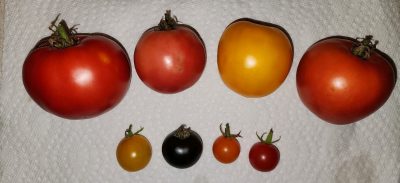
Tomatoes are one of the most popular food plants in the world, and as such, have undergone massive amounts of selective breeding. Native to western South America, the tomato can now be found all over the world. Originally grown for ornamental purposes due to fear of toxicity, modern gardeners grow many different colors including red, yellow, pink, orange, and white.
Tomatoes are prone to certain diseases which led to dependence on chemicals to control either the disease or the pest that transmits it. Disease resistant varieties of tomatoes were made by crossing certain parental tomatoes that had beneficial traits. For example, if a certain tomato tasted great but was prone to some type of wilt disease, it was crossed with a tomato that was resistant to wilt. Of course, this was VERY time consuming, and many times the final product is not perfect, but as close to ideal as possible. This does make people dependent on the seed producers, but at least you get the tomatoes you desire.
People were sad that they could never get the old heirloom varieties with superior taste to grow in the presence of modern-day diseases, so science came up with another solution – grafted tomatoes. Using young plants, the grower would take and graft the top of the desired tomato onto the roots of the undesirable but disease resistant rootstock. Certainly, these types of tomatoes have an important role in agriculture, but they are not feasible/economical in many situations.
One modern scientific solution is genetic engineering. This process takes a gene, or piece of DNA that codes for a specific trait, out of one species, and places it into another. The public generally does not like this type of technology partially due to a lack of understanding of the process, but also a fear of what could happen because of it. While science continues to make new GMOs, many companies will not use them due to consumer preference. In 1994, the “Flavr Savr” tomato became the first genetically engineered food to be granted a license for human consumption by the FDA. Although flavorful throughout its long shelf life, this tomato failed to meet commercial standards due to being easily damaged during harvest and shipping. Even though this tomato failed to become the success the company had hoped for, Calgene (now owned by Monsanto) made history.
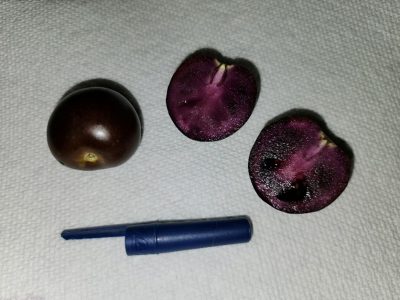
Thirty years later, the year 2024 saw another milestone in the world of GMO tomatoes. Norfolk Plant Sciences, and its seed-selling subsidiary, Norfolk Healthy Produce, produced the first tomato with completely purple skin and flesh. This is also the first time a GMO food crop has been approved for home gardeners. The color comes from the anthocyanin pigment, which is said to have heart-healthy and antioxidant benefits when consumed in the quantity found in this tomato. In addition, this pigment may increase the shelf life of the tomato. The gene for this pigment came from edible snapdragon flowers.
Many times, people fear GMOs saying that it is unnatural to have an extra “foreign” gene in an organism, and the potential risk of a “new combination of genes” created by this engineering process. The Food and Drug Administration deems this tomato as safe for human consumption as any other. In the end, each person should do their own research and make an informed decision for themselves and their family. For me, it is an exciting time to be alive as we are living through history. I felt really excited to grow the first-ever GMO tomato for home gardeners. One day, many of the tomatoes will be like this, but for right now, I will marvel at the original.
For your gardening questions, feel free to contact us, toll-free, at the UConn Home & Garden Education Center at (877) 486-6271, visit our website at www.homegarden.cahnr.uconn.edu or contact your local Cooperative Extension center.
Tips from UConn Floriculture Help Spruce Up Container Plantings
By Dawn Pettinelli, UConn Home & Garden Education Center
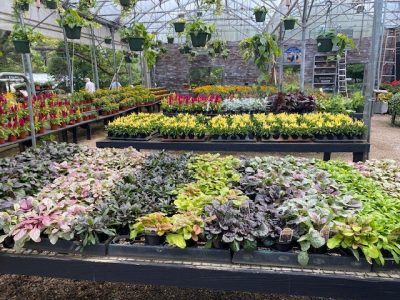
As summer wanes and the cool breezes of autumn begin to roll into Connecticut, it’s the perfect time to refresh your container plantings. Shelley Durocher-Nesta, UConn Plant Science Floriculture Grower, says this summer’s rain and high temperatures have many of our container plantings looking a little ragged but fall presents a unique opportunity to infuse your outdoor spaces with rich colors, interesting textures, and seasonal charm that lasts well into the cooler months
By the end of summer, many annuals start to fade. To maintain a lush and lively look, she suggests replacing them with plants that thrive in cooler weather. A top candidate for fall plantings, both containerized and inground are mums, obviously. They offer an explosion of color in shades of yellow, bronze, pink and reds. Asters are runner’s up, flashing their cooler shades of purples and pinks.
Ornamental cabbages and kale are leafy plants bringing texture and interest to plantings, often with their lacy ruffled edges. Hues range from deep purple to violet and from white to green, some being two-toned.
Recently, pansies and violas have been showing up as fall bloomers. These delicate flowers add a pop of color and laugh off light frosts. Pansies, with their cheerful ‘faces’ are particularly popular and come in a wide range of colors. Ornamental peppers in shades of yellow, purple red and orange are also available often in 4-inch pots
Depending on your color scheme and container size, two other great fall accompaniments are heuchera (coral bells) with their stunning foliage in a myriad of colors, and sedums that can be used either for their unique fleshy foliage or pollinator-friendly blooms.
Don’t forget ornamental grasses for their attractive seedheads and whispering foliage. If pinched for room, a few stalks of dried grasses or wheat can give your containers a rustic, harvest-time feel.
Before purchasing new plants, access the plants presently in your containers. Groom, deadhead and cut back leggy annuals like petunias and verbena. If you have summer plants that are still thriving, you can repurpose them by combining them with fall plants in the same container for a mixed-season look. However, often one finds that their summer layout doesn’t work as well with new plants. Don’t hesitate to replace staid offerings. Durocher-Nesta, agrees saying that switching out her summer planters that are getting a little tired by the end of August is a joy.
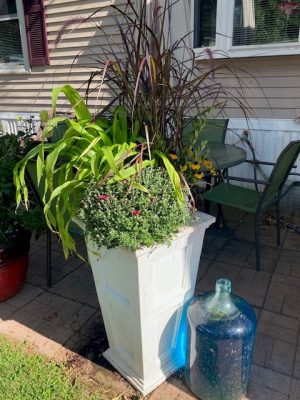
Refresh the soil in containers before planting new fall selections. Summer plants have depleted the nutrients, so replacing the top few inches with fresh potting mix can get fall plants off to a better start. If your container is large and you can’t replace all the soil, mix in some compost or at least a slow-release fertilizer, as directed on the package, to rejuvenate it,
Consider elevating some containers on stands or steps to create varying heights. Grouping containers of different sizes together on your porch or patio can also add depth and visual interest.
One of the joys of fall container gardening is the chance to play with a different color palette. While summer is about bright, vibrant colors, fall offers a more subdued, warm earthy palette. Think deep purples, burnt oranges, and rich reds, balanced with greens and whites.
As the weather cools, plants will need less water but check regularly. Container plants can dry out quickly especially on sunny fall days. Stick a finger in and add water when the top inch of potting media feels dry.
Regularly deadhead spent flowers and remove any yellowing leaves to keep your containers looking tidy and to encourage continued blooming. As frost becomes more likely, be prepared to cover sensitive plants or bring containers indoors on particularly cold nights.
In addition to the plants, fall-themed accents can enhance the seasonal appeal of your containers. Consider adding small pumpkins, gourds, or decorative squash to the mix. For a touch of whimsy, add seasonal decorations like mini scarecrows, wooden sunflowers or decorative berries.
Sprucing up your container plantings for fall in Connecticut can bring a fresh, seasonal look to your outdoor spaces. With the right plant choices, thoughtful arrangement, and a few seasonal accents, your containers can remain a focal point of beauty and interest well into the cooler months. Durocher-Nesta shares thoughts about her favorite fall flower: “Bright and fresh mums bring a smile to my face during a time of year when falling leaves and shorter days mean winter is coming. They’re one last Hoorah! for the growing season.”
If you have questions on container plantings or on any other home or garden topic, contact the UCONN Home & Garden Education Center, toll-free, at (877) 486-6271, visit their web site at www.homegarden.cahnr.uconn.edu or contact your local Cooperative Extension Center.
Fall is a Fabulous Time to Plant!
By Heather Zidack, UConn Home & Garden Education Center
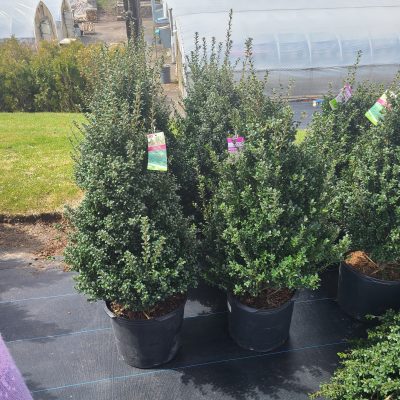
There’s no doubt that spring planting is exciting. The instant gratification that comes with putting in our new gardens and seeing flowers and greenery right away is unmatched. Late season planting is a different animal altogether. There’s a slower pace, less pressure for perfection, and a promise of beauty next season – leaving us the chance to take up other projects in the spring.
Many gardeners will start planting hardy bulbs this fall, but you can do so much more! Planting trees, shrubs, and perennials in the late summer/early fall provides enough time for plants to get established without the heat and drought stresses of summer. New plants installed in the fall have enough time to develop healthy roots and settle in before winter. Allow at least 6 weeks (about 1 and a half months) before the first hard frost to ensure strong establishment. It’s less stressful for plants, but also easier for gardeners to plant, water, and support our gardens when the weather is a bit cooler.
Your fall planted perennials, trees and shrubs will also flower “on time” next spring. Whether you've noticed it or not, flowering plants that we buy during the growing season are sometimes manipulated to bloom when you see them on the shelf. And while most plants will settle into their natural flowering cycle after their first year, planting in the fall ensures that you are starting the season with a bed that will bloom as nature intended.
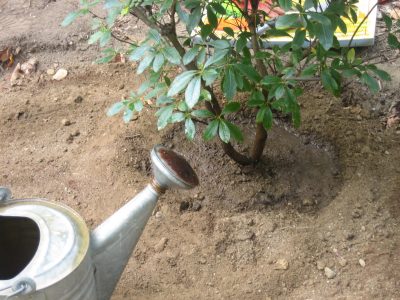
Keep a keen eye out for garden centers that may be trying to sell down their stock, so they don’t have to keep it during the winter. Plants may look a little more weathered, and past their prime. But don’t fret! If you shop smart, you can find some great plants for fantastic prices.
Shop for plants that have a nice form and strong root ball. Avoid plants that have apparent injury to trunks or branches. Old insect feeding damage, off colored leaves, or some drought damage may be recoverable. Remember that perennials will be cut back before their next flush, and deciduous shrubs will drop leaves and need pruning regardless of what they may look like right now. Never buy a plant that seems to have issues that you cannot identify, regardless of the bargain. If there are plants that you want that are unavailable, leave space for them to be planted next season.
The lower stress environmental conditions also make it a suitable time to transplant or divide plants that bloom in the spring or summer. When digging plants for transplanting, make sure to dig wide and deep to get as much of the root ball as possible. Division is a common practice with perennials and is as simple as driving a shovel through the center of the plant and digging out half of it to put somewhere else. Larger plants can be divided multiple times.
While it may seem like a promising idea to help push your plants along with some robust growth, fertilizing is not recommended in the fall. Pushing tender growth too close to chilly weather can leave the plant vulnerable to environmental damage, loss of shoots, and possibly even loss of flowers next season. Maintain them with adequate watering and supportive care. Provide good sanitation by removing and disposing of any questionable leaves that fall in your space, especially those from newly installed plants.
Planting in the fall and supporting your fall garden will help you lay a foundation for a successful spring.
If you have questions on fall gardening or on other gardening topics, feel free to contact us, toll-free, at the UConn Home & Garden Education Center at (877) 486-6271, visit our website at www.homegarden.cahnr.uconn.edu or contact your local Cooperative Extension center.
End of Season Strawberry Renovation
By Dawn Pettinelli, UConn Home & Garden Education Center

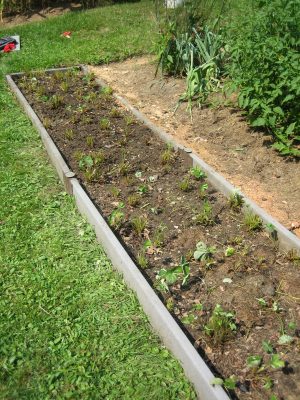
So, you decided to grow some strawberries this year. You carefully prepared the bed and have enjoyed your first crop. Now you are wondering what to do to keep your strawberry bed healthy and productive. In part, the care after harvest depends on whether you are growing June bearing or day neutral (everbearing) varieties and what kind of row systems you have them planted in.
June bearing strawberries are most commonly grown in what is known as the matted row system. Mother plants are set 18 to 24 inches apart in 3 to 4 1/2 foot rows and runners are allowed to root anywhere within the row. This system is usually the easiest to maintain. Typically, at the end of the third growing season both plant quality and fruit quantity start to decrease and the whole bed is dug up and replanted with new disease-free strawberry plants. Try to incorporate this into your garden rotation plan to reduce disease problems.
June bearers can also be grown in single rows composed of different aged plants with the original plants set about a foot apart. A second row is started with first year runners and set 18 inches from the initial planting. Use only the first or second daughter plants produced along the runners because they are the most vigorous and productive. The rest are usually discarded.
The next year a third row is made again using the first one or two daughter plants and once more surplus runners and plants are removed. After the original mother plants have produced fruit for about 3 years, they are generally replaced with new, disease-free stock and the cycle continues. This way one always has a row or two of strawberries in production. Ideally the row with the new strawberry plants should be located on a section of the garden where strawberries haven’t been grown for 3 to 5 years. This isn’t always possible in small yards, which is why it is important to purchase certified virus free stock.
After year two when June bearing strawberries have finished producing their crop, it is time to renovate. According to Evan Lentz, UConn Fruit Specialist and Assistant Extension Educator, renovating your June-bearing strawberries is one of the best ways to maximize your annual production, reduce disease instance, and maintain an orderly planting. Proper renovation ensures that you set yourself up for success in the following year and allows you to extend the life and productivity of this semi-perennial crop. This is doubly important for individuals producing fruit in an organic or no-spray system.
This can be done sometime in July through August. Lentz suggests starting by either mowing or clipping with hand trimmers all the foliage about 2 inches or so above the crowns. Next, go through the bed removing all weeds, and weak and extra strawberry plants and dead or dying leaves. Thin to space plants at least 10 to 12 inches apart and cultivate around these remaining plants.
Now is the time to fertilize your strawberries whether beds are renovated or not. Lentz recommends working in about 3 to 4 pounds of 10-10-10 or its organic equivalent per 100 square feet. Lightly scratch the fertilizer into the soil. Brush or rinse any fertilizer off leaves at the salts will injure them.
Day neutrals, such as ‘Tristar’, ‘Seascape’ and ‘Mara des Bois’ produce a fairly decent size crop in June and continue forming occasional berries until frost. Unlike June bearers which develop fruit buds in late summer and early fall, the ever bearers have the ability to form fruit buds throughout the summer. An advantage to growing day neutrals is you will still get strawberries even if a late spring frost kills their initial fruit buds.
In general, day neutrals are grown for 2 or 3 years and then a new batch of strawberries is planted. The day neutrals produce far fewer runners than the June bearers. The new daughter plants should all be removed although they can be transplanted into another area if desired. Plants are usually set one foot apart in single rows about 18 inches wide.
According to Lentz, all strawberries require at least an inch of water per week for vigorous growth. If dry weather sets in, plan on irrigating plants, especially those just renovated. Use a mulch of pine needles, straw or wood shavings to conserve moisture, keep weeds down and berries off the soil. Since strawberries are shallow rooted, it is important to keep weeds under control.
It does take a little time to maintain a strawberry bed but the luxury of picking your own berries for strawberry shortcake, jam or fresh eating makes it all worthwhile. If you have questions about growing strawberries or on any other home or garden topic, contact the UCONN Home & Garden Education Center, toll-free, at (877) 486-6271, visit their web site at www.homegarden.cahnr.uconn.edu or contact your local Cooperative Extension Center.
Spectacular Sedums: Your New Favorite Groundcover
By Abigayle Ward, UConn Dept. of Plant Science & LA Graduate Student
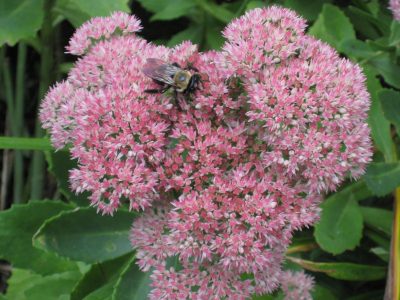
With varieties native to North America, tolerance to frigid temperatures down to minus 40 degrees F, and nearly 500 species described, sedums subvert all expectations of a succulent. Also known as stonecrop, sedums have been a garden favorite since the 17th century, and it’s easy to see why. Their visual interest and tolerance of harsh growing conditions make them well-suited as groundcover for the landscaper with an artistic eye.
You can purchase either tall or creeping varieties of sedums. Also known as ‘clumping’ varieties, tall sedum varieties can grow up to 3 feet tall although many will only grow to 1 foot tall or less. Tall, top-heavy varieties can be prone to falling or flopping over especially if overfertilized or if they receive too much water. They are well-behaved perennials that are clump formers, and thus can be useful as focal points in garden beds. Alternatively, creeping varieties of sedums grow from 2 to about 6 inches tall. These creeping varieties will spread a few feet in every direction but do so very slowly. If you wish to fill your bed with sedums, you can stick vegetative cuttings throughout the area you want them to grow. Keep moderately moist until well rooted. Once they root, they will usually fill out your bed fairly rapidly.
With such a large variety of leaf shapes and sizes, interesting bed textures can also be created with sedums. Some varieties have large, broad, spoon-shaped leaves while others have many short, pointed leaves surrounding the main stem. You may wish to combine different textures together into one bed to make a wild, visually striking design, or try taking advantage of certain textures for specific locations in the bed. For example, you could choose short creeping varieties with small leaves for bed edges, and select slightly taller creeping varieties with larger, broader leaves to build up to the bed’s focal point.
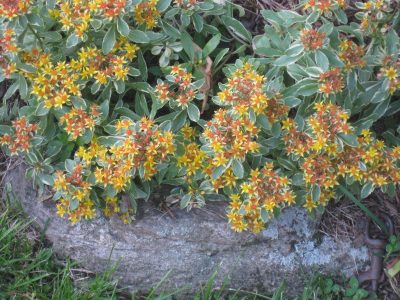
Sedums come in a smattering of delightful color combinations from electric green to deep purple, red to teal; there’s a color of sedum for any design. Many keep their color year-round, and produce delightful bunches of tiny, colorful flowers between summer and fall, depending on the species or cultivar. The magenta, yellow, and lilac-colored petals attract pollinators in great numbers, especially between August and September here in Connecticut. The flowers persist until wintertime, when they dry out and turn brown as the plant goes dormant. While you may choose to remove the flowers before the winter snowfall, you can also leave them on the plant to add some color contrast in your garden as the brown stalks are surrounded with snow. Additionally, leaving the dried flowers on the plants may help creeping varieties spread, as the tiny seeds fall to the ground and germinate come springtime.
While generally very tolerant of adverse growth conditions, sedums do best in sunny spots with well-drained soil. Luckily for those of us in Connecticut, many of our soils are well-drained. Sedums require little nutrients to thrive and typically are happy with just a spring application of an all-purpose garden fertilizer. Since sedums go dormant in the winter, no fertilizer should be applied later in the year. While other groundcover plants may need water in a drought, sedums, like most succulents, can go extended periods of time without supplemental irrigation. To top it off, their foliage is bitter, and thus unlikely to be damaged by grazing wildlife. The limited maintenance requirements of sedums make them attractive candidates for both lawn alternatives and green roofs alike.
While resistant to consumption by mammalian wildlife, the juicy sedum leaves are sometimes appealing to hungry aphids and thrips. To manage aphids and other sap-sucking insects, you can simply spray sedums with water to knock off the pests – just be mindful of overwatering, as the sedums may rot. Alternatively, you can try attracting ladybugs and other aphid predators to your sedums by planting marigolds, dill and other predator attracting plants nearby. The ladybugs will partake in the pollen and snack on the sapsuckers. Avoid spraying insecticides, as they will kill both pests and beneficial insects, including pollinators. Leaving leaf litter in your garden over the winter gives a place for ladybugs to hibernate. Come spring, newly hatched ladybug larvae will be on the hunt for a meal, ready to vigilantly defend your sedums from attacking aphids.
Your next groundcover selection can be both visually appealing and low maintenance. If you’re looking to update your groundcover, consider picking up some sedums at your local garden center in the spring or summer.
If you have questions on growing sedums or on other gardening topics, feel free to contact us, toll-free, at the UConn Home & Garden Education Center at (877) 486-6271, visit our website at www.homegarden.cahnr.uconn.edu or contact your local Cooperative Extension center.
Flock to Phlox
By Dawn Pettinelli, UConn Home & Garden Education Center
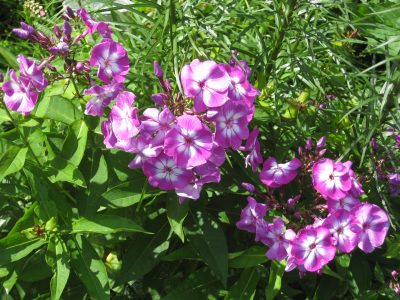
About now, many of our perennial gardens are looking a bit lackluster. Early summer bloomers have fizzled out and autumn charmers like asters and mums have yet to pop. Garden phlox (P. paniculata) to the rescue!
Annual and perennial phlox comprised about 70 different species, many of which are native to North America. Their habitats range from woodlands to meadow and their growth habits from low and mounded to tall and upright. All have clusters of tubular flowers that are exceptionally attractive to hummingbirds and hummingbird moths along with bees and butterflies.
There are an outstanding number of garden worthy cultivars. My favorite is ‘David’, a white, powdery mildew resistant variety that grows to about 4 feet with loads of slightly fragrant blooms. I have it planted in my white garden and this sturdy, upright plant has come back year after year with virtually no problems.
UConn Plant Science & Landscape Architecture professor, Dr. Jessica Lubell-Brand noted phlox ‘Jeana’, the 2024 Perennial Plant Association’s Perennial Plant of the Year, is treasured for its long blooming period as well as its butterfly luring abilities. Plants can reach up to 5 feet in height and its more loose and wild appearance works well in cottage gardens featuring attractive pink flowers and decent powdery mildew resistance.
Sometimes shorter varieties are a better fit and if that is the case, for your beds look to ‘Coral Crème Drop’, which according to Dr. Lubell are part of the Candy Store series. She raves about their vibrant coral blossoms with their August feel. Another top garden candidate in her book is ‘Glamour Girl’, also with hot coral blooms as well as good resistance to powdery mildew.
A number of garden phlox sport distinctive eyes. ‘Bright Eyes’, as the name implies is a delicate pale pink with a bright crimson eye while ‘Laura’ is a mildew resistant, royal purple variety with a white eye. Both grow to about 3 feet in height.
Many gardeners find these phlox indispensable for August into September color in the perennial garden. They are tough, colorful, vigorous plants that are hardy and relatively long-lived. They make excellent background plants for narrow borders and can bridge the gap between varied sized perennial plantings. Garden phlox come in a wide range of hot and cool colors ranging from white and light pinks, to purples, reds, oranges and magenta.
For healthy, vigorous plants, they should be grown in full sun to part shade. Phlox enjoy a moderately fertile soil with a pH in the 6s. While established plants are fairly drought tolerant, larger and more numerous flower heads are produced when adequate moisture is supplied. They grow at a moderate rate so division every 3 to 4 years is usually sufficient.
Both to encourage sizable blooms as well as to reduce the incidence of phlox’s number one nemesis, powdery mildew, Dr. Lubell recommends reducing the number of stalks early in the growing season to 6 to 8 per plant. This provides better air circulation to plants.
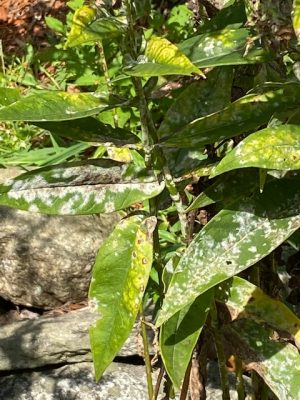
Powdery mildew is a fungus disease that is more widespread during humid, wet summers. It typically does not kill plants, but they look awful with their leaves covered with what looks like white powder. Two options for dealing with this disease according to Dr. Lubell, are to select resistant phlox cultivars or to pre-emptively spray with a least toxic substance like potassium bicarbonate or your fungicide of choice. As stems die or get killed by frost, be sure to remove them from the garden and put in the trash, not the compost pile.
Insects are not usually a problem but during dry, hot summers, spider mites may attack plants. Usually, a strong blast from the hose will knock them off. This may need to be repeated several times if dry weather persists.
A key gardening practice when growing phlox is dead-heading, or removal of spent flower heads. Garden phlox produce a lot of seeds and if left to fall to the ground and germinate, vigorous plants will most likely produce blooms in that undesirable, muted magenta color. Often these seedlings crowd out the more desirable cultivars that were intentionally purchased.
Not only are garden phlox cultivars pretty spectacular on their own but Dr. Lubell says they pair nicely with a variety of other perennials including lilies, yarrow, ballon flower, daylilies, bee balm as well as numerous annuals.
If you have questions on garden phlox or on any other gardening questions, feel free to contact us, toll-free, at the UConn Home & Garden Education Center at (877) 486-6271, visit our website at www.homegarden.cahnr.uconn.edu
Current Landscape and Garden Conundrums
By Pamm Cooper, UConn Home & Garden Education Center
Here at the UConn Home & Garden Education Center we have been getting questions about three pests that have been particularly widespread in the state. Whether in the landscape or the garden, there is always something going on, good or bad, and keeping up with pests or perceived pests can be challenging. The following reflect the most common inquiries we have had over the past few weeks.
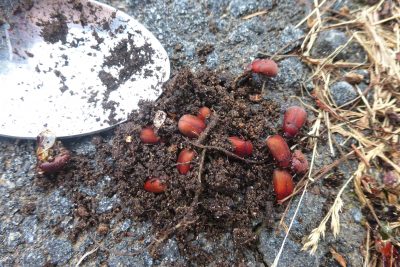
Asiatic garden beetles have been a real problem for many gardeners this year. An imported pest, these small, rusty brown, night-feeding pests can devastate plants overnight then disappear during the day. Leaving you to wonder what is eating your plants. Favorite plants include dahlias, basil, zinnias, sunflowers, peppers, eggplants and goldenrods. They will feed on over 100 herbaceous and woody plants. In the evening a plant can look great, and the next day it can be a skeleton of stems and leaf veins.
Check damaged plants at night with a flashlight; if they are active, you should find them. During the day, dig an inch or so into the mulch and soil under damaged plants. These beetles will hide there during the day. Some people have reported finding as many as 300 in a night, then 50 each night, until they find few or none. New beetles will fly in daily, so be vigilant. Feeding by adults should end by the end of August. Crush them or put them in a container of soapy water until they succumb. Foliage can also be treated with an appropriate insect control product that will kill them after they feed on the leaves, Read and follow label instructions carefully for any control products if they are needed.
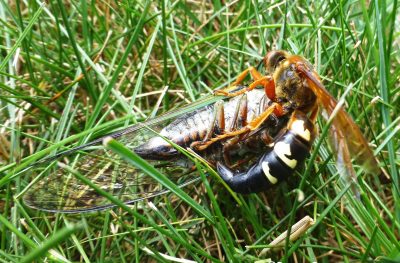
Cicada killers are rather mild-mannered (like Clark Kent) burrowing wasps that can cause alarm when they appear in the summer months. These wasps are very large, and females have the potential to sting, but have no aggressive nest-guarding instincts as do most other wasps or bees. What they have is size, and so become easily feared, especially when they burrow along sidewalks or other sandy areas close to pool, gardens and houses.
Female cicada killers burrow a rather rectangular tunnel deep into soft soils into which they will eventually drag a cicada they have paralyzed. They lay one egg on the victim and the larva will feed on the carcass and pupate over the winter. They may be a chronic problem in areas of sandy soils and can be discouraged by disrupting tunneling activity by drenching areas where they are actively tunneling with water. They do not like moist soils, so this may be the only control method needed. Digging may disrupt root systems of plants if the tunnels are made at the base of plants, and watering the plants affected in this way may settle the soil back around the roots. Use of any pesticide would only be effective if wasps are still going in and out of tunnels and should be used only if necessary.
The final pest we will cover are aphids. These piercing-sucking feeding type insects are small, but they can occur, seemingly overnight, in large numbers on plants. Aphids prefer newer growth like upper stems but are not so fussy later in the year when they feed on flower buds, old and new leaves and flower stems. Later in the summer some species may cover older stems right down to the ground. This is especially a problem on common and swamp milkweeds. Aphid feeding can cause wilting of plant parts above where heavy feeding occurs. Leaves can be mottled, then become distorted before turning brown.
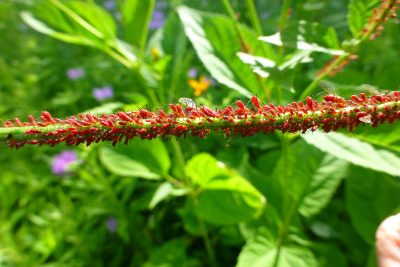
Control of aphids relies on paying attention every day. Aphid females can give birth to live young during the summer, often fifty or more new aphids appear from each female per day. This is why control seems effective, then before you can say “my plants look really good now”, there are scads of aphids back where they were before. Aphids in high numbers, especially on sturdy stems, can be crushed by hand, sprayed with a suffocating type product like insecticidal soap, or knocked off by a strong jet of water. Keep in mind that the reproductive females have wings, and they will take flight at the first sign of trouble. That is why they can persist on plants.
If aphids are a serious issue on plants, with no control measures apparently working, consider removing the affected plants and adding plants you know they so far have shunned as a food source. It may be a painful but necessary step.
Be alert to what is happening in your own backyard, for it is certain something, good or bad, is going on. The sooner you discover the bad, the better. Know that: “On every stem, on every leaf, and at the root of everything that grew, was a professional specialist in the shape of grub, caterpillar, aphis, or other expert, whose business it was to devour that particular part. “~Oliver Wendell Holmes
For questions about garden pests or any other gardening questions, feel free to contact us, toll-free, at the UConn Home & Garden Education Center at (877) 486-6271, visit our website at www.homegarden.cahnr.uconn.edu
What’s Eating My Brassicas?
By Dawn Pettinelli, UConn Home & Garden Education Center
Broccoli, cabbage, kale and other members of the brassica family are tasty and so good for you but its not just us who find them delectable. Brassicas have a number of insect pests but probably several caterpillar species do the most damage.
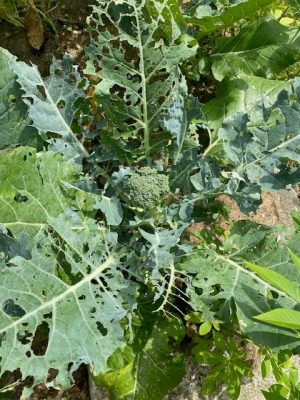
When checking plants, look for holes in the leaves. A few irregular holes may soon become a skeletonized leaf with only the midrib left if control measures are not taken. These caterpillars can quickly devour plants.
Two of the most common pests are the imported cabbageworm and the cross striped cabbage worm. According to Dr. Shuresh Ghimire, UConn Vegetable Extension Specialist, imported cabbageworm is the offspring of the cabbage butterfly, a butterfly with white wings with 1-2 round black spots on the forewing. Eggs, laid singly on leaves, are light green or yellow and slightly elongated. Three to 5 days later, the eggs hatch. The lime green velvety caterpillars feed for 2 to 3 weeks.
Dr. Ghimire noted that imported cabbage worm feeding and resting mostly occur on the underside of leaves. Be sure to check both the tops and bottoms of leaves. Damage includes round or ragged feeding holes and deposits of wet, green or brownish frass. There can be 4 to 5 generations each year. This pest overwinters as a pupae close to host plants.
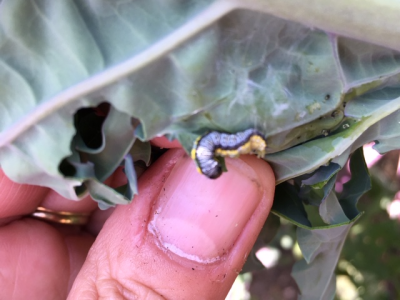
The cross-striped cabbageworm used to be a southern pest but no longer. The adult moths fly at night so are seldom seen. Cross-striped cabbageworms are most abundant on late-season plantings says Dr. Ghimire. Unlike the other major caterpillar pests, such as cabbageworm and diamondback moth, the cross-striped cabbageworm lays its eggs in batches (3-25) rather than singly, so caterpillars emerge in clusters. Egg batches are yellow, flattened, overlapping like fish scales, and attached to the lower leaf surfaces.
The distinctive-looking caterpillars are bluish gray on top with green on their undersides, a yellow stripe on each side with a row of numerous black bands across the back. Clusters of these caterpillars are voracious feeders and plants infested with cross-striped cabbageworm larvae are often completely skeletonized, while adjacent plants may be left undamaged. There are 2 or 3 generations per year.
Two other caterpillar pests of brassicas are the diamondback moth and the cabbage looper. Eggs of these two pests are laid singly and most years they do not cause considerable damage to home vegetable gardens.
There are several strategies to control these caterpillars on broccoli plants. If you have just a few plants, check them every few days looking at both sides of the leaves and either squish any caterpillars you find or drop them into a can of soapy water.

Rotating your plantings and interplanting with flowers may confuse pests. Dr. Ghimire suggests planting flowers to attract natural enemies, like Braconid wasps, which lay eggs on soft-bodied caterpillars such as cabbage worms. The larvae feed inside the live caterpillars, weakening or killing them. Some plants known to attract pest predators include dill, parsley, hyssop and mints.
Since brassicas do not need to be pollinated, they can be covered with netting or row covers to exclude insect pests. The holes in the netting should be one-quarter inch. Hoops can be used to hold up the barrier or one can make wooden or PVC cages for a custom fit. Be sure to tuck or pin the edges to the soil so pests can’t crawl under.
Finally, if the caterpillar infestation becomes too extensive, Dr. Ghimire recommends Bacillus thuringiensis (Bt), which is a biological control for Lepidoptera species of moths and butterflies. Bt is a bacterium that when sprayed on your plants and consumed by the caterpillar enters the insect’s gut and causes it to die. While it is effective for controlling these pests, it is harmless to humans and other animal species. Limit its use to brassicas to prevent it from affecting desirable caterpillars.
As with all garden pests, the key to healthy plants is regular monitoring and putting control measures into practice when pests are first noticed. For questions on brassica pests or any other gardening questions, feel free to contact us, toll-free, at the UConn Home & Garden Education Center at (877) 486-6271, visit our website at www.homegarden.cahnr.uconn.edu
Coleus: A Victorian Dream
By Abigayle Ward, UConn Dept. of Plant Science & LA Graduate Student

Seen anywhere from great-grandma’s ornamental garden to your neighbor’s hanging basket, coleus are the colorful, velvet-textured leafy cousins of oregano and deadnettle. Native to tropical regions of Africa, Asia, and Oceania, it is thought that Dutch botanists introduced the fascinating foliage to Victorian England in the mid 1800s. Coleus were readily welcomed into homes as parlor plants and into ornamental gardens. They were especially coveted in so-called “carpet bedding” gardens, where bedding plants of equal height are used to create colorful designs such that they appear like “carpets” when viewed from above. Other than coleus, the Victorians enjoyed using colorful flowers such as petunias, asters, and zinnias as carpet bedding. Carpet bedding is still popular today; we have at least one such garden featuring coleus and petunias on display at the University of Connecticut Storrs campus. To design a carpet bedding garden, try combining simple shapes and lines to make symmetric, harmonious patterns. Use green vegetation, such as sedums, or even a green cultivar of coleus, to contrast with the bright colors of flowers and the mulch or soil below.
For those of us lacking yard space comparable to an English country house, a large carpet bed garden might be impractical. Instead, coleus can be planted alongside other flowers for a splash of color in a flower bed against a house or fence. Coleus are the perfect complement to the colorful clapboard siding characteristic of houses in New England – draw attention to the colors of both by putting reds with greens and yellows with purples. If coleus are planted directly into the ground, slugs are one major pest to look out for. In particularly wet summers, such as those in recent years, slug populations can devour entire coleus plants.
To avoid slugs, container gardens may be a wise option. Sitting above the ground and out of field soil, slugs will have more difficulty reaching the tasty, tender leaves. For those with outdoor space around their apartments, container gardens are also generally a renter-friendly option. Coleus grow well in window boxes and other small containers, and they can help add a warm, friendly atmosphere to the entrance of any home. Most cultivars of coleus available on the market today are tolerant of both shaded and sunny conditions, and thus are well-suited to either covered or open porches. In containers, the main pests to look for are thrips, mealybugs, and aphids. These three pests can cause discoloration in leaves, such as silvery/gold, yellow, or black spots. Outside where predators of these pests thrive, infestations should not progress to the point of killing entire plants, but affected foliage may be unsightly. While systemic insecticides may help keep these types of pests off coleus, they also can kill bees. Avoid applying systemic insecticides to coleus outdoors whenever possible. Try moderately forceful sprays with water instead, insecticidal soap or other least toxic controls.
The Victorians also kept coleus as houseplants, and so can you. In plant hardiness zones 6a-7b in Connecticut, coleus are very tender annuals. They will grow prolifically when temperatures are above 60°F, and will experience cold injury if temperatures fall below 50°F. When temperatures plunge below 40-50°F and overnight frost becomes a possibility, leaves will start to blacken and die. At the end of the growing season before the first frost, consider planting stem cuttings in pots and bringing them indoors for colorful, year-round foliage. Coleus as houseplants will do best in north-facing or east-facing windows. Avoid placing them in windows where they experience too much direct sunlight for too long during the day. If windows are unavailable, coleus also grow decently under grow lights.
No matter where they are grown, the main attraction of coleus is its brilliant foliage. Plants grown in containers may benefit from occasional nitrogen additions to keep them growing all season long. Like others in the mint family, coleus grow flower spikes when stressed or when the plant is near the end of its life cycle. While the flowers on the spikes are not very attractive from an aesthetic standpoint, bees, hummingbirds, and other pollinators flock to them. While the spikes can be pruned off if they appear too early in the growing season to encourage further vegetative growth, consider leaving the late-season spikes on, so that bees can collect nectar to sustain their hives over the winter.
While the selection of coleus cultivars were limited in Victorian England, decades of horticultural breeding efforts have given us access to over 1,000 varieties today, including sun-tolerant cultivars, with endless colors, leaf shapes, sizes, and growth habits. Consider adding this versatile Victorian dream to your home garden for splashes of colorful summer foliage.
If you have questions on coleus or on other gardening topics, feel free to contact us, toll-free, at the UConn Home & Garden Education Center at (877) 486-6271, visit our website at www.homegarden.cahnr.uconn.edu or contact your local Cooperative Extension center.
Great Hostabilities
By Dawn Pettinelli, UConn Home & Garden Education Center

So versatile and ubiquitous are hostas that I have yet to visit a garden that doesn’t have at least one whether left by a previous gardener or selected by the present one. Hostas certainly are workhorses of the garden renowned for their shade tolerance, hardiness and longevity. Plus, few plants have such large variations in size, leaf color and texture. According to the American Hosta Society, there are more than 3000 varieties of hostas covering 45 species including stalwarts of our gardens such as Hosta sieboldiana, H. elegans and H. montana. Now the hostas you purchase are likely complex crosses of multiple species.
Hostas are native to Asia and came to the United States through Europe during the 1800s. Many of us older gardeners referred to them as plantain lilies because their broad leaves resemble a common weed (or herb depending on one’s perspective), plantain. The young leaves are reputedly edible. In fact, the Japanese are said to serve them raw, boiled or fried in tempura. Their palatability probably explains why gardeners around here half-jokingly refer to them as ‘deer candy’.
Hostas are divided by size into 5 groups. Minis are less than 6 inches tall, small range from 7 to 10 inches, medium from 11 to 18, large from 19 to 28, and giants are greater than 28 inches. ‘Gentle Giant’ and ‘Empress Wu’ are close to 4 feet tall with a spread of over 5 feet, if you’re looking for a plant to make a voluminous impression. Keep in mind a plant’s full size when incorporating them into your planting beds.
A notable feature of many hosta cultivars is leaf variegation. On marginally variegated plants the edges of the leaves are light in color, maybe cream or yellow. Medio variegated types have light colored centers with darker edges. There are also 5 groupings for color: green, blue and gold, plus the 2 types of variegation. The gold and variegated cultivars do best in part sun to dappled shade. Placed in a heavily shaded area, they can lose some of their color as only the green parts of the leaves photosynthesize.
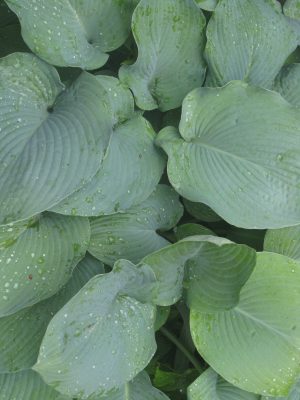
Leaf shapes range from thin and smooth to ridged and heart shaped. Sizes range from 2 inches on ‘Mouse Ears’ to over a foot and a half on giant hostas.
While grown mainly for their attractive foliage, hostas do bloom once a year. Most have delicate-looking, tubular flowers in various shades of purple that are attractive to hummingbirds and bees. Fragrant white ‘Royal Standard’ grace part of a patio in my white garden. Their heady scent is especially pronounced on warm summer evenings. ‘Royal Wedding’ is another fragrant, white-flowering variety. Cut down the flower stalks once flowering is finished.
Growing hostas is a breeze. These tough, dependable plants put on their best show when not located in full sun as the large leaves can scorch during periods of hot, sunny weather. That being said, there are some cultivars like ‘Guacamole’ and ‘Paradigm’ which can tolerate full sun with adequate moisture.
An ideal location would be a semi- to fully shaded site in a soil with a pH in the mid 6s and moderate fertility. Hostas are often planted under trees as once established they can tolerate dry shade to some extent. Remember that a tree’s roots will be competing with the hostas and your plants would benefit from extra water and fertilizer.
The two major pests of hostas are slugs and deer. Ragged holes and tears on leaves are a sign of slugs. These soft-bodied creatures feed at night or on cloudy days but slime trails on the leaves or ground may be visible in the morning. Controls include hand-picking, beer traps, diatomaceous earth and slug baits.
Deer can make short work of a bed of hostas. Three strategies are to use repellents, fence them out or plant your hostas amid less appetizing plants. Some have reported less deer damage to blue leaved hostas, maybe because they have a waxy coating. If you’re growing hostas in deer country, you’ll have to figure out what works best for you.
At the end of the season, frost will flatten the leaves of your hostas. Cut them back and remove the foliage from your garden to give both slugs and diseases less places to overwinter. Plants typically need division every few years if they are outgrowing their allotted spaces. Dig up and divide in the spring when the new stems start to poke through the soil but before the leaves unfurl.
If you have questions about growing hostas or any other gardening questions, feel free to contact us, toll-free, at the UConn Home & Garden Education Center at (877) 486-6271, visit our website at www.homegarden.cahnr.uconn.edu
Calling the Cut – Tree Triage, Care, and Removal
By Nick Goltz, DPM, UConn Plant Diagnostic Lab/UConn Home & Garden Education Center
The forecast is looking good for a perfect 4th of July weekend. Most folks will take advantage of the weather ahead to plan that perfect grilling menu for when their friends and family visit. This is a much-needed respite from the severe weather that passed through over the past few weeks. Severe winds and torrential rains hammered Connecticut and most of the rest of the Northeast after a recent heat wave. With the weather for the week ahead of us is looking much better than the weather of the week behind us, now is the perfect time to assess our trees and determine if any action needs to be taken before the next storm comes!

I’ll start and end this column with the advice that a professional arborist should be called-in if you are ever unsure of your tree’s health, or if you need support regarding safe management and potential removal. In Connecticut, one of the best resources for finding a licensed, local arborist as well as additional resources regarding tree care and maintenance can be found on the Connecticut Tree Protective Association website, ctpa.org. That said, tree triage can start with you at home. There are many things one can be on the lookout for to determine if a tree need professional attention, and potentially in what order the work should be done.
I’m sure you’ve heard this phrase used to describe real estate, but with trees too, location is everything. The first thing to consider when performing your tree triage is the location of the tree. Regardless of tree age, size, species, or health, the trees that should always merit our immediate attention are those in locations where they could pose a danger to life or property if a limb were to fall off or if the tree were to topple altogether. Trees within striking distance of homes, power lines, and important structures like chicken coops and pet houses should always be the first inspected before the storm comes and after it passes. If a tree knocks down a power line or hits a home, call for help. Never attempt to work around a live cable (one that still carries electricity) without the proper training and equipment.
The second thing to consider as you perform your tree triage is health of the tree. Trees weakened by disease or age are more likely to succumb to strong winds or topple after standing water weakens or kills roots. Inspect your trees for symptoms of stress and disease such as branches that no longer produce leaves. Depending on the species of tree, a few may not be much cause for concern, but if there are several branches on a tree that no longer produce new leaves or needles, the tree is likely not in great health. Another symptom of stress or disease is a visible canker, or large wound, on the trunk of the tree. Trees in good health will typically grow new tissue over an injury sustained by pruning, animal feeding, or a previous storm. Cankers that appear to be getting larger over a few years, rather than smaller, are often a cause for concern.
There are even some obvious signs of disease such as conk or shelf mushrooms that grow directly from the wood of the tree. While these organisms are important for nutrient cycling in natural ecosystems, they often indicate that a tree is approaching the end of its life. The shelf mushroom is only the sexual structure of the fungus, there to produce spores and reach new trees. While removing the mushroom may slow the spread of the fungus to other trees nearby, the majority of the “body” of the fungus will still exist within the tree, weakening it by breaking down woody tissue over time.
Trees, like other living things, do not live indefinitely and become more vulnerable to illness and stress as they age. Just like people need to take care of themselves to ensure they live a long, healthy life, so too must trees be cared for over the course of their lives to ensure they have the best possible outcome. Regular fertilization and pruning are essential to not only ensure that a tree grows robustly, but also that it does not become lopsided or heavy on one side as it ages. Even healthy trees can fall if they are never pruned and have a poor center of gravity! Pruning should be performed frequently to promote new growth, discourage lopsidedness, and allow increased airflow through the canopy. This will have the double benefit of decreasing disease pressure that often accompanies high canopy humidity and prolonged leaf wetness. Though it depends on the species of tree, most here in New England perform best when pruned while they are dormant in winter. Remember to not remove more than 1/3 of the tree’s branches when pruning, if possible!
There are other factors to consider when determining if a tree should come down that we don’t have space to discuss at length here, such as the species of tree, whether the tree is used for other purposes (such as part of a living fence), whether the tree has historic or personal significance, or what removal of the tree may mean for other plants nearby that depend on its shade. And, of course, nobody should consider tree removal without considering cost and time. If cost is a concern, remember to do your triage and prioritize the management of trees that could potentially damage your home, property, or power lines if they were to fall. These considerations and others are worth discussing with an arborist as they survey your property!
For questions about planting and pruning trees or other gardening topics, feel free to contact us, toll-free, at the UConn Home & Garden Education Center at (877) 486-6271, visit our website at www.homegarden.cahnr.uconn.edu or contact your local Cooperative Extension Center.
Remove Those Suckers!
By Dawn Pettinelli, UConn Home & Garden Education Center
About now the gardens should be planted, and it is time to turn our attention to the trees and shrubs on the property. New growth is almost fully expanded and pruning of spring flowering shrubs can commence. When out there with your pruners, keep an eye peeled for suckers and water sprouts, both on the plants you’re pruning and other woody plants in the yard.
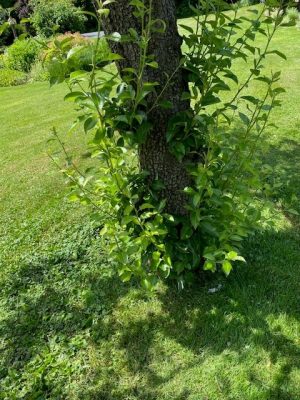
Many trees and shrubs produce vigorous, upright stems that can reach several feet high over the growing season if left unchecked. Those arising from the root system are known as suckers while those growths arising from the crown portion of a tree or large shrub are referred to as water sprouts. At the very least, they are unattractive and take away from the architectural framework of a plant. More importantly they use water, nutrients and energy that could be put to better use if not taken from the rest of the plant. If not removed, they can crowd out the main plant resulting in reduced vigor.
Some woody plants naturally tend to produce suckers and sometimes these young vigorous shoots are needed to rejuvenate older plants as aging stems are removed. An example would be shrubs like red-twigged dogwoods or lilacs. Suckers arising from trees such as apples, crabapples, honey locust, lindens and others, however, should be removed.
In the case of grafted plants, like hybrid tea roses or apples, the desired variety is grafted on to a rootstock that might be more cold hardy, have dwarfing genes or other desired features. Occasionally the rootstock revolts, so to speak, and sends up its own shoots. In the case of roses, one might notice a stem with red flowers when the plant was purchased as a named cultivar with different colored flowers.
Suckers and water sprouts often occur because plants are in some way stressed or due to damage to their root system. Plants can be under stress for a number of reasons. Some common reasons would be insect or disease problems, drought, too high of a water table, compacted soil and/or difficult growing conditions.
Planting too deep will also stress a plant and could cause suckers to develop. Whenever planting woody plants sink them so that the level of soil in the pot they are grown in is level with the soil they are planted in.
Another reason for suckers or water sprouts is that plants are pruned incorrectly or too drastically. Seldom is it advisable to remove more than one-third of the plant at one time. Also, avoid topping ornamental or woodland trees.
Ideally suckers and water sprouts should be removed as soon as they are produced. Often, they can just be rubbed or twisted off in spring as their stem is just starting to expand. Once they reach pencil-size in thickness, cut with clean, sharp pruners. Do your best to remove them flush to a limb or as close to the tree’s trunk or root system as you can. Don’t leave stubs as these will likely have buds at their base and just regrow.
Speaking of suckers, there are often questions when growing tomatoes about what to do with the sprouts popping up where the leaf attaches to the main stem. Typically suckers just form on indeterminate tomato varieties, which are those that continue to grow, bloom and set fruit as long as growing conditions allow. If all suckers are left on the plant, it becomes quite unruly and hard to stake. Also, fruit will be plentiful but usually smaller.
Usually, the suckers below the first fruiting cluster are removed so the development of those tomatoes won’t be slowed. Then it is up to individual gardeners to decide whether to leave suckers or not and how many to leave. Often a few are left to increase and extend the harvest. Tomatoes in our area are prone to many leaf diseases, especially during humid and wet seasons. As the bottom leaves yellow and die, it is beneficial to let some of the suckers on top grow so plants can produce more foliage to yield food for the plant and to shade the developing fruit. Some experimentation might be necessary keeping in mind that it is better to remove too little than too much.
For questions about pruning suckers and water sprouts or on other gardening topics, feel free to contact us, toll-free, at the UConn Home & Garden Education Center at (877) 486-6271, visit our website at www.homegarden.cahnr.uconn.edu or contact your local Cooperative Extension Center.
Firefly Petunias Light Up the Night
By Dr. Matthew Lisy, UConn Adjunct Faculty
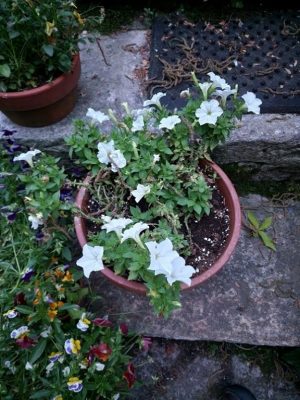
The world of genetics has really had a tremendous impact on our lives. There is a lot of talk about GMOs, or genetically modified organisms, in the news. Labels even alert us to the presence of these crops in our foods. I wanted to share a new plant called the Firefly Petunia. It was not fireflies, but mushrooms that gave this plant its ability to glow. This is known as bioluminescence in the world of biology.
Through feats of genetic engineering, a gene is taken from one organism and placed into another. This is where people become worried. Humans, however, have been doing this for hundreds of years. The best looking or most productive organisms were bred together for the next generation. This is called selective breeding, and it essentially concentrates beneficial versions of genes in the offspring.
Now what is determined to be the most beautiful is truly in the eye of the beholder. Some people, for example, selected for white flowers in a normally purple flowered species, Echinacea purpurea. Some have even taken things a step farther and crossed different species of plants to obtain new colors of flowers. In nature, separate species have evolved isolation mechanisms to maintain their identity. When our plant breeders force a cross of the species boundary, much of the time it was done with closely related species of plants within the same genus. A great example of this is the crossing of Echinacea purpurea, the purple cone flower, with Echinacea paradoxa, the yellow cone flower. This was done to obtain hybrid offspring that have red or orange flowers. These were back crossed with the parent varieties, so they have the same growth habit and form, but with new colored flowers.

This hybridizing never really ruffled many feathers though, as the plants were very closely related anyway. More modern GMOs, like our Firefly Petunias, are obtained not through “natural” pollination processes, but through genetic manipulation. Scientists literally take one or more genes from one species and place them in another. These species are not closely related, so it may become an ethical conundrum. Here, one may ask if we should take a gene from a mushroom and place it into a plant. A similar circumstance was seen over twenty years ago in the aquarium industry, where genes from corals and jellyfish were placed into tropical fish to make them fluorescent Glofish.
On the question of ethics, I cannot tell you what to think, or what is right or wrong. We each will need to answer that question for ourselves. It does remind me of a quote from Jurassic Park, where Dr. Ian Malcolm states “…your scientists were so preoccupied with whether or not they could that they didn’t stop to think if they should.” The real question is where do we go from here. For the fish, it was species after species of Glofish, and for me, the novelty started wearing off. After all, how many species will be made fluorescent before it just gets boring? Now for our plants, will we have roads lined with glowing trees to eliminate the need for streetlights? Will we have glowing houseplants that function like night lights? Ultimately, it will be up to you, the consumer.
For me, this is just cool science. We ship and plant petunias all over the world. Are these glowing petunias going to cause any harm? Probably not, as none of the other ones have. When I go outside at night to take the dog out and see the bioluminescent petunias, it puts a smile on my face. It reminds me of the fact that we, as humans, are capable of many things. I can’t help but ponder if this will inspire a sense of awe and wonderment in our children. Maybe some may even study genetics because of these petunias. What if one of them ends up finding a cure for a debilitating human disease, all because of a glowing plant? And while some may say that this daydream of mine is just science fiction, need I remind you that so were glowing plants a few years ago?
For your gardening questions, feel free to contact us, toll-free, at the UConn Home & Garden Education Center at (877) 486-6271, visit our website at www.ladybug.uconn.edu or contact your local Cooperative Extension center.
Seen any Sawflies?
By Dawn Pettinelli, UConn Home & Garden Education Center
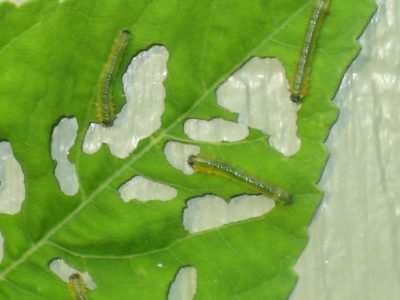
Gardeners know that amidst the promises of each new growing season come its challenges, usually in the form of weather or pests. A common insect pest this time of year are sawfly larvae, which feed on some of our favorite plants including roses, azaleas, perennial hibiscus, dogwoods, and some pines. If populations are high, significant damage can occur.
Sawfly adults are small, short-lived insects slightly resembling wasps to which they are related but their waists are generally thicker. Their ovipositor (egg-laying appendage) is somewhat saw-like in appearance, hence their common name. Eggs may be laid singly or in groups.
Larvae look like small caterpillars but there is a distinctive difference between caterpillars in the Lepidoptera family that transform into butterflies and moths, and sawfly larvae in the Hymenoptera family. Larvae in both families have numerous pairs of legs. From the head, the first three pairs are thoracic legs that correspond to an adult insects’ three pairs of legs. Count the number of fleshy leg pairs (pro-legs) after that. Caterpillars have 5 or less pairs while sawfly larvae have 6 or more.
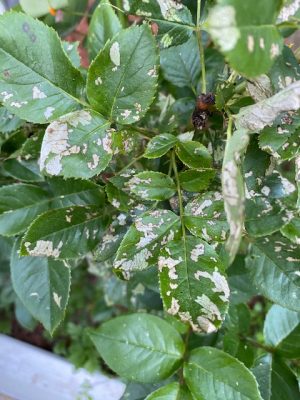
Check your rose bushes for rose slugs, a common name for at least 2 species of sawflies whose larvae may be feeding on your plants. One is thought to be native to the U.S. and the other accidentally introduced from Europe. Both were noticed as pests in the Boston area over 100 years ago and do similar damage to rose foliage.
The small green caterpillar-like larvae that may be ½ to ¾ inch long depending on the species skeletonize the leaves and only the veins remain. They can feed for several weeks if not controlled and move to the undersides of the leaves during the day making them hard to spot. One or two generations may be present each season, again depending on species. Mature larvae will pupate in the soil below plants, where they overwinter and will reemerge the following spring.
Hibiscus sawflies feed on members of the mallow family with the most common one in this area being the large-flowering perennial hibiscus. The green larvae are small, and also can be found on the undersides of leaves where they often go undetected until large leaf areas are consumed.
There are at least 3 species of sawflies that feed on azaleas in this area. The small green larvae have tannish heads but are hard to spot at first as they feed on emerging foliage. Keep an eye out for foliar feeding at the edges of the leaves. The larvae are less than ½ inch in length and feed until late June or early July. There is only one generation per year and these larvae will also drop to the ground to pupate and overwinter in the soil below plants.
Pine sawfly species seem to prefer Mugo, Scots and red pines although they can feed on others. Some are inadvertently introduced pests like the European pine sawfly. Since they were first noticed around 1925, they have become widespread pests. The larvae may be up to an inch long and is grayish-green with mostly darker parallel stripes. Red-headed pine sawfly larvae have red heads as the name indicates but has a yellow body with black spots.
Pine sawfly adults typically lay groups of eggs so multiple larvae hatch and feed in groups. They have a very distinctive defense mechanism when disturbed. Most curiously they rear up and ‘wave’ as you wave your hand over them. This does discourage insect, avian and vertebrate predators, at least to some extent.
Dogwood sawfly females can lay more than 100 eggs on the underside of their preferred grey dogwood host plant. Larvae can consume the whole leaf as they mature leaving only the large midvein. Young larvae are translucent and yellowish but develop black spots and become covered with a white powdery coating as they mature. Their appearance can make a gardener think there are two species of insects attacking plants rather than one. When mature, the larvae seek out an overwintering location with rotted wood on the ground being preferred.
Regardless of which species of sawfly is attacking your plants, options for control include hand picking, insecticidal soap, Spinosad or other insecticides labeled for sawflies. While Bacillus thuringiensis (BT) can be used for caterpillars in the Lepidoptera family, like cabbageworms and Eastern tent caterpillars, it does not work on sawflies.
If you have questions on identification or control of sawfly larvae or any other gardening questions, feel free to contact us, toll-free, at the UConn Home & Garden Education Center at (877) 486-6271, visit our website at www.homegarden.cahnr.uconn.edu
Keep your Perennials & Annuals Looking Fabulous All Season Long!
By: Heather Zidack, UConn Home & Garden Education Center
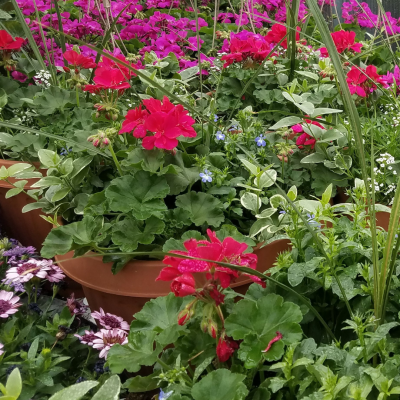
Hanging baskets, planter boxes and perennial gardens that are bursting with color are seldom planted in spring and left untouched until autumn. Deadheading, pruning, trimming and pinching are all techniques that gardeners can use to get that perfect look all season long. While it may be intimidating, this simple task can result in a huge visual impact with only a little effort. Through a series of pruning techniques, we manipulate our perennials and annuals to give us the most beauty we can get out of them in such a short season. It is important to recognize that cutting healthy flowers or shoots can help plants in the long term – no matter how much it may pain us as gardeners to do so.
Deadheading is a widespread practice where gardeners remove flowers that have gone by. One of the first things to become aware of is the difference between a bud and a spent bloom on the plant you are working on. Many gardeners will snip petunia buds, mistaking them for spent flowers. It is important to be vigilant with these cuts. Remember that your plant's goal is to reproduce, and they use flowers to do so. By removing the flowers, you are stopping the plant from producing seed and encouraging it to restart the cycle – meaning more flowers for you!
Some gardeners will select “self-cleaning” varieties of annuals that will shed their flowers without the need to deadhead all summer long. In general, these may not produce seed; therefore can easily restart the process themselves.
The whole practice of deadheading, pinching and trimming herbaceous plants can be boiled down to redirecting the plants energy into different purposes. Where deadheading helps to clean spent flowers, pinching will remove new buds before they bloom. If you want to encourage beautiful single stem cut flowers, for example, you may decide to pinch lateral (side) flower buds to force the plant to put all its energy into a single bloom at the top. Alternatively, pinching the terminal (top) bud will give you many smaller flowers on one stem, creating a fuller appearance.
This same principle applies to pinching shoots of herbaceous plants to make them fill out more. Cutting further down a stem will again remove that terminal bud and cause the plant to focus its energy on new shoots that come from nodes further down the stem. Think of how full your basil plants flush out when you harvest fresh herbs.
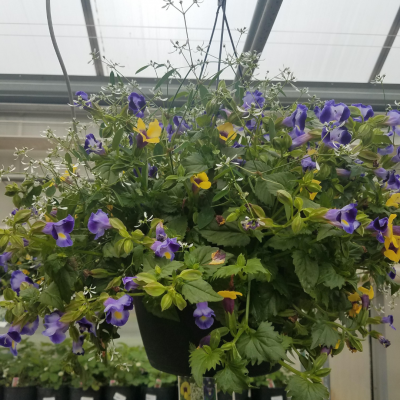
Often, gardeners will notice that in mid to late summer their hanging baskets will start to look “tired.” They may notice prolific flowering on the ends that hang down, but often see that the center of the basket is not as full or may even be dying out. The first thing to check for is to make sure that you are watering them regularly. Because hanging baskets are suspended in the air and uninsulated, they will dry out faster. When you are trimming herbaceous plants for growth you can take one third of the plant volume away at a time, safely. Think about it as playing hair stylist! Cut back one third of the longest growth at the ends, and watch new growth come from the roots. It may also help your hanging baskets to remove any branches that have been shaded or dried out in the interest of “lightening” the growth that is hanging down. Again, you may lose flowers for a week or two – but the result down the road will be beautiful!
For perennial gardens, June is a wonderful time to do some pruning as well. Cutting back early flowering perennials can encourage a second flush of flowering in some species. This works exceptionally well for plants like Salvia, Nepeta, and Lavender. Deadheading throughout the season will help plants like roses and Echinacea continuously flower. And pinching can help perennial mums form their shape for the fall.
Summer is a stressful time for plants! Disease, pests, and extreme weather can all contribute to a stressful environment. Our New England summers can promote these pressures with high heat and humidity levels. During these times, pay careful attention to your watering habits and adjust, as necessary. In times of drought or excessive heat, plants will use water faster for hydration and cooling, just like we do. Being aware of this can help you know when to check for water and help you be more diligent with your watering practices. Using a balanced, water-soluble fertilizer can also promote plant health and reduce stress in perennials and annuals. This is why it is great to fertilize after pruning and deadheading. If you need more information on trimming, watering, fertilizing, or any other gardening questions, feel free to contact us, toll-free, at the UConn Home & Garden Education Center at (877) 486-6271, visit our website at www.homegarden.cahnr.uconn.edu
Luscious Lemony Herbs
By Dawn Pettinelli, UConn Home & Garden Education Center
With summer almost around the corner, many of us are setting in vegetables and herbs in hopes of preparing delectable culinary delights as these plants mature. Aromatic herbs bring amazing flavors and zing to all sorts of savory and sweet concoctions. A citrusy taste complements many dishes and some may not be aware of the wealth of lemon-flavored herbs that are widely available and also easy to grow.
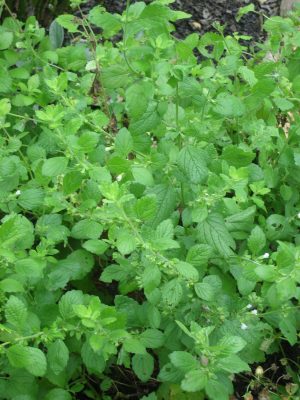
Long-lived lemon balm has been a staple in my herb garden for years. The attractive heart-shaped, scalloped leaves have a delicate scent when rubbed. Lemon balm is a hardy perennial native to Europe and has long been grown for its culinary and medicinal purposes. Fresh or dried leaves can be made into a calming tea that reputedly reduces anxiety. They can also be used in savory chicken dishes, to make pesto and even in baked goods. The lemon balm I grow is the species and it produces flowers that, like many members of the mint family, are loved by bees. A dilemma ensues as to whether to leave the blossoms for the pollinators and deal with the copious seedlings that pop up the following year, or cut the plant back to encourage more leaf production. Also, once lemon balm flowers, the leaves take on an unpleasant ‘soapy’ taste. Cultivars such as ‘Compacta’ are sterile, so no seeds are produced.
As long as it is grown in a well-drained soil, lemon thyme is another long-lived herb. Growing just 4 to 6 inches tall, it’s an attractive plant in the herb garden, as an edging plant or even as a front border plant in perennial gardens. There are green, golden, and variegated leaved cultivars. Sprigs of lemon thyme can be dried but I like to use them fresh in chicken or rice dishes. The pinkish flowers usually open in July and are a big pollinator draw. Like many herbs, the best flavor is obtained collected before flowering. Plants respond well to regular trimmings.
Lemon basil is an annual in our climate but easily grown from seed. Like all basils, it does best in a sunny, fertile site with adequate moisture. Plants also do great in containers. Leaves have a fresh lemony scent and taste with some hints of mint and spices. If growing from seed, one might want to try ‘Sweet Dani’, which was a 1998 All America Selection winner. Named cultivars such as ‘Mrs. Burns’ lemon basil usually have larger leaves than the seed grown types. Pinch out flower stalks as they form for better flavor or for a longer and more abundant harvest, cut off the top third of your plants about once a month. This encourages greater branching and leaf production. Lemon basil rice is my favorite way to use fresh leaves.
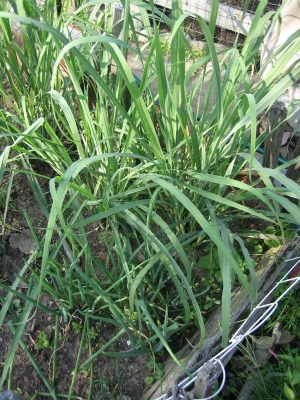
A tender perennial, lemon verbena, is mostly grown as a container plant and overwintered indoors. Plants have an exceptionally strong lemon scent and if happy, grow quite vigorously. They can easily get 3 or 4 feet tall and will grow into a small tree in warmer climates. Lemon verbena is native to South America, so it enjoys full sun and hot weather. Leaves can be used in potpourris, teas, and sweets.
Another tender perennial best grown in a pot is the lemon scented geranium. There are several named cultivars with some, like ‘Mabel Gray’ and ‘Rober’s Lemon Rose’, having a stronger scent. Either buy plants or start from a friend’s cutting. The lovely scented wavy leaves can be placed in the bottom of a cake or loaf pan and then filled with batter and baked, imparting a lovely pattern and slight lemony flavor. They can be used fresh or dried for a variety of culinary uses and are also good in potpourris.
Those enjoying Asian cooking are likely already familiar with the rich flavor of lemon grass. While it is native to India and only hardy to zone 10 to 12, it is a pretty vigorous grower that would do well in either a garden bed or container. Reportedly plants may reach 2 to 3 feet in height by midsummer if kept well-watered. The leaves as well as the bulbous base of
the stem are used in recipes. A few stalks can be removed as needed for cooking. Cut back potted plants to 6 inches before overwintering in a sunny window indoors.
For more information about growing lemon scented herbs or on other gardening topics, feel free to contact us, toll-free, at the UConn Home & Garden Education Center at (877) 486-6271, visit our website at www.homegarden.cahnr.uconn.edu or contact your local Cooperative Extension Center.
Tying Climbing Roses
By Marie Woodward, UConn Home & Garden Education Center

Climbing and rambling roses are a beautiful addition to any garden, adding height and depth to your outdoor space. These types of roses require proper training and tying to ensure that they grow in the desired direction, produce the most blooms and don’t become tangled or unruly. Follow this guide on how to tie climbing and rambling roses to get the best results.
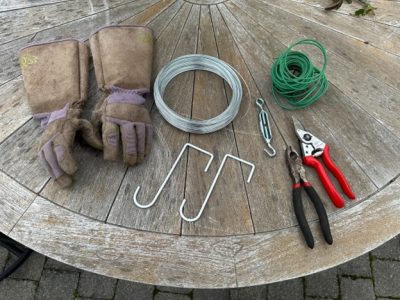
For materials, one would need some twine or soft plant ties, a sharp pair of pruning shears, sturdy long-sleeved, thorn resistant garden gloves. Also, some wire and tools to secure to a trellis, fence or other structure may be necessary.
Climbing roses have two types of canes. Main canes are stems that originate from the base of the rose giving it its structure and support. They are also referred to as leaders. Lateral canes originate from the main cane. It is the lateral canes that produce the flowers and add volume to the shrub. In general, main canes are not pruned unless they are diseased or dead.
Before you start attaching the plant to a trellis, make sure that your rose is properly pruned. Removing any dead or diseased canes will encourage healthy growth. Cut back any wild or overly long shoots to create a manageable framework for tying. Starting with this step will allow for more control as you move through the process of tying.
Supportive wiring, better known as strain wires, helps to promote flowering. They hold the main canes at a 45–90-degree angle. These angles encourage lateral canes to flush and produce more abundant flowers.

If you're training your roses against a wall or fence, attach the horizontal strain wires to the structure, spacing them about 12-18 inches apart vertically and 5 feet apart horizontally.
If you have a vinyl fence you can use vinyl safe hooks and secure the wire with a turnbuckle vertically, spacing them about two feet apart to avoid drilling holes in the vinyl material.
Using twine or soft plant ties, attach the rose canes to the support structure at regular intervals, starting about 1.5 feet from the ground. Tie them securely but not too tightly You want to allow room for the canes to grow and expand. Avoid fishing lines or other rigid materials. Using the wrong ties or tying too tightly could lead to cane injury.
As the roses push new growth, continue to tie the new main canes to the support structure. Continue to guide them in the desired direction, with those 45–90-degree angles as a guide.
Regularly check your roses and adjust the ties as needed. Ensure that they remain secure but not too tight. Prune any wild or unruly shoots and remove any dead or diseased wood to keep your roses healthy and under control.
By following these steps and regularly maintaining your climbing rose, you’ll create a stunning vertical display that adds beauty and depth to your garden. While this guide provides good tips on for starting and maintaining younger climbing roses, older roses that have been neglected may need restorative measures. If you need more information on climbing roses or any other gardening questions, feel free to contact us, toll-free, at the UConn Home & Garden Education Center at (877) 486-6271, visit our website at www.homegarden.cahnr.uconn.edu
Tips on Selecting a Flowering Tree
By Dawn Pettinelli, UConn Home & Garden Education Center
If there’s a spot for a spring flowering tree in your landscape, now is the time to look at the trees showing off their floral splendor. Do you find one or two particularly appealing. Take note of the various flower colors, tree shapes and sizes. Once you’ve selected an alluring flowering tree or two, do a bit of homework.
Many of the spring flowering trees have several cultivars and they may vary in flower color, leaf variegation, mature height and width, fall color and so on. Pick the one that fits your location. Will the plant be in sun or shade? Is it going to be positioned as a specimen tree or incorporated into a foundation planting or a border? Will it add multi-season interest with attractive foliage, fruits or seed pods, or interesting bark? What insect or disease problems is it prone to?
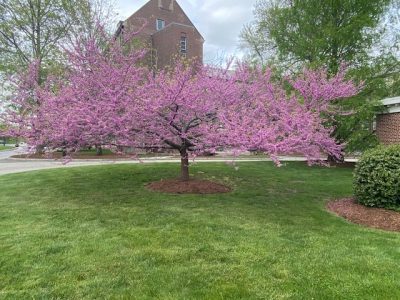
Redbuds (Cercis canadensis) are bursting with blossoms right now, at least on the Storrs campus. The extremely abundant, purple-pink peas shaped blossoms practically cover the tree. At maturity, trees reach about 20 to 30 feet tall with a slightly larger width, ending up in a roundish shape with a flatter top. After flowering, heart-shaped leaves develop while faded blossoms give birth to small, flattened legume seed pods that contrast nicely with the plant’s dark, scaly bark. Cultivars are available with white or more true pink flowers, variegated foliage, weeping forms and attractive fall foliage colors. Redbuds tolerate full to part sun and well-drained soil but avoid hot, dry locations for best establishment and flowering.
Dogwoods are a favorite of many. Their pink, white or red colored bracts dazzle especially in filtered sunlight. Dogwoods are native to the eastern and central United States where they are usually found as an understory tree. Most cultivars grow to about 30 feet in height with about the same width at maturity. The large 4-inch blossoms mature to form shiny red fruit much loved by birds. These exceptionally beautiful plants favor a cool, moist, acidic soil with adequate amounts of organic matter. Dogwoods struggle when faced with heat stress, drought, and pollutants so site carefully.
Another flowering tree that also does best in more natural settings, especially those with moist soils is our native shadbush or serviceberry (Amelancher canadensis). The name, shadbush, comes from the fact that this plant typically blooms when the shad return to fresh water to spawn, usually right about now. This plant can be grown as a single stemmed specimen or a multi-stemmed large shrub. Mature trees reach about 20 feet in height but there are shorter, more shrub-like cultivars. Shadbush sports white flowers in 2-to-3-inch racemes. Dark fruits are attractive to many animals plus both the gold autumn foliage and gray bark are very attractive.
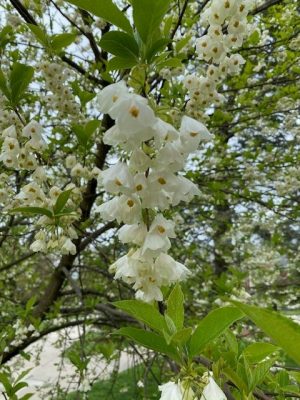
A standout for me this time of year is Carolina silverbells (Halesia carolina). A multitude of white, bell-shaped blooms adorn the branches of this 20-to-40-foot tree. Although it is native to southeast U.S., it is hardy to zone 5. Autumn color is not notable, but the tan 4-winged fruit persist well into the winter and stand out against the stark winter landscape and silvery grey bark. Be sure to check out ‘UConn Wedding Bells’, a very floriferous cultivar discovered by UConn Plant Science professor, Dr. Mark Brand. It has a smaller, rounder form with flowers larger than the species.
The star magnolia (M. stellata), as its Latin name implies, is definitely a stellar landscape plant. Gorgeous, lightly fragrant 3-to-4-inch blossoms grace the dense cluster of stems. Mature plants reach up to about 20 feet with a slightly narrower width. Plants do produce red fruits but most drop before they mature. I was delighted to find a seedling after I lost the parent tree in that late October snowstorm we had a number of years ago.
Other worthy spring flowering trees to consider include the flowering crabapples and cherries that have many exciting and lovely cultivars. A great place for information on woody plants is the UConn Plant Database (www.plantdatabase.uconn.edu). If you need more information on selecting a tree or any plant for your landscape or on other gardening topics, feel free to contact us, toll-free, at the UConn Home & Garden Education Center at (877) 486-6271, visit our website at www.homegarden.cahnr.uconn.edu or contact your local Cooperative Extension center.
Eastern Tent Caterpillars
By Pamm Cooper, UConn Home & Garden Education Center
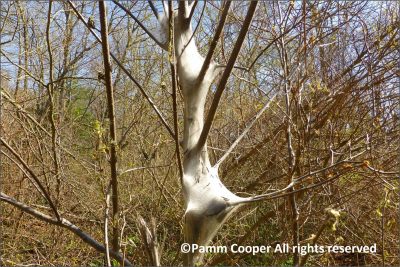
Eastern tent caterpillars, Malacosoma Americanum, are native to North America and are noticed mainly because of the silken tents they build in the forks and crotches of trees in early spring. While most tents are found on black cherries, they can also be found on other trees such as apple and crabapple. They are readily visible since tents are constructed before leaves fully expand. There is only one generation per year.
These caterpillars are hairy and dark when small, and later instars have two yellow lines along the back. A white medial stripe goes along the sides of the body, and this is flanked by two yellow lines. There are blue blotches along its side as well. Bottom hairs on the body are rusty brown. Forest tent caterpillars are also hairy, but they do not make tents, and their bodies
are blue with white dots on the back. Handling should be done with gloves on as some people may have sensitivity to the hairs.
Egg masses are black, laid on small branches of host trees the previous year, and the egg mass rings around the branch. Sometimes they are mistaken for small black knot galls. 150-300 eggs may be in each egg mass. Caterpillars typically hatch as black cherry leaves begin to expand the next spring. Caterpillars feed on leaves and buds and rest communally by day in the nests they construct from silk.
While they can almost defoliate small trees, these caterpillars usually have completed their feeding stage in time for the trees to put out new leaves by early summer. The more tents there are on small trees, though, the greater number of caterpillars there are, so damage will increase.
While protected from many predators while inside the tents, there are birds that will tear the tents apart to feed on the caterpillars inside. Both the black-billed and the yellow-billed cuckoos are known for their ability to do this, and native vireos will also seek out and rip apart the tents.
Mature caterpillars leave the host plants in early summer in search of suitable sites to pupate within a silken cocoon they will spin. Moths emerge later that year. The moths have a fluffy light brown body, and the wings have three bands with the center being narrower than the outer bands and a lighter brown in color. The center band is bordered on both sides by thin, creamy bands.

Occasionally, eastern tent caterpillars have outbreak years where large numbers of the tents can be seen on the same tree. Fresh buds may also be consumed if trees are severely defoliated. When found on residential properties, tents can be swept apart by rakes or brooms, exposing caterpillars to predators, or knocking them off the trees. If warranted, foliage can be sprayed with a biological product called Bacillis thuringiensis subspecies, Kurstaki, or BtK, which only harms caterpillars and not other insects. Caterpillars will ingest the product as they feed on the foliage.
Most healthy trees can tolerate severe defoliation from eastern tent caterpillars. If concerned, look for egg masses in the winter on trees that had been damaged the previous spring. Remove them, if possible, or crush them, or prune the branch off below where the egg mass is found. Or let them be if the trees appear to have recovered. Letting nature take its course with native insects on native trees can often benefit birds and other predators. Do not confuse them with the notorious gypsy moth caterpillars which do not make silken tents or nests of any kind.
If you have a question about tent caterpillars or other gardening topics, contact the UConn Home & Garden Education at (877) 486-6271 or www.homegarden.cahnr,uconn.edu or your local Cooperative Extension Center.
DIY – Grow Flowers for Cutting
By Dawn Pettinelli, UConn Home & Garden Education Center
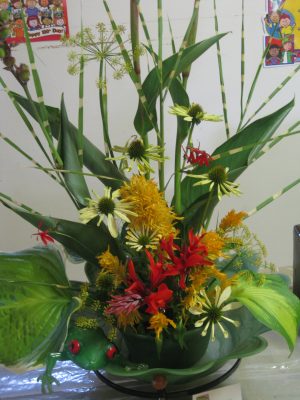
Do you just love fresh flower arrangements for the table or even that single bloom in a vase by your bedside? Wouldn’t it feel great to just stroll out your back door, clip some blossoms, bring them inside and enjoy their beauty? There’s no reason that you can’t. Even a small yard or garden space can yield blossoms for cutting.
While many of us have flowering perennials and even woody plants that make for great arrangements, perhaps a dedicated cut flower planting would provide many more stems for cutting and not create any empty spaces in our garden designs. When planning your cut flower garden, first decide where it should go. The majority of blooming plants need at least 6 to 8 hours of sun each day, a well-drained, fertile soil and adequate water during dry spells. As with all garden plants, a soil test is a great way to find out what is needed to add to soils before planting but without a soil test, follow the directions on fertilizer packages.
There’s still time to prepare new beds for cut flower plantings but another alternative would be to turn over part of the vegetable garden to cut flower production. Probably your vegetable garden already has great soil and is located in a sunny area.
The hardest part of designing a cut flower garden is selecting what plants to grow. There are so many beautiful and exciting flowers to choose from. A good suggestion is to grow easy flowers at first and then progress on to more demanding ones. Another important factor to consider is which flowers need to be purchased as transplants (or started inside earlier under lights) and which can be easily grown by sowing seeds directly in the garden. While there are a number of flowering plants that can be started by direct seeding, you’ll get faster blooms if you purchase or grow your own transplants.

Some that I typically grow each year from seed are zinnias, the tall African marigolds, cosmos, bachelor buttons, calendulas, nasturtiums, and some sunflowers. Cool weather calendulas and bachelor buttons can be sown now but wait until later in the month to plant the rest. A number of cutting annuals will self-seed if blossoms are allowed to mature and the beds are not heavily mulched. Some that spring up for me include ageratums, verbena, ammi, nigella, and wheat celosia. If you have some known self-seeders, wait a bit longer to prepare or till beds to see what sprouts.
Those best purchased as transplants include rudbeckia, snapdragons, cleome, stock, strawflowers, globe amaranth, tithonia, asters and amaranth. Some might have tiny seeds or be slower to germinate or just need a longer time until they produce flowers so starting with transplants may be a good option.
Two annual bulbs that are great for cutting are gladioli and dahlias. A few glad corms can be planted every other week until about mid-June to provide a summer full of spiky, colorful blooms. Dahlia tubers planted mid-May generally start producing blooms by late July but continue until a heavy frost.
There really are quite a few potential cut flower candidates to choose from. Feel free to select whatever colors and flower forms appeal to you most. From a designer’s viewpoint, consider what colors would be most compatible with where you want to place arrangements indoors. Also, whether making more formal arrangements or informal bouquets, flower shape plays a prominent role. Often the most attractive arrangements are filled with an assortment of shapes featuring a focal flower, spiky exclamation points, mounded shapes to hold the arrangement together, greenery for filling spaces and delicate airy springs to lighten the mood. I find mints, artemisia, and ferns make good fillers while grasses, kalimeris, boltonia, and white wood asters provide an airy touch.
The majority of annual flowers do fine at about a 9 by 9 inch spacing so you can pack them in pretty close. Do note that for copious blooms, a fertile soil and adequate water are essential. Maintenance also includes dead-heading, or removal of spent flowers to encourage the production of more blooms. Keep an eye out for plant pests as well.
Even beginning gardeners can set aside some space to grow beautiful flowers for enjoyment indoors. Try out a few this year, make notes on their performance and change up the plant rooster as they gain your approval or not.
For cultural information on growing various species of cut flowers or on other gardening topics, feel free to contact us, toll-free, at the UConn Home & Garden Education Center at (877) 486-6271, visit our website at www.homegarden.cahnr.uconn.edu or contact your local Cooperative Extension center.
Start Now For a Rosy Summer
By Dawn Pettinelli, UConn Home & Garden Education Center
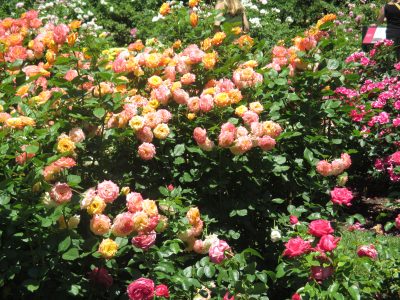
The warmer days of spring will soon be upon us and it is time to think about spring rose care. Any winter protection such as mounded soil, mulch, leaves or rose cones that were placed around grafted bushes should be removed. Release any stems that were tied for winter protection. Fertilize your plants when new growth sprouts with a complete fertilizer such as 5-10-10 or and natural organic equivalent at the rate recommended by a soil test or follow the manufacturer’s instructions on the package. Generally, the fertilizer is sprinkled around the base of the plant and gently worked into the top of the soil.
Repeat blooming roses are heavy feeders and ideally should be fertilized monthly through July. Stop fertilizing at this time as later fertilizations may result in tender new growth late in the season that may not have time to harden off properly. Roses that bloom only once in June are usually only fertilized once in the spring. These include many ramblers and climbers, species roses and antique varieties. Rose books often recommend a dose of Epsom salts for each rose to supply magnesium. If you use a dolomitic limestone to modify the soil pH, however, the plants will most likely have enough magnesium available to them and additional magnesium will not improve growth or branching. Note that according to the American Rose Society, roses prefer slightly acidic soil so strive for a pH between 6.0 and 6.5..

Most types of roses benefit from a spring pruning with the exception of climbing roses which are generally pruned immediately following flowering. Roses are pruned to improve their appearance, to remove diseased or dead wood and to increase the quantity and quality of flowers.
Polyanthas, floribundas and shrub roses do not require much pruning. Any canes that are damaged or broken should be removed as well as canes that are rubbing together. If just the tip of the stem is winter killed, cut back to sound wood just above a healthy bud. Rose bushes that are really overgrown can have about one-third of their canes removed from the base.
Hybrid teas and grandifloras usually require more severe pruning. After eliminating all dead and damaged wood, cut back to 18 to 24 inches. Make your pruning cuts at a slant slightly above a bud, preferably one oriented away from the center of the plant.
If your roses are grafted, it is also important to remove any suckers arising from the rootstock.
Spring is a great time to add a few more roses to your garden. Roses are soil either bare-root or as container plants. Those sold in containers can be planted either in partial leaf or full leaf. Mail ordered bare-root stock, however, should be planted when it is still dormant. It is best to plant bare-root roses as soon as you get them. If planting has to be delayed for a day or two, remoisten the packing material and store in a cool, shady location. When it is time to plant bare-root stock, unpack the plant and place the roots in warm water for an hour or two. Cut off any dead or injured parts and plant immediately after soaking.
Roses require a minimum of 6 hours of sun each day for maximum bloom. An area with good air circulation will cut down on disease problems. Soil type is not as important as drainage. Roses will not tolerate wet feet.
When planting grafted plants, set the bud union, which is the point where a rose cultivar is grafted to the root stock, about one inch below the soil level. Roses require about one inch of water per week. If at all possible do not get the leaves wet when watering as this promotes the spread of diseases such as black spot.
Roses benefit from the application of an organic mulch like shredded bark, pine needles or cocoa bean hulls. Mulches not only keep weeds down but help conserve moisture. If you have any questions on roses or other gardening topics, contact the UConn Home & Garden Education at (877) 486-6271 or www.homegarden.cahnr,uconn.edu or your local Cooperative Extension Center.
It’s Spring! Time to Feed the Plants!
By Dawn Pettinelli, UConn Home & Garden Education Center
Plants need nutrients to grow and develop just like we need vitamins and minerals. They get most of their nutrients dissolved in the water they take up with their roots. When we add fertilizer to the soil around our garden plants, we are adding vital plant nutrients.
Native Connecticut soils are typically low in pH and low in nutrients. Our native plants have adapted to our native soils but most of our garden plants are not from around here. Zinnias and tomatoes are from South America, bluegrass lawns and lilacs hail from Europe and rhododendrons from Asia. Our native soils may not supply the nutrients they need so it is up to us to do so.
Of course, the best way to know which nutrients and how much to add is with a soil test. April is a very busy month at the UConn Soil Nutrient Analysis Lab (www.soiltesting.cahnr.uconn.edu) but there is still time to get your soil tested before planting.
Without soil test recommendations, always follow the directions on the fertilizer package. Applying too much can injure your plants plus excessive nitrogen and phosphorus can wind up in our waterways. Before fertilizing, calculate out the square footage of your garden or lawn. You don’t need to measure exactly; you can measure a pace and then walk down the length and across the width of your gardens to get a rough estimate of area. For odd-shaped beds or lawns, break them down into more square, oval or rectangular areas and add them up.
All fertilizers come with 3 numbers on the package denoting the percent, on a dry weight basis, of nitrogen, phosphorus and potassium. Nitogen promotes green, leafy growth, phosphorus encourages fruits and roots, and potassium is for all round health and tolerance to stresses like drought, cold and disease. So, fertilizers with a higher nitrogen number would be most appropriate for turf grasses, trees and shrubs, while ones higher in phosphorus are generally used in vegetable and flower gardens.
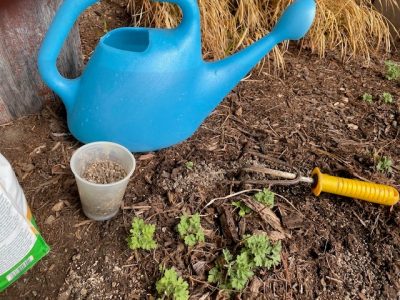
Whether you select a synthetic or natural organic fertilizer is a matter of personal choice. Both are beneficial to plants. For annual plantings, whether vegetable or flowers, it would be ideal to mix the fertilizer into the top 6 inches of soil. That’s where most of the roots will be so it makes sense that the nutrients they need are there too. Put down the fertilizer, as well as any limestone or other amendments shortly before planting. Long season annuals, like tomatoes, pumpkins and marigolds would appreciate a second application of fertilizer, referred to as side dressing, about 2 months after the first one.
As you are cleaning up your perennial beds and see the new shoots popping through the soil, add some fertilizer around plants and carefully scratch it in. Do the same for bulbs. It is harder to fertilize if the beds are heavily mulched. Not much fertilizer spread on top of mulch will make it to the plant roots. Rake or pull away the mulch, sprinkle some fertilizer directly to the soil around your plants and replace the mulch.
For trees and shrubs, fertilizer should be spread under the whole canopy as a healthy root system will grow at least as wide as the branches and perhaps even more so. Do your best to remove the mulch before fertilizing. Typically trees and shrubs are fertilized once a year in the spring. Once they have reached their mature size, often the fertilizer is cut down to half rate as woody plants can recycle many of the nutrients they need.
Lawns can be fertilized now but pay attention to the moisture level of the soil. With all the rain that we have been experiencing, the soil is pretty soggy in spots. Stay off wet soils as they will become compacted. Most lawns do well with just a spring and fall application of fertilizer. If the clippings are left down, they supply nutrients plus add organic matter to the soil. Be sure to set your spreader on the proper setting.
If you have questions about fertilizing or if you have any other gardening questions, contact the UConn Home & Garden Education at (877) 486-6271 or www.homegarden.cahnr,uconn.edu or your local Cooperative Extension Center.
Watch for Bulb Diseases
Dr. Nick Goltz, UConn Home & Garden Education Center; UConn Plant Diagnostic Lab
Gardens in New England come to life in spring thanks, in large part, to bulbs! Spring bulbs are reliable, perennial color-bringers and seem equally at home in landscapes and containers. Daffodils (Narcissus spp.), grape hyacinth (Muscari spp.), and tulips (Tulipa spp.), are just some of the bulb plants that grace our gardens this time of year, and they remind us that the blooms of summer alliums aren’t far behind. While these plants might seem effortless to grow, they are not without their fair share of disease issues!
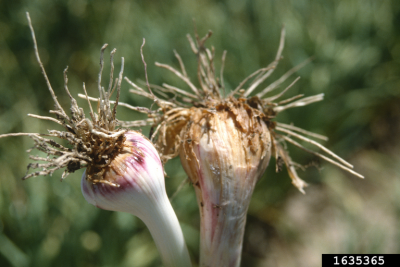
One common disease of bulbs we see here in Connecticut is Fusarium wilt and bulb rot.
Bulbs generally prefer average to loamy soil with good drainage. When planted in clay soils or following long periods of rain in early spring, however, they are susceptible to rot diseases caused by fungal pathogens such as those in the genus Fusarium. The various wilt and rot diseases caused by Fusarium species can be destructive and sometimes difficult to control. Symptoms include wilting, brown lesions at and below the soil line, vascular discoloration, bulbs that are soft or spongey, and, especially with garlic (Allium sativum) and relatives, a purple-red discoloration of bulb tissue. Plants affected by this soil-borne fungal disease do not recover, so it is wise to be proactive with management and prevention.
If your bulb plants do not emerge properly in the spring or emerge but wilt soon after, fail to flower, or display other symptoms associated with root rot diseases, pull them up and throw them away! Fusarium and similar fungal pathogens often survive the winter in the soil on diseased plant tissue from the year before, so it is important to keep your garden clean and to not compost diseased plant tissue, as most home compost bins do not reach temperatures necessary to kill pathogens. Fungi like Fusarium thrive in soggy soils, so do your best to prevent flooding and standing water where bulbs are planted. There are no fungicides that will completely control or eradicate Fusarium in a landscape, but some are helpful with preventing infection of healthy plants. Remember to always wear protective equipment and follow label rates and instructions if you choose to apply fungicides.
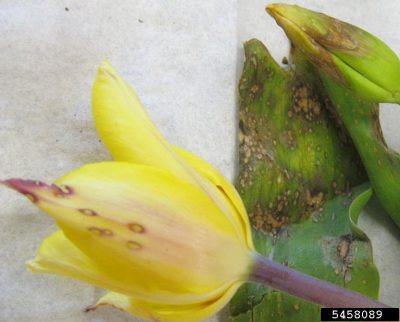
Another common fungal disease of bulbs grown here in the Northeast is Botrytis gray mold or tulip fire. Fungi in the genus Botrytis cause disease symptoms on many different host plants. Though it is often called “gray mold” when associated with other plants, for tulips, the disease is usually called “tulip fire” due to the spots it causes on leaves and flowers, often with dark borders resembling a burn.
Botrytis fungi are very common and are capable saprophytes, meaning they feed on dead or decaying tissue and contribute to nutrient cycling in the environment, but can be problematic in managed landscapes. To cause disease, Botrytis fungi must first colonize and get nutrients from dead or declining plant tissue, such as fading flower petals, over-ripened fruit. Once the fungus is established in its host plant, it becomes more aggressive and invades healthy plant parts, causing brown lesions and decay.
To prevent Botrytis gray mold and tulip fire, try to encourage good airflow around your plants. Many people plant their bulbs closely together, like eggs in a carton, but this can make bulbs susceptible to tulip fire over time when treated as perennials. Dig up your tulips when they appear crowded, and each year when dealing with a potential disease issue. Inspect bulbs before you plant them again, and discard bulbs that are not firm, discolored, or otherwise do not appear healthy. Rotate to new locations and avoid planting consecutively in the same spot if there has been a history of disease there.
If you have questions about growing bulb plants, are dealing with a plant health issue, or regarding other gardening topics, feel free to contact us, toll-free, at the UConn Home & Garden Education Center by emailing ladybug@uconn.edu. You can also call us at (877) 486-6271, visit our website at www.homegarden.cahnr.uconn.edu, or contact your local Cooperative Extension center.
Grow Vegetables – Save Money
By Dawn Pettinelli, UConn Home & Garden Education Center
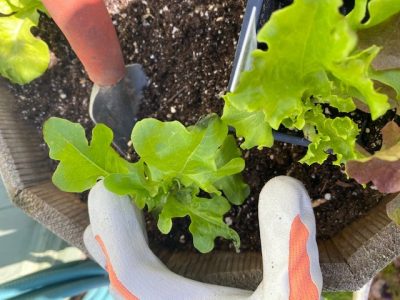
Anyone who grocery shops on a regular basis has likely noticed a higher tally at the checkout counter. The latest consumer pricing analysis from the USDA is predicting a 1.3 percent increase in food prices. While we can’t do much to lower the prices, one thing we can do is grow some of our own vegetables and herbs.
The investment in a small 100 square foot or so garden is not large, and one can be assured of healthy, high quality fresh produce. Vegetable gardeners can also control what, if any, types of pesticides are used on the plants. One source suggested that a $70 investment in plants and seeds could produce a harvest worth $600 or more over the growing season. Already having basic garden tools was probably taken for granted.
If yard space is limited or too shaded, consider renting a plot in a community garden, maybe teaming up with a friend trading garden chores for produce, or consider growing in window boxes and other containers. Even small areas provide opportunities to grow your own food. While a head of lettuce can cost $2-3 dollars at the grocery store, for that same amount one can often pick up a cell-pack of 6 lettuce plants and grow them out in a large container, or 6 square feet or so of garden bed.
Starting plants directly in the garden by direct seeding can also offer considerable savings. I picked up a package of mixed lettuce variety seeds for $3.25 that contains 500 seeds. This would enable one to grow multiple succession plantings for at least 2 or 3 years. If stored in a dark, cool, dry spot, many seeds last for at least 2 years if not longer.
Good candidates for direct sowing would be bush or pole beans, lettuce and other green leafy vegetables, radishes, peas, carrots, summer and winter squash, cucumbers, and corn. If they tickle your tastebuds, you can toss in turnips and parsnips.
Some vegetable varieties have greater cold tolerance than others so your peas, radishes, and many green leafy vegetables can usually be planted by the end of this month depending on the weather. In northern parts of Connecticut, it would be good if the soil warms and dries up a bit more.
Other types of vegetables are better to set in the garden as transplants, whether you grow them yourself or purchase them in cell-packs. The main reason for this is twofold. Certain plants, particularly in the brassica family, like cabbage, broccoli and cauliflower germinate fine in warm household temperatures but like to be grown cooler than many of us keep our houses and if left in those warm temperatures grow long and leggy instead of short and stocky. So, it’s just easier to purchase healthy, stocky plants grown in a greenhouse to set in the garden or container, although the leggy ones usually catch up.
The second reason why some plants are better purchased as transplants is because vegetables like tomatoes, peppers, eggplant and leeks have a long growing season – often 80 to 100 days from transplant until they produce harvestable crops. It makes more sense to plant 3- or 4-week-old transplants around Memorial Day so harvesting can start in late July or August. Contrarily, even though some winter squash and pumpkins might take 100 days or so to mature, I typically just direct seed them around Memorial Day because they seem to catch up with transplants, that usually experience a bit of transplant shock, pretty quickly so I don’t feel like I am gaining much by purchasing transplants and more importantly, the particular varieties I prefer are not always available as plants.
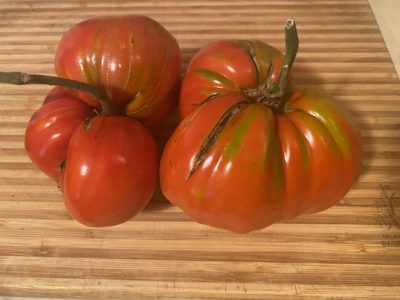
Regardless of whether you have a few containers to fill or a large garden, do some research before purchasing seeds or transplants. There are so many different cultivars available so look up variables like days to harvest, disease resistance, cold tolerance, productivity and more. Make notes on how they taste and any problems during the growing season.
When planning your edible plantings, also think about succession sowings, finding out what pest problems to be on the lookout for, last and first frost dates, mature size and space requirements, and days to harvest.
Feel free to contact the UConn Home & Garden Education Center with questions on growing vegetables, herbs and other plants or if you have any other gardening questions, contact the UConn Home & Garden Education at (877) 486-6271 or www.homegarden.cahnr,uconn.edu or your local Cooperative Extension Center.
Sensational Sansevieria
By Dr. Matthew Lisy, UConn Adjunct Faculty
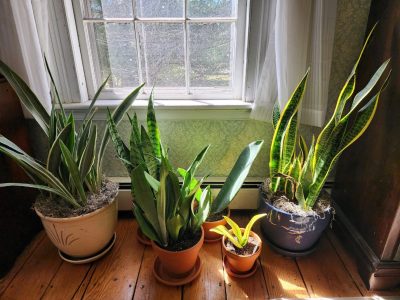
The Sansevieria group make up some of my favorite houseplants. Scientists recently placed them in the genus Dracaena, but its former scientific name seems to be also one of its common names. This plant has many common names including “snake plant” and my personal favorite “mother-in-law’s tongue”. Like many varieties of houseplant, there are some staples that have been around for decades, some newer species that have come to market, and some really interesting cultivars.
These plants have a rhizome, and the leaves grow from the base of your pot. They are very prolific when they like their environment. In fact, they tend to break the pots they are in, so I would recommend using plastic pots, which their growth will eventually deform. If you want to use a clay or ceramic pot, I suggest putting them in a slightly smaller plastic pot, then putting that in the clay pot. You can hide the gap between the two pots with Spanish moss. Being native to Africa, they cannot tolerate cold temperatures. Typical household temperatures work well, but avoid anything below 55 degrees F.
Their upright growth habit allows the grower to have many varieties in a small area.
Overwatering is the quickest way to kill any houseplant, but especially so with these. In the winter, you probably only want to water once a month, and sparingly at that. Do not let them get soggy or this otherwise hardy plant will rot. In the warmer months when the plant is actively growing, allow the soil to dry between waterings, but then water more liberally. These plants have the reputation of being a low light plant, which they certainly can handle. Sometimes people place them in the darkest corner where they hang on for a few months, but then eventually run out of stored resources and die. Remember they do need some light to photosynthesize so bright indirect light is best. The other problem I have seen is their unique, flat leaves can become covered in dust. Either dust them manually, use a blower, or take them outside in warm weather and hose them off.
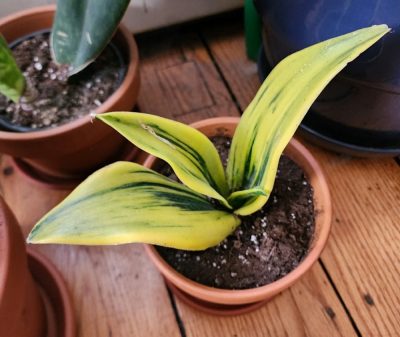
The Sansevieria group can be divided into two types, those with flat leaves and those with cylindrical leaves. Of those groups, there are species that grow tall and some that grow short.
The tall ones make great floor plants while the shorter ones do well when placed on a table. All varieties are fairly easy to propagate. My favorite way is to let the plant grow, and then divide them during repotting; this looks the best in my opinion. If you want more plants quicker, you can take leaf cuttings. Either dip in rooting hormone and replant, or you can place the cuttings in water to take root (change the water daily for best results).
Most of us are familiar with the green and dark green snake plant, as well as the gold edged version. There are some absolutely stunning new varieties on the market today that have selected for any of those colors. For example, there is one called “Moonshine,’ which has no pattern in the leaf at all, instead being pale green. Another interesting one is called ‘Hi Color,’ which has more yellow than green in the leaves. There are others that are selected for their rather dark green hue that approaches black in color. One of my new favorites is a different species called Sansevieria masoniana, commonly referred to as “whale tail”, “shark fin”, or some combination thereof. No matter which one you choose, you really cannot go wrong with these plants. They are readily available at most garden and home centers, so why not pick one up and brighten up your home?
For your gardening questions, feel free to contact us, toll-free, at the UConn Home & Garden Education Center at (877) 486-6271, visit our website at www.homegarden.cahnr.uconn.edu or contact your local Cooperative Extension center.
A Beginner’s Guide to Orchids
By Dawn Pettinelli, UConn Home & Garden Education Center
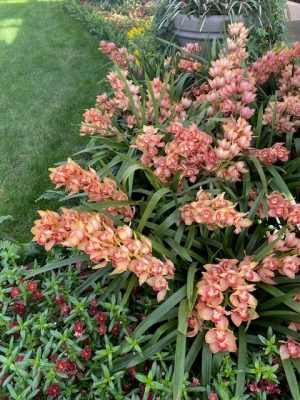
Orchids, with their captivating beauty and elegance, have long held a revered status among plant enthusiasts. If you’re tempted to dive into orchids, this is the perfect time to explore what’s available as it is orchid show season. Those looking for a day trip might want to explore Florals in Fashion at the New York Botanic Garden until April 21. Closer to home, the CT Orchid Society holds its show April 20-21 at the Bristol Senior Center.
Often associated with exotic locales and intricate care routines, these plants are surprisingly adaptable and many can thrive in the comfort of your own home. Whether you're a seasoned gardener or a novice looking to add a touch of sophistication to your indoor space, cultivating orchids can be a rewarding endeavor.
Orchids belong to one of the largest and most diverse plant families, Orchidaceae, comprised of over 25,000 species. They come in various shapes, sizes, and colors, but broadly speaking, orchids can be categorized into two main groups based on their growing habits: epiphytic and terrestrial. Epiphytic orchids grow on trees and absorb their moisture and nutrients mostly from rain. They are usually found in tropical rainforests and need a specialized bark based growing medium. Terrestrial orchids grow in soil and while the most spectacularly colored ones come from the tropics, we are fortunate to have native terrestrial orchids such as lady slippers.
Another important distinction among orchids is their growth pattern, which can be classified as sympodial or monopodial. Sympodial orchids grow horizontally sending out new shoots or pseudobulbs from a rhizome or creeping stems. Cymbidiums and dendrobiums are species that exhibit this behavior. Monopodial orchids grow vertically, with a single stem that continues to elongate as the plant matures. Paphiopedilum and vanda species have this growth habit. Understanding these distinctions can help you tailor your plant care routine to suit the needs of your orchids.
The key to growing orchids successfully in the home is understanding the conditions they need to grow and thrive. These will vary according to the species but in general orchids need bright, indirect light. East and south windows usually supply ample light, but a sheer curtain may be needed to keep orchids out of hot sun from south windows during the summer. Direct sunlight may burn their leaves. Orchids also do well under artificial light.
Next to light, temperature is critical as some like it hot and others thrive in a cooler environment. It makes the most sense to select the orchid species that would do well in the temperature range you prefer. Most species, however, are happiest if there is a 5 to 10 degrees drop in night temperatures.
Orchids also tend to do best in more humid environments and our homes are mostly on the dry side. Consider using a humidifier, using pebble filled trays under plants or even growing plants in ornamental glass cases.
Making sure your orchids are receiving the proper amount of watering can be challenging to beginners. Terrestrial orchids are usually grown in an orchid bark & enriched potting soil mix and need to be kept moist but not overly wet. Epiphytic orchids in orchid pots with bark or attached to slabs of tree ferns can be drenched or dunked and then drained. The roots should not sit in water very long. Some experimentation will be needed to determine frequency of waterings.
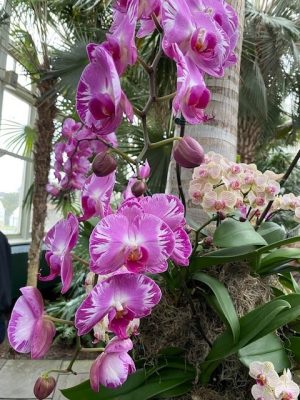
There are so many species of orchids to choose from but beginning orchid enthusiasts might start off with dendrobium species. Dendrobiums are one of the largest and most diverse orchid genera made up of numerous species as well as hybrids. They are even sold at my local grocery store. Dendrobiums are known for their brightly colored flowers that usually bloom in clusters along long stems. They are relatively easy to care for and tolerate typical household conditions.
Phalaenopsis orchids are another large genus that are tolerant of a range of household conditions so are ideal for beginners. Plants can tolerate a little less light than many other species so east windows work well. Nighttime drops in temperature are important to initiate new flower stalks.
Those with cooler growing spaces might want to try Cymbidiums. These plants are just gorgeous in bloom with their long-lasting sprays of colorful flowers. Cool temperatures and bright light are keys to healthy, floriferous plants.
Lady slipper orchids (Paphiopedilum) have distinctive pouch-shaped blooms, similar to our native lady slippers. They are terrestrial orchids preferring a very well-draining potting mix and indirect light.
If orchids are just too alluring, try to attend an orchid show or two, visit local garden centers that sell orchids and can answer your questions about them, or even check out the resources at the American Orchid Society (https://www.aos.org/) to find out information about caring for these beautiful, mysterious and addictive plants. For basic orchid information or if you have any other gardening questions, contact the UConn Home & Garden Education at (877) 486-6271 or www.homegarden.cahnr,uconn.edu or your local Cooperative Extension Center.
The Do’s and Don’ts of Early Spring Gardening
By Heather Zidack, UConn Home & Garden Education Center
There’s a well-known scene in the movie “Braveheart” where Mel Gibson’s character, commands his men to “Hold!” as the enemy is rushing upon them. It’s a scene that I often reference as an analogy for this part of the year. Daylight savings time has changed our clocks, the sunshine is warm, temperatures are reaching the “light jacket” level of comfortable, and we all feel spring rushing towards us with the promise of seedlings, flower buds, and fresh green leaves. With this, there are certainly plenty of chores that we can do right now to prepare, but there are others that we really should be waiting for a few weeks longer.
Houseplants may enjoy a short afternoon in the outdoor sunlight on these warmer days but resist the urge to put them outside full time until night temperatures consistently reach 50 degrees Fahrenheit. The occasional day trip is an effective way to help them transition from the protection of your indoor environment to full sun outdoors. More importantly, consider giving your houseplants a good spring cleaning. Repot or divide root bound plants, remove the winter dust from leaves with a damp rag, and trim out any dead or unsightly growth. Now they’re ready for their spring debut!
Fertilizing is another task that many gardeners feel may be a chore to check off their lists early. This is a project that should wait a little bit longer. Often, fertilizer will push new growth in your plants. Pushing them too early can leave tender leaves and buds at risk of exposure to frost and freezing temperatures, actively slowing or stunting growth that you intended to give a boost to. In the same vein, grub control, pre-emergent, and many other synthetic materials used in the landscape require specific soil temperatures to be effective and it’s still just too cold. Always read the label of any garden product to learn the best timing of any application. At this point in the year, consider doing a soil test. If you haven’t done so before, it's great to have a baseline for planting and caring for your garden. If you’ve done it a few years ago – check it again! Things change and you may be surprised by what nutrients you need (or don’t) since you last checked in.
It may still be a little early for mulch as well. Adding fresh mulch too early in the season can trap moisture and slow the soil from warming up to optimum growing temperature. Take this time to pull out grass and weeds that may have taken root in mulched beds and put this time into your hardscape. Look for tripping hazards to address like cracked, sinking, or heaved pavers. Check structures like pergolas, sheds, and even raised beds for rotting boards, warping, or structural damage. Repair as needed. Building new garden spaces is always an option! Create your punch list of projects that will need fresh paint or sealant. If the weather is going to be warm and sunny – consider power washing hardscapes and structures now.
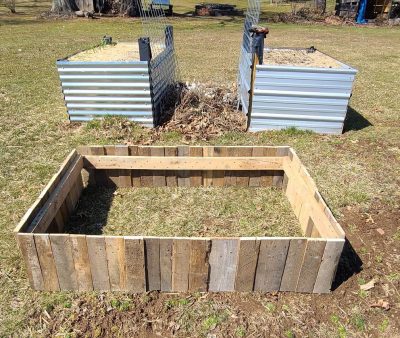
Late winter/early spring is a fantastic time for pruning trees and shrubs in the landscape. It’s ideal because there is great visibility, and the cooler temperatures prevent disease and insects from taking advantage of fresh wounds. You want to make sure you’re pruning correctly, for the species and purpose of the trees and shrubs in your landscape – so do your homework! As a rule of thumb, roses, hydrangeas, and some hardy perennials tend to appreciate a later pruning and can vary between types within the species, so stay aware of what you have on your property to ensure success!
“But when do I get to play in the dirt?” That's next! For our outside plants, think about dividing perennials. Divisions at this point in the year make the plants much easier to handle for the gardener. Moving your plants now gives them a chance to “wake up in place” this spring. You will reduce concerns with transplant shock when you move plants ahead of their spring flush and our summer heat.
Indoors, stepping your seedlings up into larger containers gives them a little more breathing room as we wait for the season to start. Only transplant seeds when they’ve started to show 2-3 sets of true leaves and keep in mind that different species can have different needs. If you excitedly started your tomatoes too early, and now notice leggy stems, try transplanting them in plastic cups and burying them all the way up to their first couple sets of true leaves. They will put out even more roots along that covered stem and be even better prepared when you put them in the garden this season!

There are still plenty of projects that can be done while we wait for spring to come! If you have questions on spring garden projects or any other gardening topic, feel free to contact us, toll-free at the UConn Home & Garden Education Center at (877) 486-6247, visit our website at www.homegarden.cahnr.uconn.edu or contact your local Cooperative Extension Center.
Celebrate the Year of the Squash – 2024
Celebrate the Year of the Squash – 2024
By Dawn Pettinelli, UConn Home & Garden Education Center
Tomatoes and peppers certainly have a wide and varied selection of species, cultivars and varieties but I think squash beats them both out when it comes to sizes, shapes, colors and uses. Perhaps that’s one reason why the National Gardening Bureau decided to make 2024 the year of the squash.
Squash is an ancient crop possibly grown as long as 10,000 years ago in Central and South America. The name ‘squash’ was derived from a Narragansett word, ‘askutasquash’ meaning eaten uncooked or raw. All squash – summer squash, winter squash, pumpkins and gourds – belong to the Cucurbitaceae family. Vining types were included as one of the three sisters (corn, beans & squash) in indigenous plantings as each provides a benefit for the other two plants.
Not only are squash easy to grow but many types are a great source of vitamins, minerals and carotenes. Three main groups of squash are commonly found in home gardens. Cucurbita pepo includes zucchini, summer squash and spaghetti squash varieties all with a soft, edible shell and seeds. These do not store well and are typically consumed within a few days of picking.
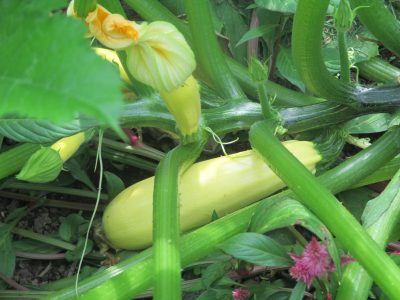
C. maxima is a large group with pumpkins and easily recognized winter squashes like buttercup, Hubbard, and turban varieties. Mature fruits have tough skins that would be peeled, their seeds are hard but could be enjoyed roasted, and they can store for months.
C. moschata includes butternut, a favorite of many, as well as futsu and a tetsukabuto hybrid. A great feature of this species is that they are resistant to squash vine borer, a pesky moth that lays eggs at the base of plants. Larvae that hatch from the eggs burrow into stems usually to the demise of the plant. I’ve been excited about growing ‘Autumn Frost’ as it has that classic butternut taste, but fruits are only 5 to 6 inches wide and high making it perfect for small families or stuffing.
While you can purchase transplants of both summer and winter squash at many places selling seedlings come spring, there are so many fine, exciting varieties to choose from, I suggest starting with seeds. All varieties of squashes are warm season plants so wait until the soil temperature warms up to at least 65 F. Usually this is around Memorial Day but some years, it might be a week or so earlier. Seeds are planted one-half to 1 inch deep.
Like most vegetables, squash prefer a sunny site, well-drained soil fortified with organic matter, a soil pH in the mid 6s and adequate amounts of water during the growing season.
Depending on how large your garden is you may want to plant squash in rows or in hills. A hill is just a planting of 3 to 5 seeds. It does not need to be mounded. Many gardeners prefer the hill approach as some squash plants can get quite large and this saves some room. Personally, I like to plant one seed each of a green, a yellow, and a white cultivar of zucchini in a single hill for good looks and good eats. Another reason for planting in a hill is that the squash varieties that are susceptible to the squash vine borer could be kept under row cover until the borer season is over, usually around July 4th.
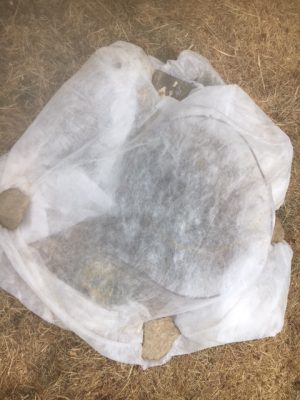
Usually, your zucchini and other summer squash start maturing about 50 days after they have germinated. Winter squash and pumpkins will take 80 to 105 days to mature. How quickly the summer squash grow is one of the wonders of nature. Be sure to check plants every 2 or 3 days and pick fruit when small and less seedy.
Most squash are monoecious which means male and female flowers are produced on the same plant. The male flowers are produced first and held on long stems to attract pollinators. Female flowers are closer to the crown and have mini-fruits at their base. It takes several visits from bees for pollination to occur. Fruits that are incompletely pollinated will shrivel and die. One golden zucchini, ‘Easy Pick Gold II’ is parthenocarpic, which means fruits can develop without fertilization.
Powdery mildew is a very common disease of cucurbits. Look for varieties labeled as resistant or plan on using low toxic control sprays such as neem oil, potassium bicarbonate or Serenade™.
As you’re planning this year’s vegetable garden and purchasing seeds, give a few different squash a try. If you have questions on growing squash or on other gardening topics, feel free to contact us, toll-free, at the UConn Home & Garden Education Center at (877) 486-6271, visit our website at www.homegarden.cahnr.uconn.edu or contact your local Cooperative Extension center.
Prune Now for Beautiful Summer Trees
Prune Now for Beautiful Summer Trees
By Marie Woodward, UConn Home & Garden Education Center
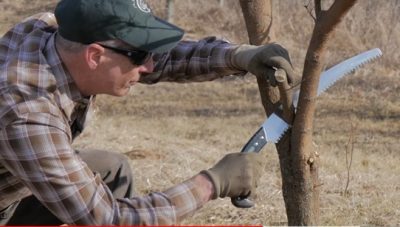
Winter is a great time for gardeners to plan for their next growing season. Many think that planning can only be done inside. Not so. Now is an ideal time to prune deciduous landscape trees. The absence of leaves gives a clear view of the canopy above and allows for a clear assessment of a tree’s structure and any problems that may be present. In addition, there are no pests present in winter, and disease spread will be slowed by the cold weather. But before heading outside with those loppers and pruning saws, there are a few important things to know and consider.
It's important to understand the tree’s anatomy. A typical deciduous landscape tree will consist of three main parts: the leader, the scaffolding branches and the lateral branches. The leader is the dominant vertical branch of the tree. This is easily spotted as the straight, most upward growth from the trunk. The leader is the tree’s most important branch, crucial for the tree’ structure, photosynthesis, and even distribution of nutrients. Scaffolding branches emerge from the trunk and the leader to make up the canopy of the tree. Secondary branches that grow from the scaffold branches are called lateral branches. Once you understand the basic structure of the tree, it’s much easier to successfully prune it.
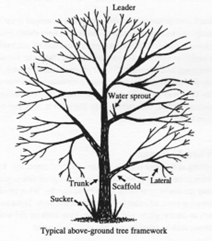
Photo from Virginia Cooperative ExtensionFirst, assess the tree. What species of tree is it? That will reveal its natural structure, something your pruning should ideally strive to support. Note though, that proximity to buildings or human activity nearby is likely to influence your pruning strategy (keeping scaffolding branches clear of buildings, for example, or making sure people can walk under the lowest branch?)
Locate the leader of the tree and look for problem branches. Dead, diseased, damaged, or crossing branches should be pruned first. When pruning dead or diseased branches, make cuts into healthy wood, well below the affected area. It’s also a good idea to disinfect tools between cuts to help prevent the spread of disease. (A 10% solution of bleach to water works well.)
After the tree’s diseased, damaged, or crossing branches are pruned, look for lateral branches that are trying to compete vertically with the leader. They can draw energy away from the leader and sap the tree’s vigor. Usually, there is no need to remove all of a competing branch. Just pruning the vertical portion back to the scaffold branch should be sufficient. This will slow the competitor branch’s rate of growth, allowing the leader to dominate.
When pruning a scaffold branch, it is important to cut outside the branch collar. That is the swollen area at the base of the branch, where it joins the trunk. Make the cut outside the branch collar at a 45-to-60-degree angle to the trunk and leave it alone to heal naturally. There is no need to coat or cover cuts. Doing so could prevent the wound from healing and might seal in pathogens adversely affecting the health of the tree.
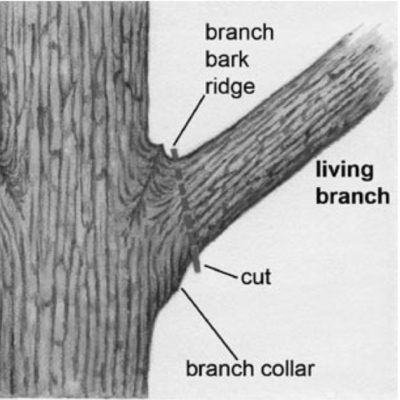
According to Pete Smith, forester and arborist from the Arbor Day Foundation, there are five main factors to consider when pruning trees:
- After pruning, two-thirds of the height of the tree should still have branches and leaves to keep growing in a healthy manner.
- Do not remove more than one third of the total branches in one year.
- Branches attached to the trunk should not be more than one half of the diameter of the main trunk.
- Every pruning cut should be no more than one inch in diameter
- There should be a total of five cuts in a year.
Of course, when pruning a long-neglected tree, it may take a few seasons to be able to apply all five rules, but ultimately, your trees will be healthier and more beautiful if you follow these guidelines.
For questions about pruning or if you have any other gardening questions, contact the UConn Home & Garden Education at (877) 486-6271 or http://www.homegarden.cahnr.uconn.edu/ or your local Cooperative Extension Center.
Tips for the February Gardener
Tips for the February Gardener
By Dawn Pettinelli, UConn Home & Garden Education Center
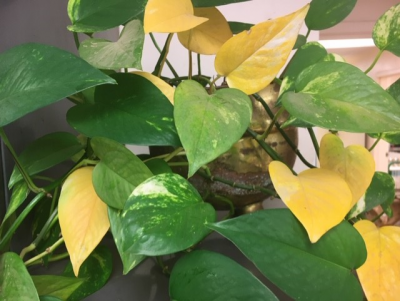
February is a tough time for gardeners. Days are getting longer but the cold temperatures, and in many cases, snow, are keeping us inside. This is a good month to provide houseplants with a little TLC before the weather warms and the gardens beckon.
If possible, bring your plants one by one to the kitchen sink. Give them a thorough grooming by removing any dead or off color leaves. Trim back wayward or undesirable growth. Then give them a good rinsing under the faucet or use a wet cloth to wipe dust off of their leaves. For plants with hairy leaves, like African violets, a soft brush could be used to clean their leaves. Wash their saucers out before setting plants back.
Plants that have outgrown their pots can be repotted at this time. Usually, plants would be moved up to a pot that is an inch or 2 wider. Loosen or trim roots if they are growing in a circle or very dense. An all-purpose potting mix can be used for most plants but specialized mixes for plants like cacti and African violets are also available.
Your amaryllis has probably finished blooming by now. Cut off any spent flowers. Some people like to leave the stem until it yellows as it can photosynthesize but I generally remove the whole stalk after flowering. If you want plants to rebloom next year, the foliage needs light, water and nutrients to grow. Set your plant in a bright location and fertilize monthly starting in March. Plants can be moved outdoors after the danger of frost has passed either in their pots or set them into the ground in a part shady spot. Bring inside in mid-October and let the bulbs go dormant in a dark, warm area for about 8 weeks and then repot for another season of striking trumpet-shaped blooms. Some cultivars do not require a dormant period.
Check on any tender bulbs that you have in storage. Dahlias and tuberous begonias can shrivel if they dry out too much. They are usually stored in some barely moistened peat moss or wood shavings. Sprinkle with a little water if they are on the dry side. Also, this would be a good time to check on any winter squash, potatoes or other vegetables that you’ve been keeping. Use them up before they spoil.
Time spent perusing garden catalogs, either in print or digital format, is a great way to get through cold, winter days. When making out a seed order, don’t forget to note what seeds you have leftover from last year. Most seeds retain their viability for at least a year. It’s always a good idea to plan out the vegetable garden so you know what’s going to be planted where, and when. Last frost dates for your area can be found at: https://garden.org/apps/frost-dates/. The UConn Master Gardener program is offering a Garden Journal with tips on how to plan and maintain your flower and vegetable gardens and plenty of room for you to make notes. To order go to: https://mastergardener.uconn.edu/2024/01/30/garden-journals-available/.
Most of us recognize the benefits of buying local when it comes to produce and other Connecticut grown products but did you know we have at least 5 seed companies in Connecticut. They include Select Seeds (www.selectseeds.com), the Chas. C. Hart Seed Co. (www.hartseed.com), the Heirloom Market at Comstock Ferre selling Baker’s Creek Heirloom Seeds (www.heirloommkt.com), John Scheppers Kitchen Garden Seeds (www.kitchengardenseeds.com), and New England Seed Company (www.neseeds.com). Be sure to see what they have to offer either online or at various retail locations.
If you need a floral fix to get you through to spring, stop by the CT Flower and Garden Show at the Convention Center in Hartford, Feb 22 -25. Visit the UConn Home & Garden Education Center’s booth for a free pH test (bring a half cup of soil) and answers to your gardening questions. A blooming time can also be had at Elizabeth Park’s Greenhouse Bulb and Plant Show, March 1 – 9. Since spring can’t be here soon enough, you’ll just have to go to where the flowers are blooming!
For your gardening questions, feel free to contact us, toll-free, at the UConn Home & Garden Education Center at (877) 486-6271, visit our website at www.homegarden.cahnr.uconn.edu or contact your local Cooperative Extension center.
Connecticut Barns
Connecticut Barns
By Pamm Cooper, UConn Home & Garden Education Center

Venturing out in the rural Connecticut landscape, there are reminders of the agricultural age that dominated the landscape. Farms that once used their land for raising livestock and growing crops have either been abandoned or slashed in size to accommodate new homes. Sometimes all that remains of the original farm property is the farmhouse and a barn or two. Those barns remain interesting to me architecturally- because of the quality of materials and workmanship that went into building them, and in a nostalgic way, because I grew up in dairy country in New York state. I used to play in barns, and I wish I had had more of an interest in the structure of the barns when I was so close to them, inside and out.
One of the more familiar barns in Connecticut are the post and beam structures. Nathan Hale Homestead in Coventry features one built in the 1760’s. This barn is on the National Register of Historic Places in Connecticut, and it is built in the English/ New England hybrid style which normally had a gable roof and vertical sheathing. The historic Jacobson barn on the UConn campus also has a post and beam structure.
The English barn is a simple building with a rectangular plan, a pitched roof, and a door or doors located on one or both, of the long sides of the building. English barns featured three distinct bays, the center one being for the threshing of grain, and the side bays used for livestock and hay storage. Footings and foundations were typically made of stone, an abundant resource in Connecticut landscapes, and the stones normally had no mortar. Doors on English barns were hinged and swung open.
New England barns are usually a type of bank barn, built into the side of a hill giving ground level access to one side, but a ramp or rarely a bridge were used to access the doors. Roof and eave overhangs were typically one foot to protect walls from rainwater. Ventilators and cupolas were added to some barns in the 19th century to reduce moisture build-up. Some barns had stairs, but most featured ladder access to the second floor. New England style barns normally had a gable roof and vertical sheathing.
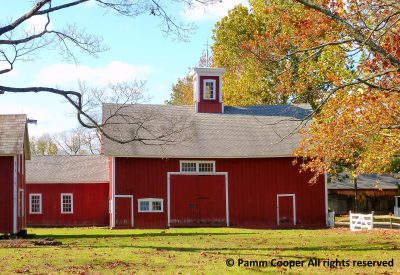 A picturesque red barn with white trim and a cupola is located on Main Street, South Windsor, and it is an example of an English/ New England hybrid style barn. The New England style barn, built after 1830, could stand alone or be connected to other farm buildings and often had an off-centered end wall entrance for wagons.
A picturesque red barn with white trim and a cupola is located on Main Street, South Windsor, and it is an example of an English/ New England hybrid style barn. The New England style barn, built after 1830, could stand alone or be connected to other farm buildings and often had an off-centered end wall entrance for wagons.
The Morse Farm barn in Scotland is listed on the National Register, the State Historic Resource Inventory, and the State Register. This carriage house style barn has one and one half stories and features a gambrel roof design. A gambrel roof has two distinctive two slopes on each side, with the upper slope pitched at a shallow angle and the lower slope at a steeper angle. This allowed for more headroom when working on the upper floor. This barn had a combined use as a stable and carriage storage.
On Valley Falls Road in Vernon, the historic red barn, built between 1875 and 1920 features a gambrel bank style and with a cupola and a timber frame structure. A milking stable was in the basement, featuring the typical cement floor and manure gutters and whitewashed walls. It is listed in the Local Historic District and the State Register.

Gilbert Road in Stafford features an English Bank style of barn. Not too far away, on 425 Old Springfield Road in Stafford there is the Greystone Farm English style barn that features exterior siding of gray fieldstone, and flush board and vertical siding on other sections. The roof is a gable type.
The Sheridan Farmstead (c. 1760) on Hebron Road in Bolton is listed on the State Register of Historic Places and features a gentleman’s barn built in 1900. A gentleman’s barn had a dual purpose as a weekend retreat and a working farm. The white extended English bank barn features a stairway to the upper level, hay chutes, a brick chimney, rolling doors, an earthen ramp and horse stalls on the ground level.
There are many more barns, both old ones and newer ones, that are still interesting and useful. To those familiar with the past, barns offer a glimpse into the past, and maybe the present, as well. Tobacco barns, for example, although dwindling in number, are still very much a part of Connecticut’s past and present.
To locate barns on the Connecticut State Register of Historic Places, visit the website on this link- https://connecticutbarns.org/state-register. For your gardening questions, feel free to contact us, toll-free, at the UConn Home & Garden Education Center at (877) 486-6271, visit our website at www.homegarden.cahnr.uconn.edu or contact your local Cooperative Extension center.
Hearts for Valentine’s Day
Hearts for Valentine’s Day
By Dawn Pettinelli, UConn Home & Garden Education Center
While there’s always the traditional Valentine’s Day gifts of flowers and candy, why not give that special someone a plant with heart-shaped leaves that will likely last much longer than chocolates or bouquets. There are actually a number of plant species to choose from with some being quite easy to grow.
Perhaps the cutest, as well as the easiest is the Sweetheart hoya (Hoya kerrii). Hoyas are a very slow growing, vining plant with stems that may reach 13 feet in length. Typically, it is grown in a wreath form or on a trellis. The pink or white flowers are fragrant but not produced in great abundance.
While this plant has the most adorable heart-shaped leaves, the ones that are sold as a single leaf in a pot will, in most cases, remain as a single leaf. Unless a piece of stem was left attached to the potted leaf, the plant is not able to initiate new leaf or stem formation. This makes for a simple plant to care for, however. Keep your Sweetheart hoya leaf in a bright sunny spot with temperatures in the 60 to 80 degree F range and water when dry.
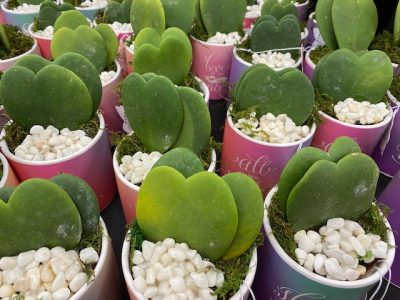
Another plant for small spaces with charming marbled, heart-shaped leaves is the String of Hearts (Ceropegia woodii). While the dainty individual stems can grow 12 feet long, they can be trimmed to keep the plant compact. The grey-green leaves are small, only about ½ inch in diameter. String of Hearts is a succulent best grown in a potting mix labeled for cacti and set in bright, filtered sunlight. Let plants dry out slightly between waterings. Keep away from drafts and note that plants may go dormant if the temperature falls below 60 F.
Philodendrons (P. hederaceum) have been grown for ages and with good reason. These tough, vining plants with heart-shaped leaves tolerate the lower light levels found in many homes. Stems may grow 3 feet or longer and plants are best suited to a hanging basket or trellis. Exciting newer cultivars such as ‘Brasil’, ‘Cream Splash’ and ‘Rio’ offer variegated leaves. Grow plants in bright, indirect light and avoid overwatering. Trim plants if they overgrow their bounds.
More recently, anthuriums with their flashy colored spathes in red, orange, pinks, and purples have been livening up the holiday plant scene. Both the spathes, which are modified leaves, and the true glossy, green leaves are shaped like hearts. Plants grow to about 16 inches high and if content will produce long-lasting colorful spathes several months of the year. Tiny flowers are on the tail-like spike that emerges from each spathe. Anthuriums also appreciate bright but indirect light, a well-draining, acidic soilless potting media and to be kept moderately moist.
Similar in care to anthuriums, syngoniums have heart-shaped leaves and new varieties come in various shades of pink, purplish red and even variegated cultivars. Syngoniums are evergreen climbers but can be maintained as a shrubby houseplant if trailing stems are removed. As the plant ages, leaves become more arrow-shaped. Plants enjoy warmth and humidity and do best in moderately moist potting mixes and in bright diffused light.
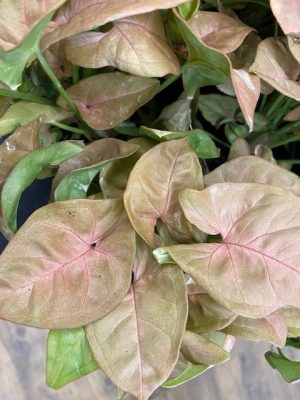
A little harder to find but worth the search is the Heart Fern (Hemionitis arifolia). Like many tropical ferns, it prefers indirect light in a warm, humid location. Plants may reach 10 inches tall and wide. The leaves are dimorphic, with the sterile fronds being heart-shaped and the fertile ones resembling arrowheads. Unlike most ferns, the foliage is thick and leathery. Being an epiphyte, plants should be grown in a light, airy potting mix and kept moist at all times.
Lastly, there are varieties of English ivy (Hedera helix) with heart-shaped leaves. ‘Sweetheart’ and ‘Heart’ are two common cultivars. Blue-green leaves form along stems that can be trimmed to any length. Grow as a hanging basket or in a decorative pot. English ivy enjoys cooler temperatures and bright but diffused light. East or north facing windows are ideal locations.
This year, mix it up a little for Valentine’s Day and give the heart-felt gift of a plant with heart-shaped leaves. Do note that some of the above plants are toxic if consumed so should be kept away from children and pets.
If you have questions about these plants or if you have any other gardening questions, contact the UConn Home & Garden Education at (877) 486-6271 or www.homegarden.cahnr.uconn.edu or your local Cooperative Extension Center.
Watch Out for These Nutrient Deficiency Symptoms
Watch Out for These Nutrient Deficiency Symptoms
By Haiying Tao, Ph.D., UConn Home & Garden Education Center
Plants need at least seventeen essential nutrients to complete their life cycles. Scientists group these essential nutrients into macronutrients (carbon, hydrogen, oxygen, nitrogen, potassium, phosphorus, sulfur, calcium and magnesium), which are required in large quantities and micronutrients (zinc, iron, copper, boron, manganese, chlorine, molybdenum and nickel) which are required in small quantities. Sufficient amounts of these nutrients are required in order for plants to produce well. If there is a deficiency of any essential element, yield and quality can be reduced. Alternatively, too much of a nutrient can be toxic to plants. Diagnosing nutrient deficiencies and toxicities is important for both growers and gardeners to ensure optimum harvests.
When low in an essential nutrient, plants exhibit distinct visual symptoms, which often allows us to distinguish which nutrient is deficient. A first step in diagnosing nutrient deficiencies is to describe what the symptoms look like. Symptoms caused by nutrient deficiencies are generally grouped into five categories: 1) stunted growth; 2) chlorosis or yellowing; 3) leaf spots; 4) purplish-red coloring; and 5) necrosis or death of plant parts.
The next step is to identify whether the deficiency symptoms appear on older (lower) leaves or younger (upper) leaves first. If the deficiency symptoms appear on older leaves first, then the deficiency symptoms are possibly caused by one of the nutrients that are mobile in plants, such as nitrogen, phosphorus, potassium, magnesium, chlorine, or molybdenum. In contrast, deficiency of nutrients that are immobile (calcium, sulfur, boron, copper, iron, zinc, manganese, nickel), the symptoms first appear on younger or upper leaves.
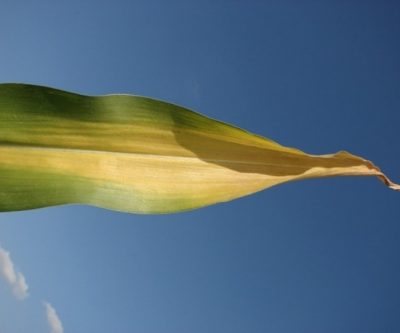
Nitrogen deficiency symptoms include yellowing of the lower leaves (chlorosis), stunted and slow growth, and death of older leaves in severe cases. Nitrogen deficient plants will mature early, and the crop quality and yield are often reduced.
Phosphorus deficiency symptoms occur in the older leaves first and typical deficiency symptoms are purpling of leaves and leaf margins and stunted growth. Plants that are deficient in phosphorus are generally weak and maturity is delayed.
Potassium deficiency symptoms first appear on older leaves. Typical deficiency symptoms are yellowing and necrosis of the leaf margins. When potassium deficiency is severe, older leaves turn yellow with brown dead tissue around the edges, but the upper new leaves may stay green. Sometimes one may confuse potassium and nitrogen deficiency because both show yellowing on older (lower) leaves first. The difference is that the chlorosis starts from the tip and progresses along the ribs of the leaf if nitrogen is deficient, but the chlorosis starts from the tip and progresses along the edge of the leaf if potassium is deficient.
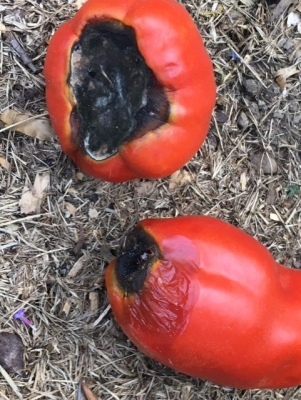
Another nutrient that is commonly found deficient is calcium. Typical calcium deficiency symptoms are poor leaf expansion, curling followed by necrotic patches in the young leaves. Calcium deficiency can cause misshapen fruit and aborted buds. If you find the tip of tomatoes or peppers rotting, cavity spot in carrots, and black heart in peanuts and celery, it’s likely the plants are calcium deficient. However, don’t hurry to apply calcium fertilizers. Check on other stresses such as drought because lack of moisture in the soil can lead to insufficient uptake and transportation of calcium within plants, which leads to symptoms similar to calcium deficiency.
In sandy and low organic matter soils, sulfur deficiency can occur. Typical sulfur deficiency symptoms are reduced growth rate with plants becoming stunted and thin stemmed. In cole crops (such as cabbage, broccoli, etc.), discoloration appears in younger leaves first. Symptoms may include light green or yellow leaves, a reddish coloration on the undersides of leaves as well as leaves that are cupped inward.
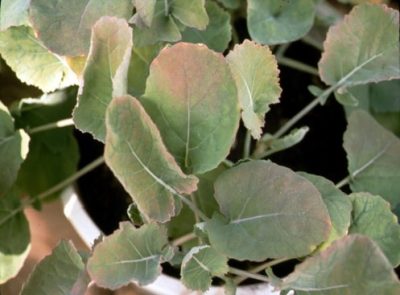
It is not always easy to identify nutrient deficiencies just by looking at a plant because the symptoms of several deficiencies are similar in appearance. Also, more than one nutrient may be deficient. It is not uncommon for other stresses such as disease, drought, excess water, genetic abnormalities, herbicide and pesticide residue injury, insects or salt injury may cause symptoms that are similar to nutrient deficiency. The best way to confirm if you have nutrient deficiency is to test your soil and plant tissue.
For questions on nutrient management in the garden or farm, feel free to contact the UConn Soil Lab at (860) 486-4271. For all your other gardening questions, contact the UConn Home & Garden Education at (877) 486-6271 or www.homegarden.cahnr,uconn.edu or your local Cooperative Extension Center.
Dr. Tao is an Assistant Professor and Soil Fertility Specialist in the UConn Department of Plant Science & Landscape Architecture.
Alluring African Violets Chosen as 2024 Houseplant of the Year
Alluring African Violets Chosen as 2024 Houseplant of the Year
By Dawn Pettinelli, UConn Home & Garden Education Center
This last decade or so has seen a burgeoning interest in houseplants. While this has led to the introduction of some new and exciting species, classic stalwarts are still in demand as evidenced by the National Garden Bureau naming African violet the 2024 Houseplant of the Year. They are from Africa, as their name implies, but they are not related to the violets we commonly encounter in our gardens. These plants were discovered in the mountainous regions of Tanzania and Kenya where they grew in shady, rocky locations.
The first person to successfully send plant material back to Germany where it eventually reached the Royal Botanic Gardens at Herrenhausen was Captain Baron Walter Saint Paul in 1892. This new species of plant was placed in the Gesneriad family and given the Latin name, Saintpaulia ionantha. A number of additional species were described over the next half century. More recently, after DNA analysis, African violets were put in the genus, Streptocarpus.
Regardless of their classification, African violets are endearing plants showering their caretakers with an almost continuous parade of blossoms if properly taken care of. Maybe the most difficult part of growing African violets is deciding which ones to grow. They can be found as miniature, standard, and trailing varieties and there are thousands of cultivars. In fact, the African Violet Society of America (www.africanvioletsocietyofamerica.org) has a Master Variety List of over 16,000 recorded species and cultivars.
Flower color ranges from white to pink, purple, blue, violet as well as bicolored cultivars. They can be single, double or semi-double, ruffled or picoteed. Leaves can be a handsome green, some with burgundy overtones while others can be variegated or mosaic. Whichever type or cultivar of African violet you choose, care is similar.
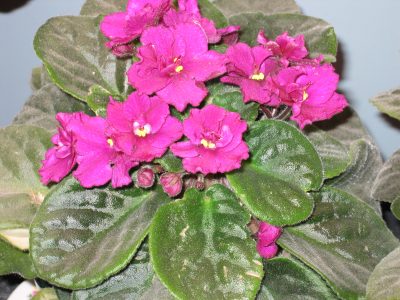
The proper amount of light is key to good flowering. Plants need lots of bright indirect light. East windows are usually ideal as they get morning sun. If only a west or south facing window is available, filter the light with sheers. African violets do exceptionally well under fluorescent or LED lights. Consider artificial lighting if natural light is limited.
Temperature is also important. African violets mostly thrive in the same temperatures we do, around 65 to 70 degrees F. Place them where nighttime temperatures do not drop below 55 F. This is more likely to be a problem during cold winters when plants are left too close to windows. Often exposure to cold results in the plant starting to wilt. Daytime highs ideally should not exceed 75 F.
When watering your African violets, avoid getting water on the hairy leaves as this may cause spotting. Many African violet enthusiasts choose to water from the bottom. Plants can be grown in special ceramic African violet pots where a well is filled with water, and it keeps the root ball just moistened enough. Plants can also be watered using a watering can with a long narrow spout so water can be directed at the potting mix and not land on the leaves. The potting mix should stay moderately moist at all times but should not be saturated. If watering from the top and excess water drains into a saucer, be sure to empty it. Soggy soils promote crown and stem rots.
African violets like a very well-draining potting mix rich in organic matter with an acidic pH. One can purchase specialty mixes for African violets, or a standard soilless commercial potting mix will do. While plants do need to be fertilized during their period of active growth, which is usually spring and summer, note if when repotting the mix you are using already contains fertilizer. If it does, don’t start fertilizing until plants start looking a little light in color. If no fertilizer was added to the potting mix, you can use a half strength liquid fertilizer every 2 weeks or so from mid-March until about mid-October.
Plants bloom best when slightly pot-bound. Often the plant can be lifted once a year and then groomed and reset back into its original pot with some fresh potting media or in a slightly larger one. Remove spent flowers to encourage more flower buds to form.
Sometimes cyclamen mites, spider mites or root rots can be a problem so pay attention to your plants and see that they are receiving the proper care. Always isolate new plants for 30 days before introducing to your collection.
For questions about African violets or if you have any other gardening questions, contact the UConn Home & Garden Education at (877) 486-6271 or www.homegarden.cahnr,uconn.edu or your local Cooperative Extension Center.
How to Identify and Treat Salt Damage on Plants
How to Identify and Treat Salt Damage on Plants
Laurel Humphrey, UConn Home & Garden Education Center
From freezing temperatures to blistering winds, the harsh winter elements can pose a challenge for people and plants alike. One common issue many gardeners face during the wintertime is salt damage on plants. While deicing road salts help to ease our troubles by keeping roads, driveways, and sidewalks clear, they only intensify winter damage on the ecosystems and plants nearby. As a country, the U.S. is estimated to apply about 20 million tons of salt per year for public safety on roadways. The most common form of deicing salt used to keep ice from forming on the roads is sodium chloride, or rock salt, which can be very damaging to vegetation. Deicing salts contribute to the damage and dieback of landscape plants each year, however there are steps one can take to identify salt injury and minimize its effects.
What are Symptoms of Salt Damage in Plants?
When deicing salts inevitably wash off the roads, they threaten plants both directly through contact with the foliage, as well as indirectly by changing the soil chemistry. In what is known as “spray zone” injury, salt water collects on plant foliage and enters the plant cells directly. This type of salt injury results in discoloration beginning at the margins of the plant and may eventually lead to premature leaf or needle drop. Salt spray can also dry out bud scales, exposing the developing leaves and flower buds to reduce growth later in the spring. Spray zone injury often produces a distinct pattern of damage, where symptoms are restricted to foliage facing the roadside and increase in severity as plants are found closer to the road.
Another way plants are affected by road salts is when runoff salt water dissolves in the soil and is taken up by plant roots. Within the soil, sodium chloride breaks down into ions that compete with the other nutrients plants need to survive. As a result, plants take in more of the harmful sodium salts and less of the beneficial nutrients they require. Plants tolerate small amounts of salt naturally, but toxic concentrations can result in symptoms of wilting, scorch, and burn. Overall, deicing salt exposure causes symptoms similar to drought and root damage in plants, such as tip browning, bud death, stem dieback, stunted growth, marginal burn and discoloration, and even tree death. These effects may vary depending on the plant species and degree of exposure, with salt applications in late winter thought to be most damaging to plants and less likely to be leached away from roots.

How can Road Salt Injuries be Managed?
In order to minimize the harmful effects of road salts and be sure your plants will make it to see a healthy spring, there are some steps you can take to reduce salt injury. One obvious option is to limit the use of road salts when possible, especially near lawns and landscapes. This can be done by mixing salt with other materials such as sand or sawdust to help maintain road traction, as well as choosing other salt options like calcium chloride that are less harmful to plants, although more expensive. Gardeners can also protect their plants from salt damage by covering them with materials like wood or burlap, and being careful to plant salt tolerant species near roads and sidewalks. Trees such as hedge maple, paper birch, and Northern red oak are more tolerant to salt exposure than sensitive species including red maple, boxwood, and Eastern white pine.
While it is not always possible to prevent salt damage from becoming an issue during the winter months, other management strategies can be used to treat salt injury. If you do identify exposure to salt damage in your landscape, be sure to wash salts off plant foliage as soon as possible. Prevent snow piles, sand, and runoff from building up near sensitive plants, and maintain healthy soil salinity levels through the addition of organic matter. The most effective way to minimize salt damage is by leaching salts away from the plant roots. Apply fresh water often to flush salts down through the soil when the ground is not frozen, and plant roots should be less vulnerable to the toxic effects of road salts.
Laurel Humphrey is a student employee working with the Plant Diagnostic Lab and Home & Garden Education Center. For questions on road salt or if you have any other gardening questions, contact the UConn Home & Garden Education at (877) 486-6271 or www.homegarden.cahnr,uconn.edu or your local Cooperative Extension Center.
2024 All-American Selections
2024 All American Selection Winners
By Dawn Pettinelli, UConn Home & Garden Education Center
As we usher in the New Year, garden enthusiasts and horticulturists alike eagerly anticipate the unveiling of the All-America Selections (AAS) winners for 2024. The AAS is a prestigious organization that annually recognizes outstanding new varieties of flowers, vegetables, and herbs that have proven their excellence through rigorous trials. Trial gardens were established throughout the United States and even as far north as Canada. New varieties, species or strains of annuals, vegetables and bedding plants are grown and evaluated based on their performance. Two vegetables and 5 flowers were chosen as national winners this year. Those selected as winners are outstanding plants and deserve a trial in your gardens as well.
Broccoli ‘Purple Magic F1’ takes center stage among the vegetable winners. With its striking purple hue and exceptional taste, this broccoli variety is a standout choice for home gardeners. This easy to grow variety is tolerant to heat and stress with tight uniform heads on 30-inch tall plants. Plants should be spaced about 2 feet apart and harvests can begin about 90 days after transplant. Beyond its visual appeal, ‘Purple Magic F1’ offers a nutritious addition to meals, providing both beauty and health benefits to your garden and table.

For those seeking a vibrant addition to their vegetable patch, sweet pepper ‘Red Impact’ is a true gem. ‘Red Impact’ is a Lamuyo type that are typically difficult to grow because of the long time it takes these large peppers to mature to red. The 7-inch long, sweet crispy fruits have thick skins and can be harvested red or green. Plants reach up to 3 feet in height and since there can be 10 to 15 peppers per plant, staking is recommended. The dark red, uniform fruits mature in 90 days from transplant. ‘Red Impact’ is resistant to a number of diseases including tobacco mosaic virus.
In the realm of flowers, ‘Burning Embers’ celosia captures attention with its vibrant pink blooms that contrast well with its striking pink veined bronze foliage. This well-branched, vibrantly colored celosia will add drama and flair to gardens and containers. The very long-lasting flowers hold up well through periods of heat and humidity. The 8 to 9-inch plants can be spaced a foot apart in garden beds and used as edging or massed in groups. No staking or deadheading is necessary. Blooming from late spring through frost, makes ‘Burning Embers’ a standout choice for those looking to infuse outdoor spaces with bold colors and distinctive shapes.
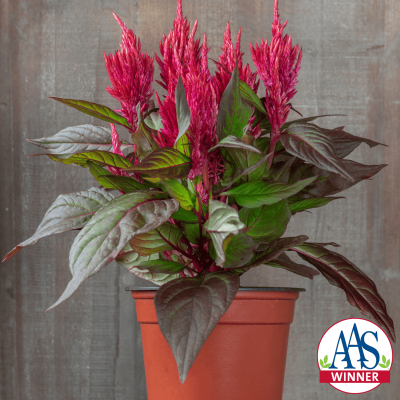
Geranium lovers rejoice. ‘Big EEZE Pink Batik’ is a true show stopper with its large, eye-catching pink blooms that are streaked and spotted with darker pink markings in a batik-like pattern. Upright 18-inch plants are very floriferous with 4 to 5-inch flower clusters. Deadhead to encourage continuous flowering throughout the growing season. Plants do especially well in containers and are vigorous and heat tolerant.
Impatiens ‘Solarscape XL Pink Jewel’ lives up to its name offering an abundance of vibrant pink blooms that will add sparkle to any garden or container. The foot high plants spread out to almost 20 inches so give them room to grow. The single pink blossoms open to almost 3 inches across. Plants do great in containers or in the ground and no staking or deadheading is needed. ‘Solarscape XL Pink Jewel’ will do well in sun to part shade as long as regularly watered. Gardeners will be glad to know plants are resistant to impatiens downy mildew.
With its vibrant, fully double, golden blooms and compact growth habit, marigold ‘Siam Gold F1’ is a reliable choice for borders, edging, or as a cheerful addition to mixed plantings. The 3 to 4-inch blooms are held high and continue throughout until frost if deadheaded. Staking is not needed for the sturdy 20-inch-tall plants that are tolerant of heat, drought and rain. Use the flowers in arrangements to bring a golden glow indoors. Plants are easily started from seed directly sown in the garden after the last frost date or can be started 4 to 6 weeks before the last frost date indoors. Its ability to thrive in diverse conditions makes it a go-to option for gardeners seeking low-maintenance yet stunning floral displays.
The final national winner, Petchoa ‘En Viva Pink’, represents a unique and exciting addition to gardens and containers. This innovative hybrid combines the best qualities of petunias and calibrachoas, resulting in a plant that offers the best of both worlds. Plants are loaded with bright, iridescent pink, 2 to 3-inch, yellow-throated blossoms that stand up to heat, wind and rain. These plants require no staking or dead-heading and at 10 to 16-inches high and wide would be outstanding in hanging baskets, containers or cascading over garden edges.
The 2024 All America Selections national winners represent the pinnacle of horticultural achievement. As we embrace the gardening season ahead, let these national winners inspire and guide your choices for a flourishing and vibrant outdoor space. For your gardening questions, feel free to contact us, toll-free, at the UConn Home & Garden Education Center at (877) 486-6271, visit our website at www.homegarden.cahnr.uconn.edu or contact your local Cooperative Extension center.
2023
- Birds Appreciate Food During Winter
- Gifts for Gardeners
- Mistletoe - Naughty and Nice
- Weird Weather in 2023
- Are Your Plants Zoned for Success
- Calcium For Healthy Plants
- Bad Berries
- To Clean or Not to Clean
- Putting the Garden to Bed
- Hot New Houseplants!
- Goth Gardening Anyone?
- Autumn's Wave
- It's Bulb Planting Time
- Why Are Maple Leaves Turning Brown and Falling Early?
- Mums the Word
- Some Like it Acidic
- September is for Saving Tomatoes
- Warm Wet Weather Leads to Brown Patches
- Green Thumb Secrets
- Create a Compost Pile
- Love Those Lobelias
- Lawn Herbicides Can Damage Your Garden
- Annual Vines
- Bugweek
- July Gardening Chores
- Lavender
- SlugFest
- Late Spring Plant Issues
- Marvelous Mosses
- Watering Woes
- Pretty Parsley
- New Tool for Weeding
- Hanging Baskets
- Vascular Diseases
- Spring Lawn Care Tips
- Sensational Celosias
- Plant A Pollinator Garden
- Chloride, a Necessary Plant Nutrient
- Tradescantias are Terrific
- Volumes of Violets
- Seed Starting Tips
- Tool maintenance
- Low Snow Cover
- American Kestral
- New England Cottontail Losing Ground
- Fertilizing with Manure and Compost
- All America Selection Winners for 2023
- Banish Bagworms
- Year of the Amaryllis
- Turning Houseplants into Homeplants
2022
- Feed the birds
- Holiday Happiness is Always Green
- Hot Tips for Burning Wood During a Cold Winter
- Gifts for Gardeners
- Grow Fragrant Paperwhites
- Red-tailed hawk
- Checklist for November Gardeners
- Fall is a Great Time to Soiltest
- Sweet Potatoes, Sweet Harvest
- Root Rot Pathogens Love Wet Weather
- Corn Mazes
- Native, Invasive, Non-Native – Are You Confused?
- Amaranth
- Bringing the Outdoors In
- Preserving Herbs
- Spotted Lanternfly
- Little Bluestem Big Rewards
- Heat Drought Stressed Plants
- Orange Monarch Butterflies Red Listed
- Soils Supply Plants with Water
- What's Wrong With My Plant
- Beech Leaf Disease
- Daylilies are Delightful
- Tomato Troubles
- Watch Out for Ozone Damage
- Dahlia Topping
- Toads are Terrific
- Consider a Cutting Garden
- Help for Home Gardeners
- Peppers - Pick a Peck
- 2022 is the Year of the Gladiolus
- New Hope for Chestnuts
- Planting Fruit Trees
- Manage Nitrogen Wisely
- Native Phlox Colors Spring Landscape
- Black Spot of Roses
- Trees Shrubs Need Nutrients Too
- Time to Till
- Soil pH & Nutrient Availability Mourning Cloak Butterfly
- Mourning Cloak Butterfly
- Forcing Branches for Early Color
- Garden Trends for 2022
- Scout now for Fireblight
- 2022 is Year of Peperomia
- 5 Seed Starting Mistakes
- Seed Catalog Updates
- All America Selection Winners for 2022
- Winter Evidence of Insect Pests
- White Footed Mice
- Roses for Valentine's Day
- Helpful Houseplant Hints
2021
- Christmas Rose - Not a Houseplant
- Start a New Holiday Tradition
- Poinsettias
- Selecting and Caring for Christmas Trees
- It was a Berry Good Year
- Wicked Weeds
- Mulch Madness
- Growing Figs in New England
- Lilacs Make for a Lovely
- Spring Spring Lawn Tips
- Spring Lawn Tips
- Edible Flowers
- Caring for Springtime Holiday Plants
- Vegetable Vernacular
- 2021 Is the Year of the Hyacinth
- Happiness is Growing
- CT State Bird - A Sure Sign of Spring
- March Flowers, Birds and Other Things
- Make Room for Mushrooms
- Plant a Pollinator Garden
- Say It With Flowers
- Spring Into Seed Starting
- Petunias are Super for Containers and Flower Beds
- DIY Greenhouse Cabinet for Happy Houseplants
- White-Breasted Nuthatches
- Native Pines
- Selecting and Caring for Christmas Trees
- It was a Berry Good Year
- Welcome Juncos
- Fall Into Spring
- Redtail Hawks
- Now is a Great Time to Soil Test
- Fall Leaves
- Make History - Plant Garlic!
- Autumn Mushrooms
- Fall for Anemones
- The Story Behind Jack O'Lantern
- Okay to Resume Feeding Birds
- Variety is the Spice of Life
- Fall is the Best Time to Plant Peonies
- Sumac - Worthy for Landscapes?
- Late Summer Lawn Care Tips
- Blueberries are a Tasty Treat
- 2021 is Year of Sunflower
- Slugging it Out
- Moist Conditions Make for Many Mosquitoes
- More Peas Please
- Common Cucurbit Problems
- Watering Plants
- Plant Reversions
- Sawfly Pests in the Landscape
- Magnificent Mountain Laurels
- Sustainable Pest Control
- Catnip Anyone?
